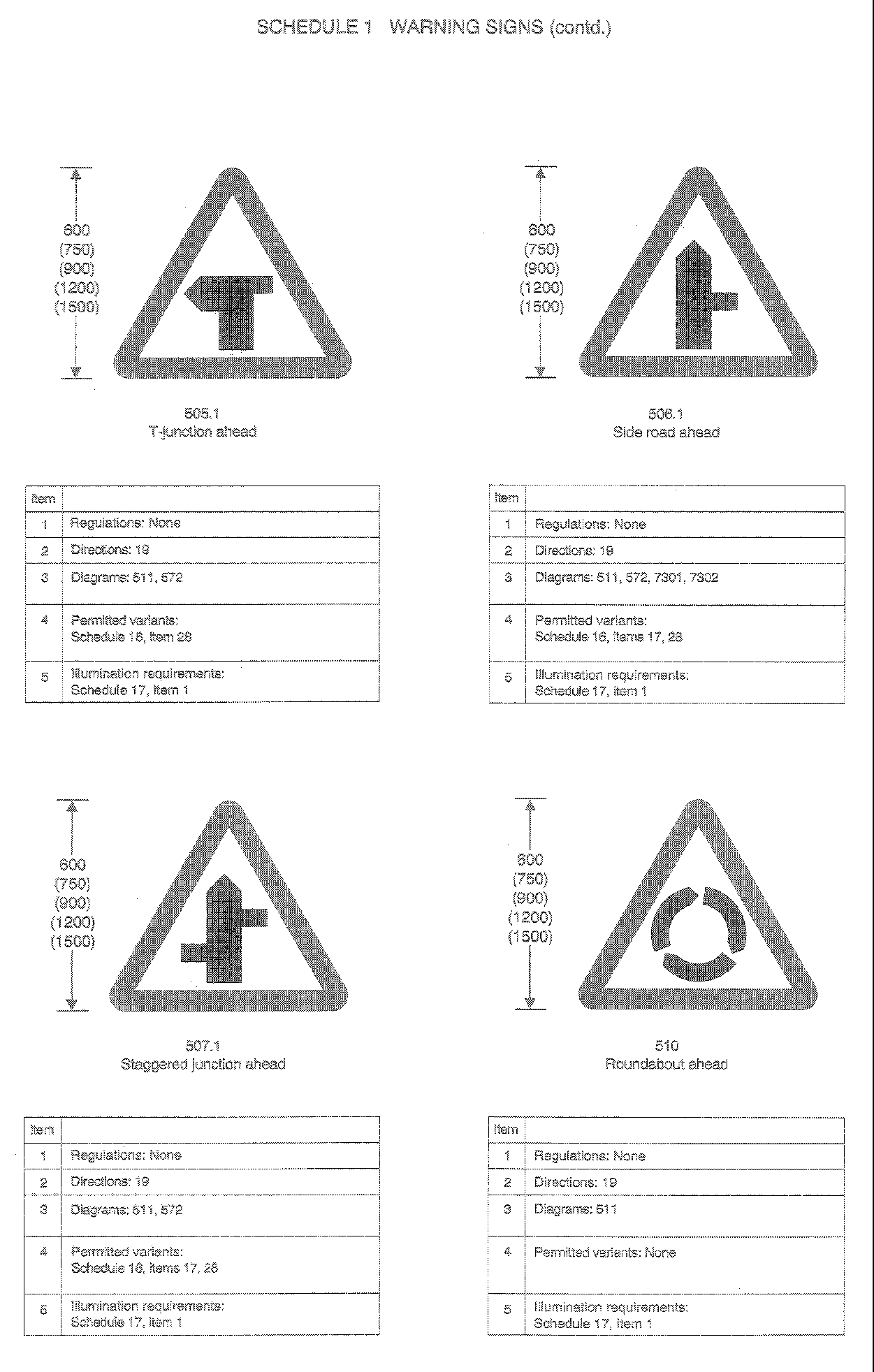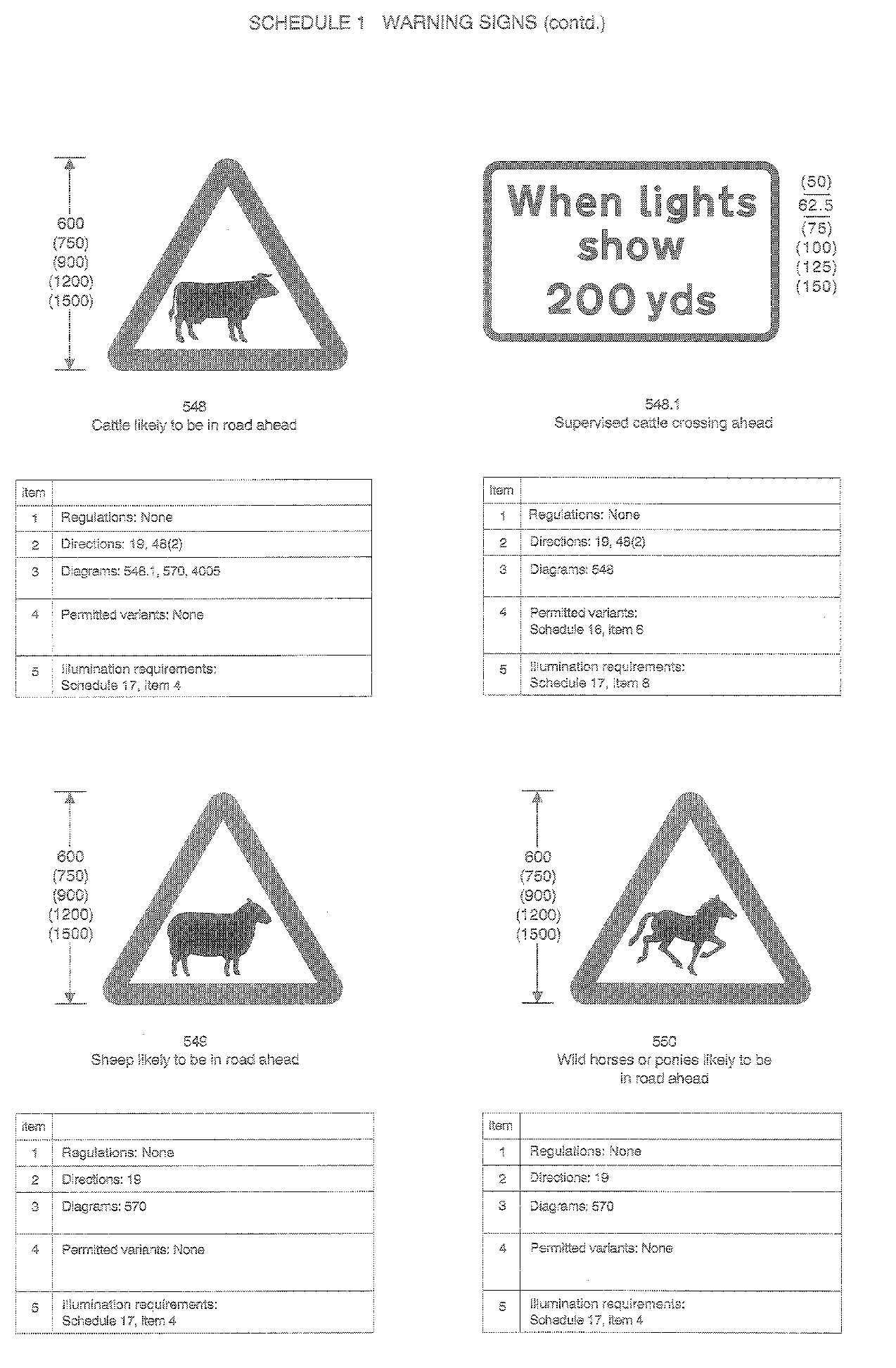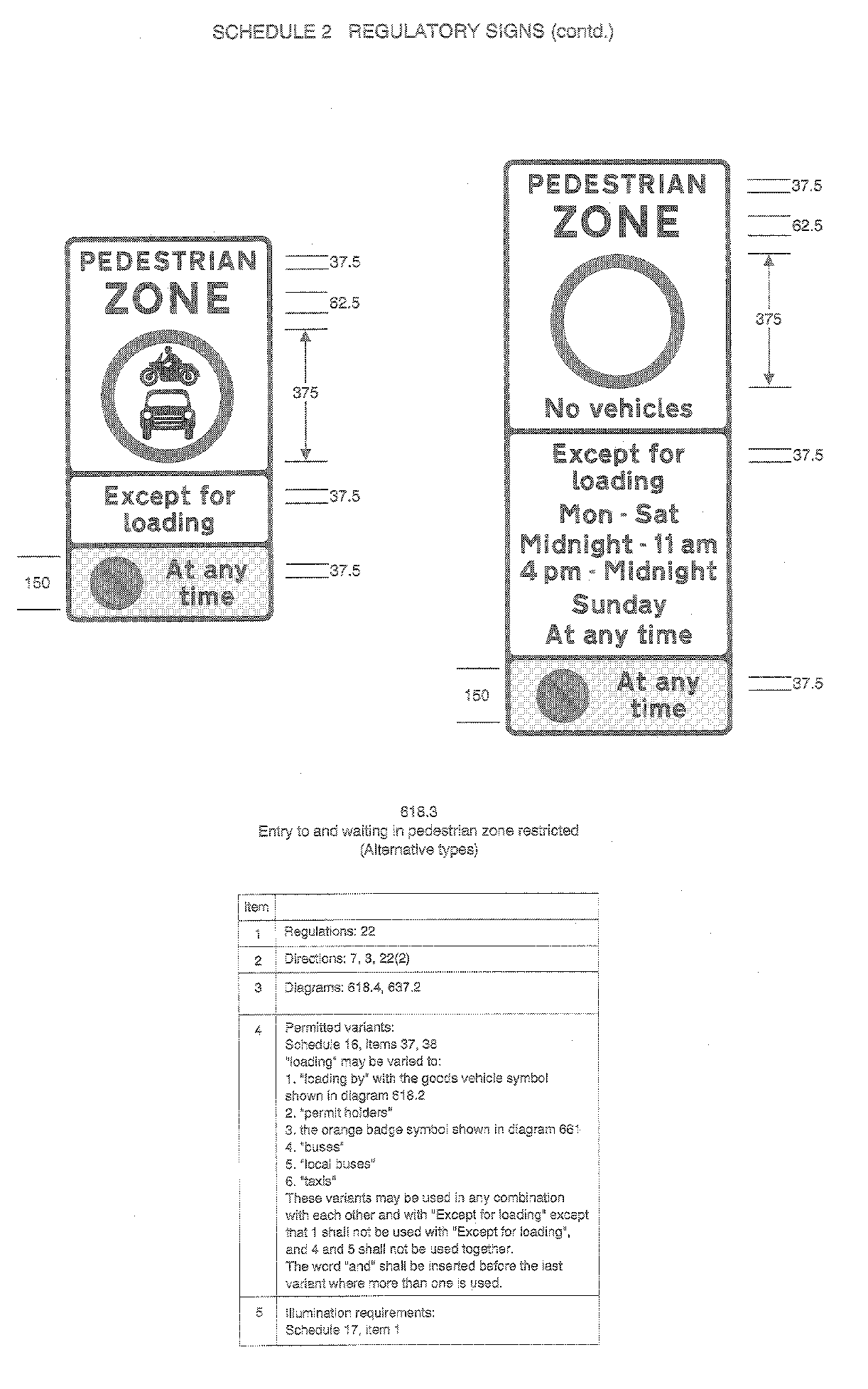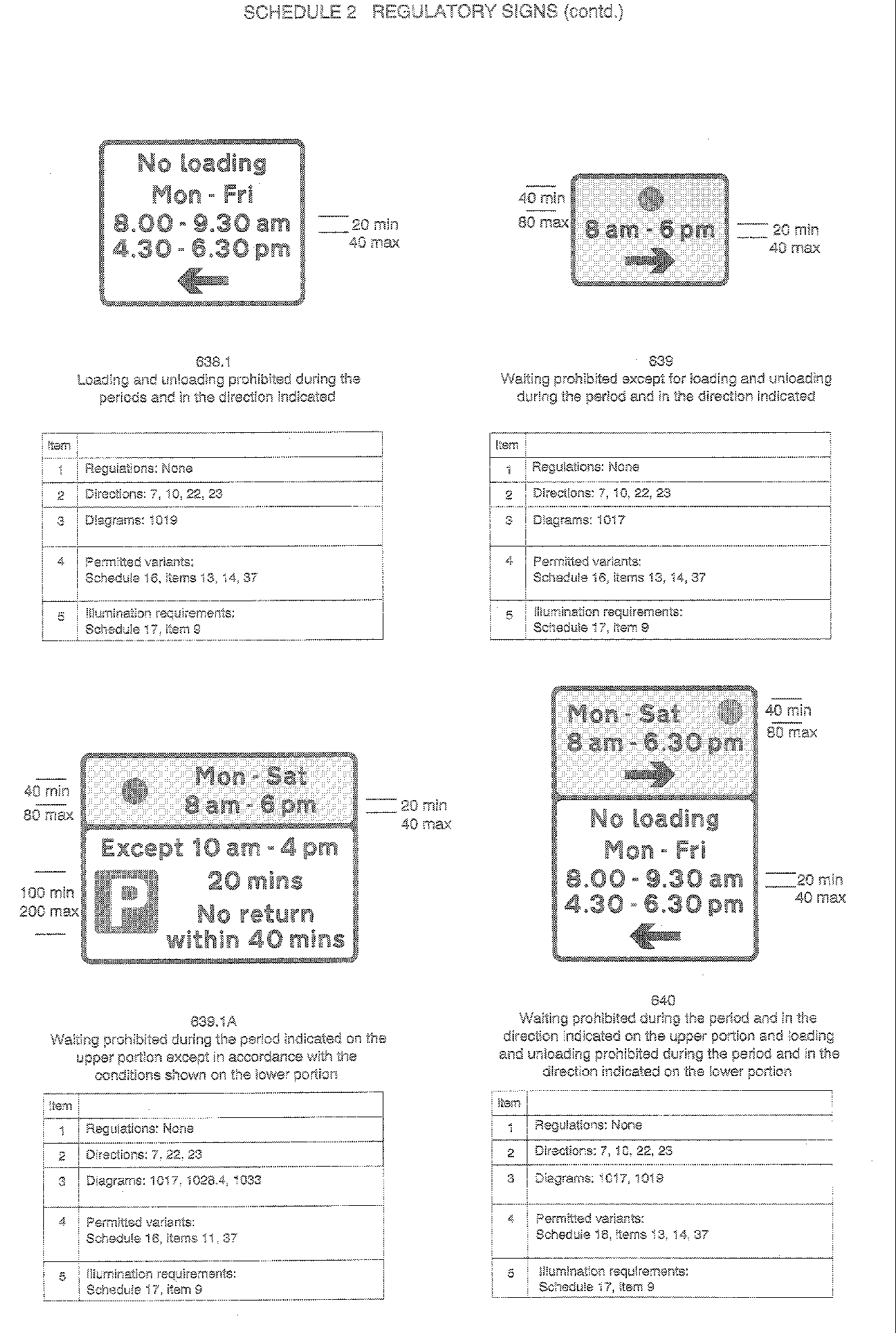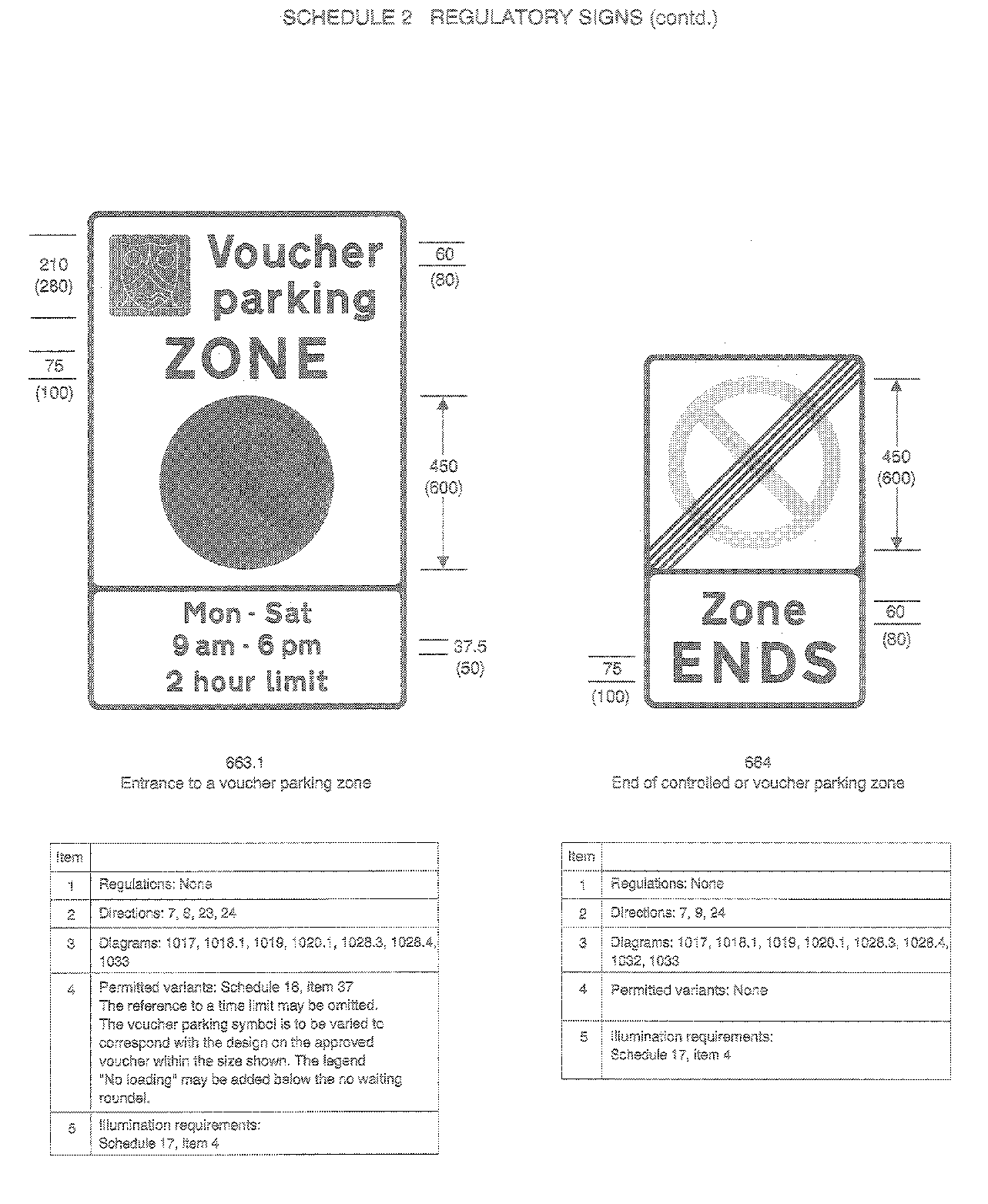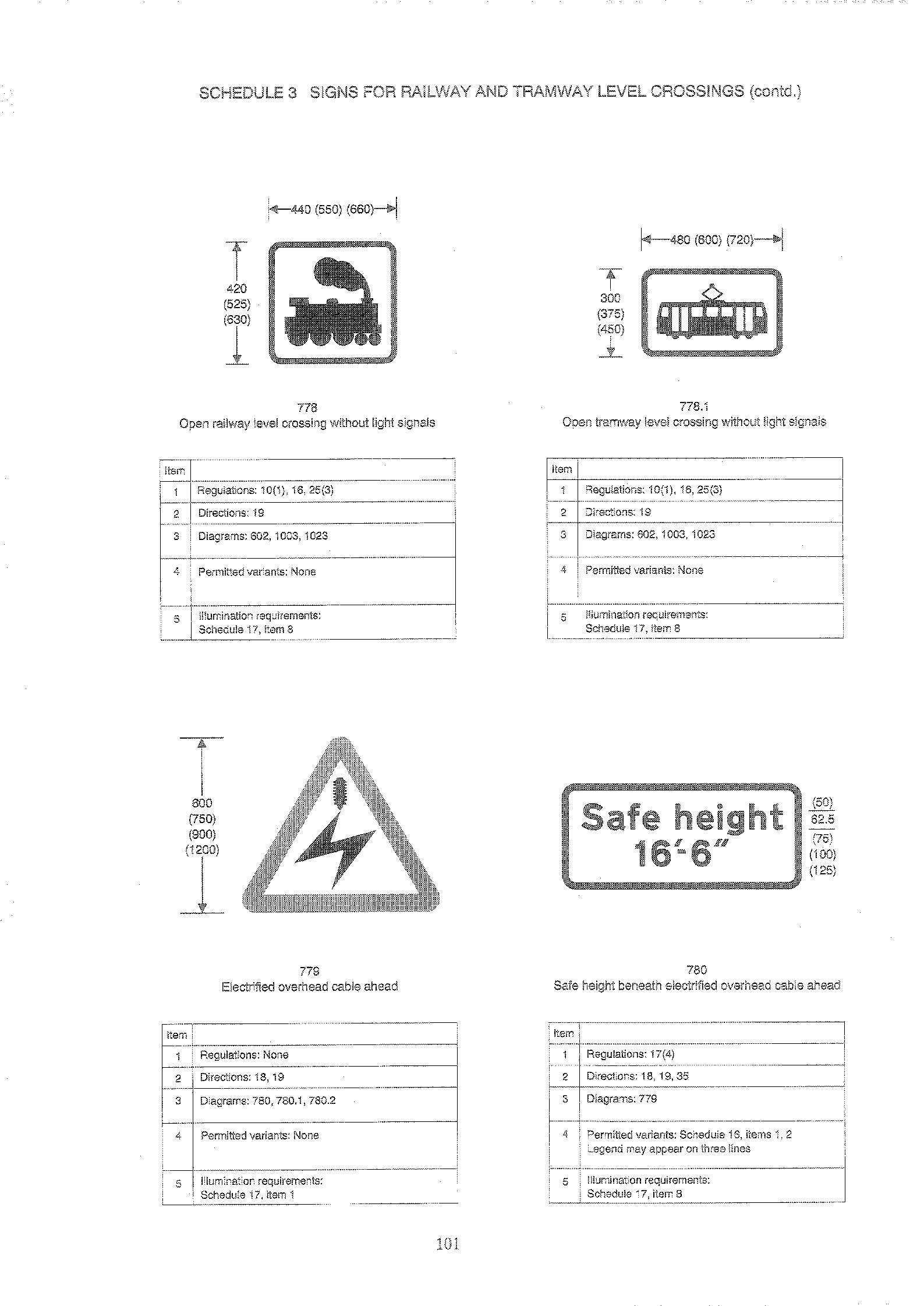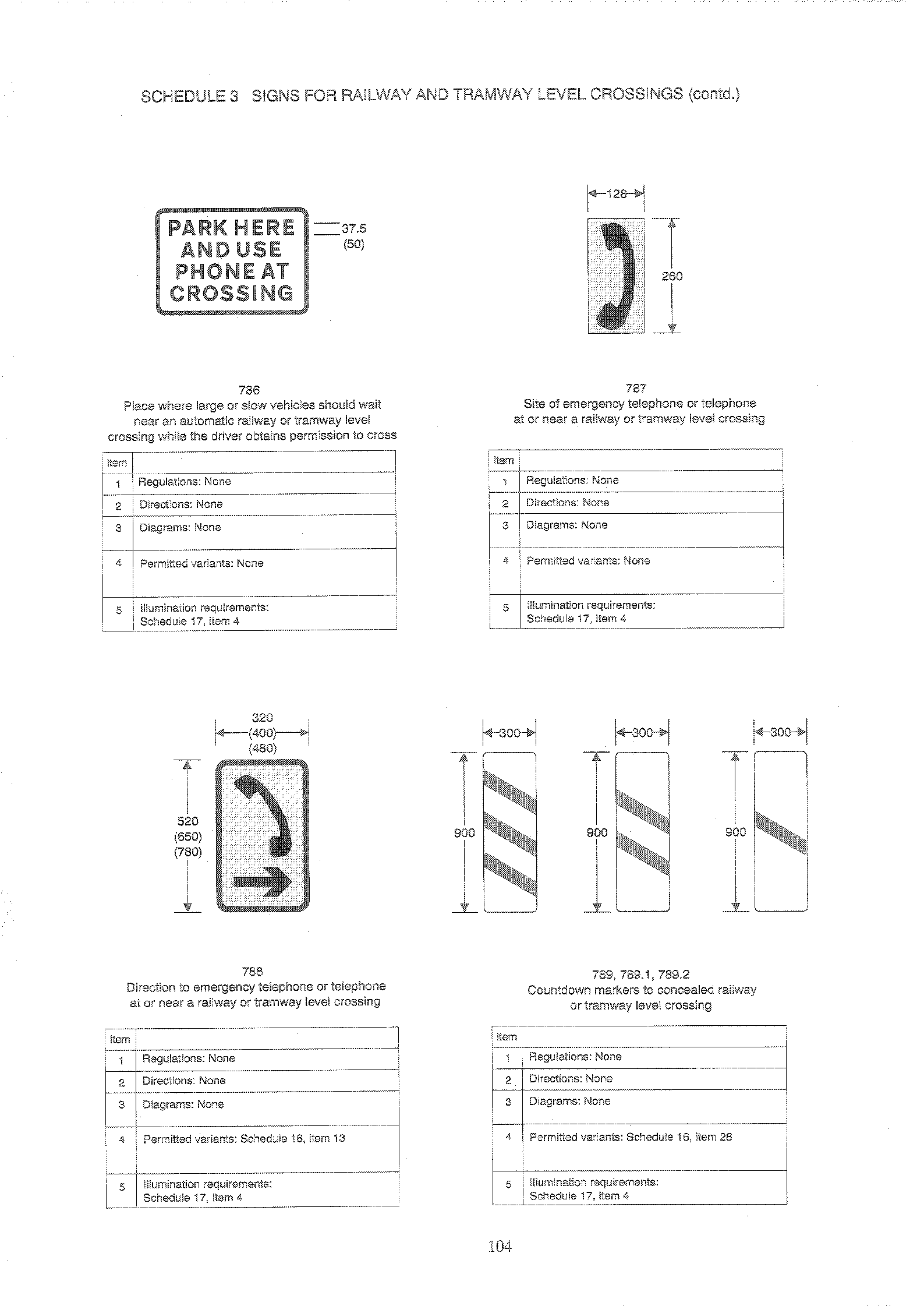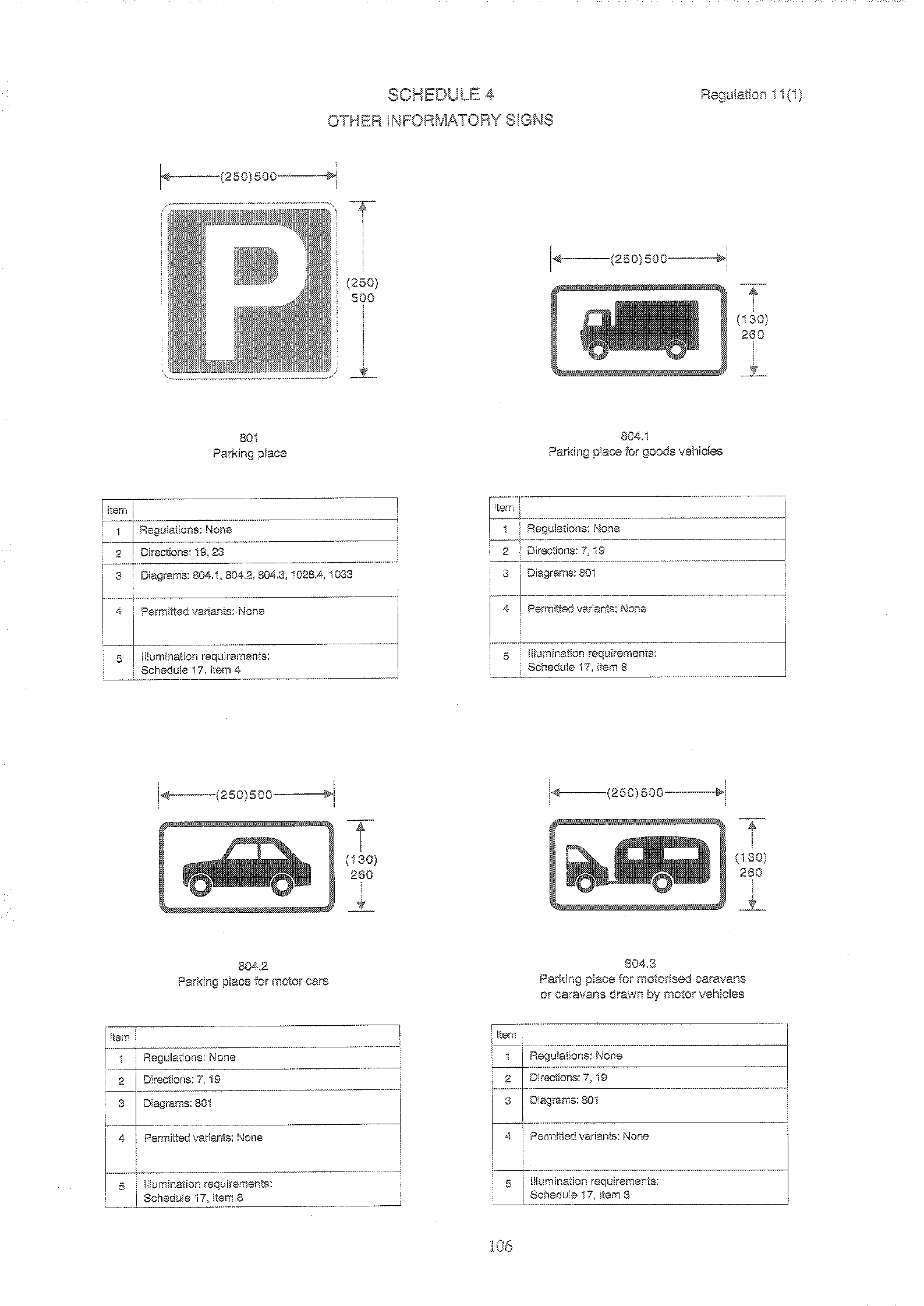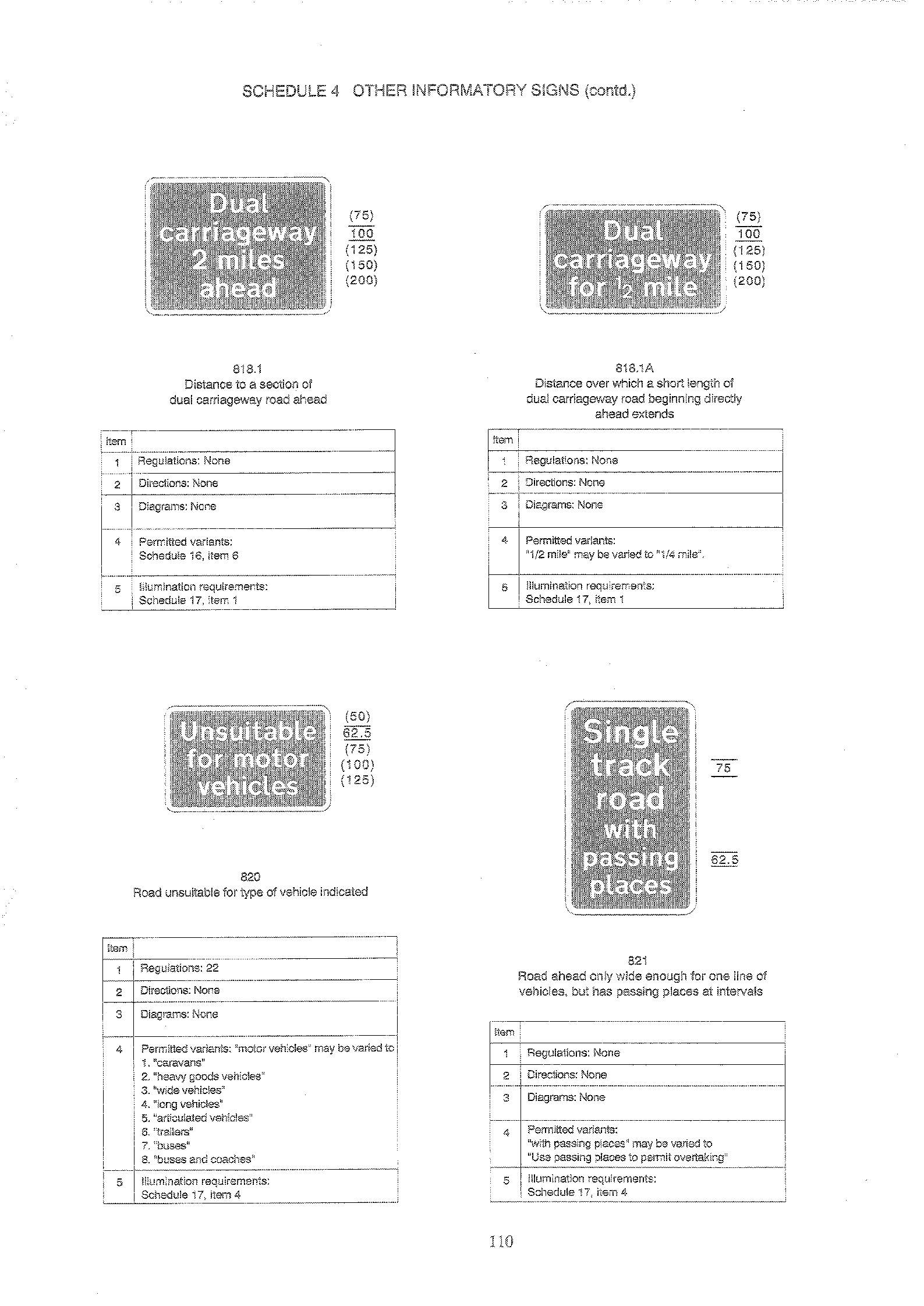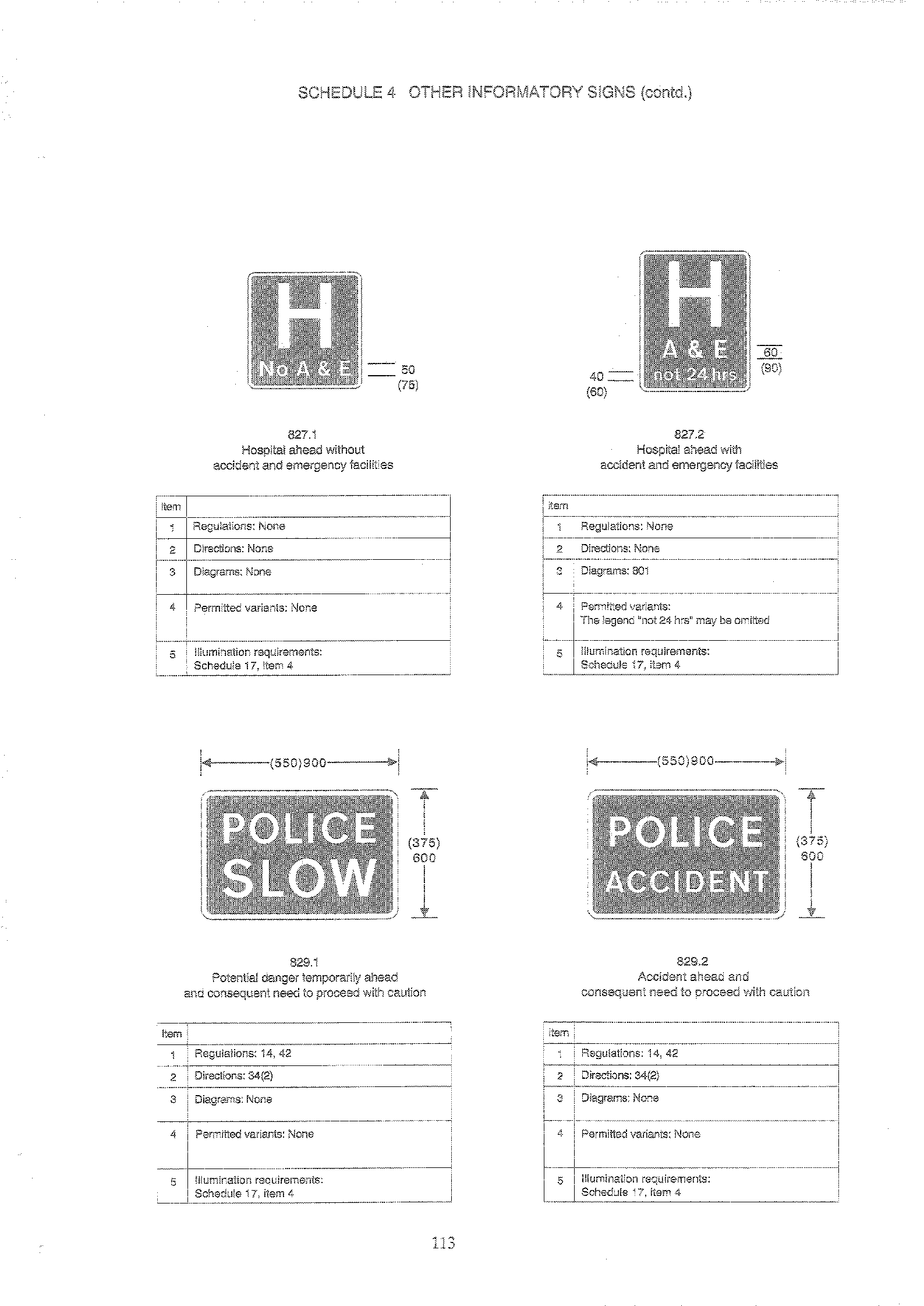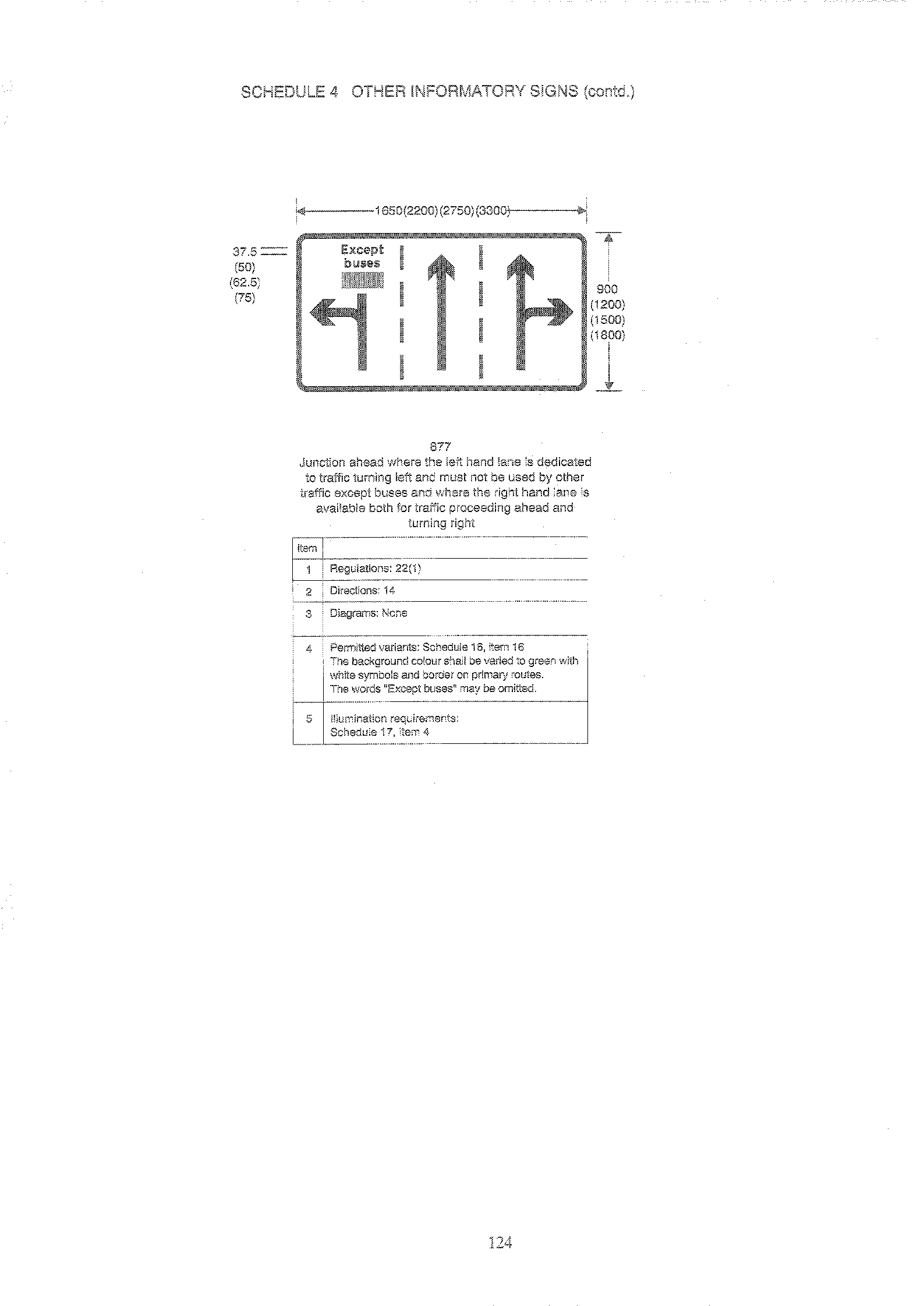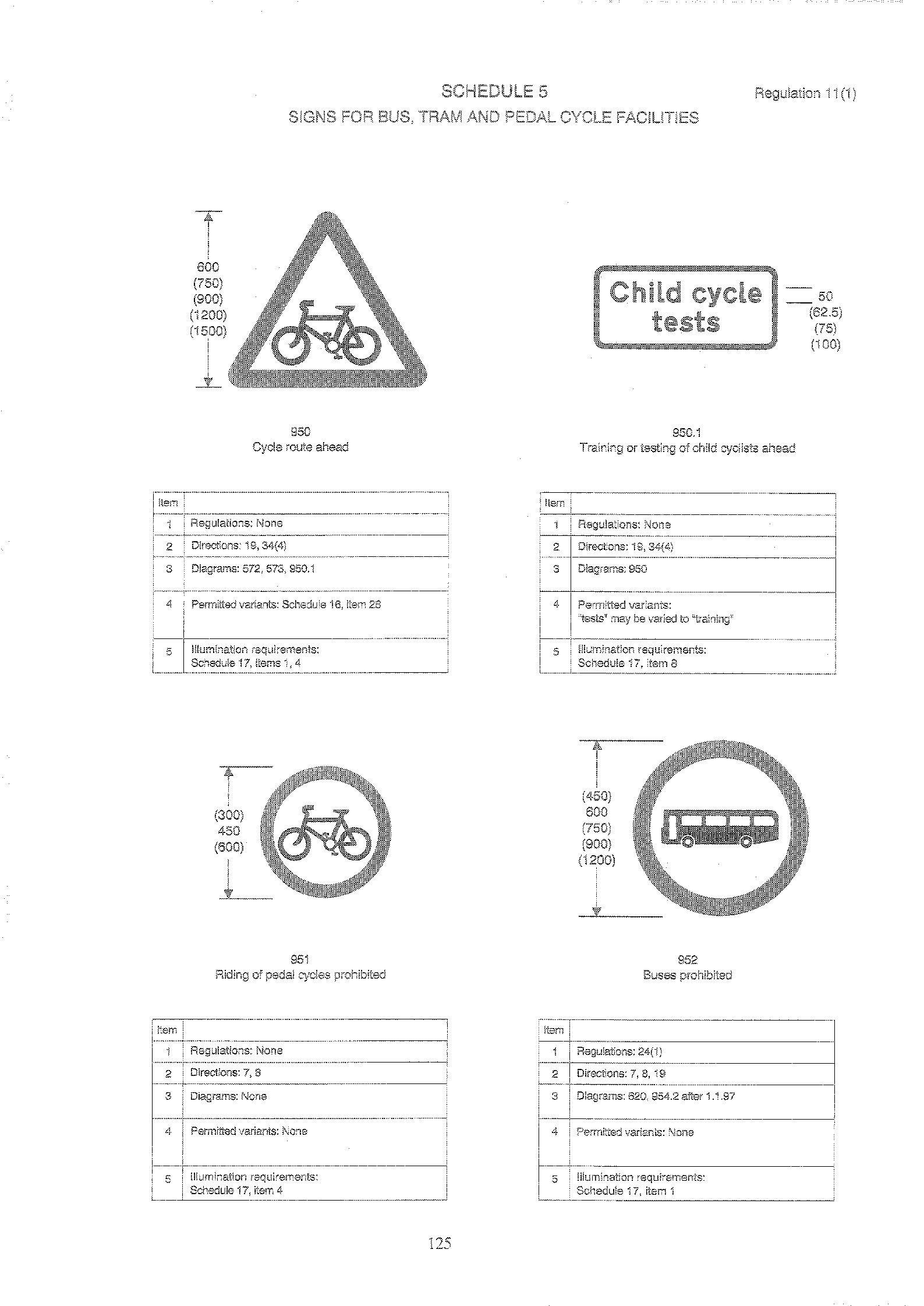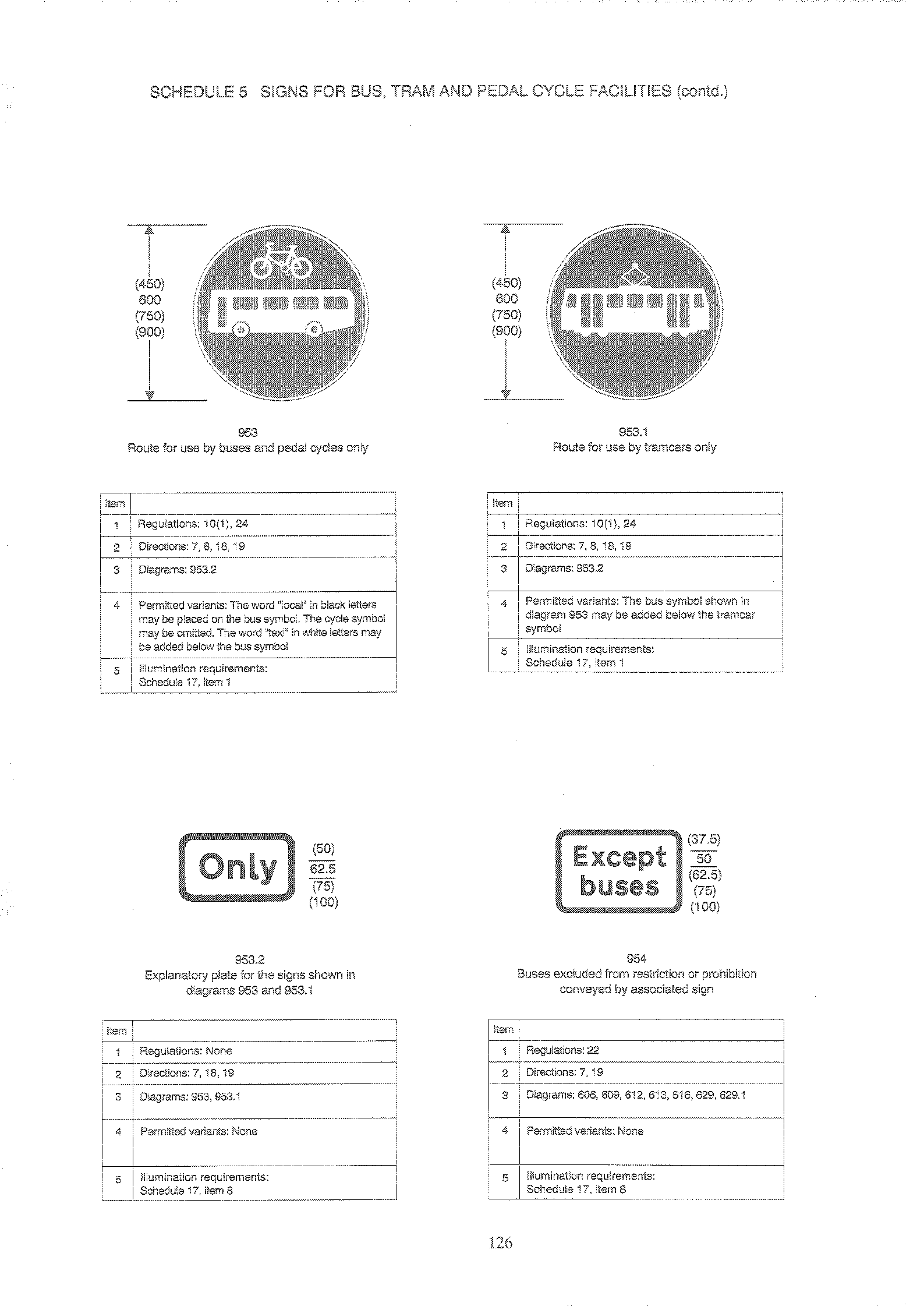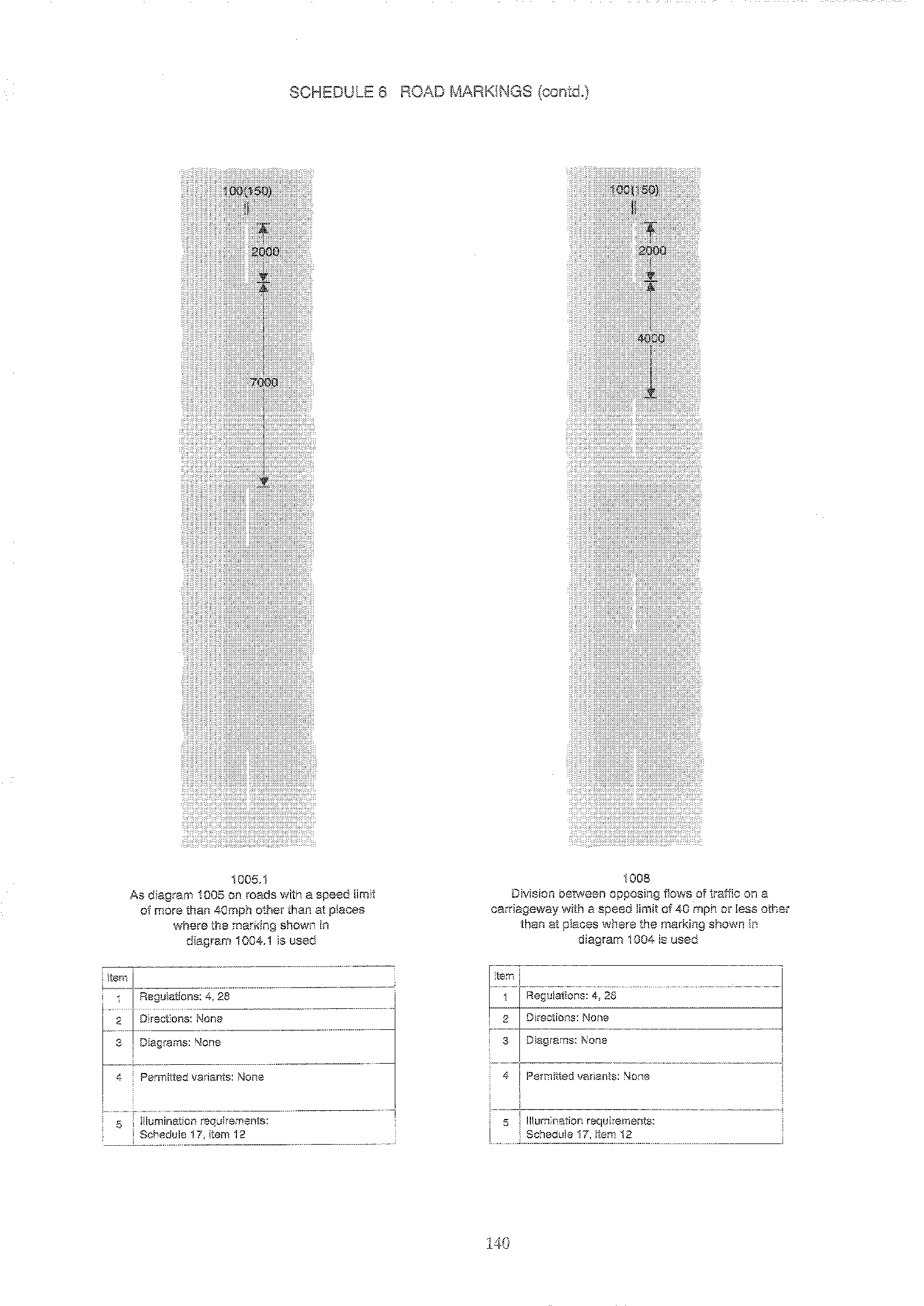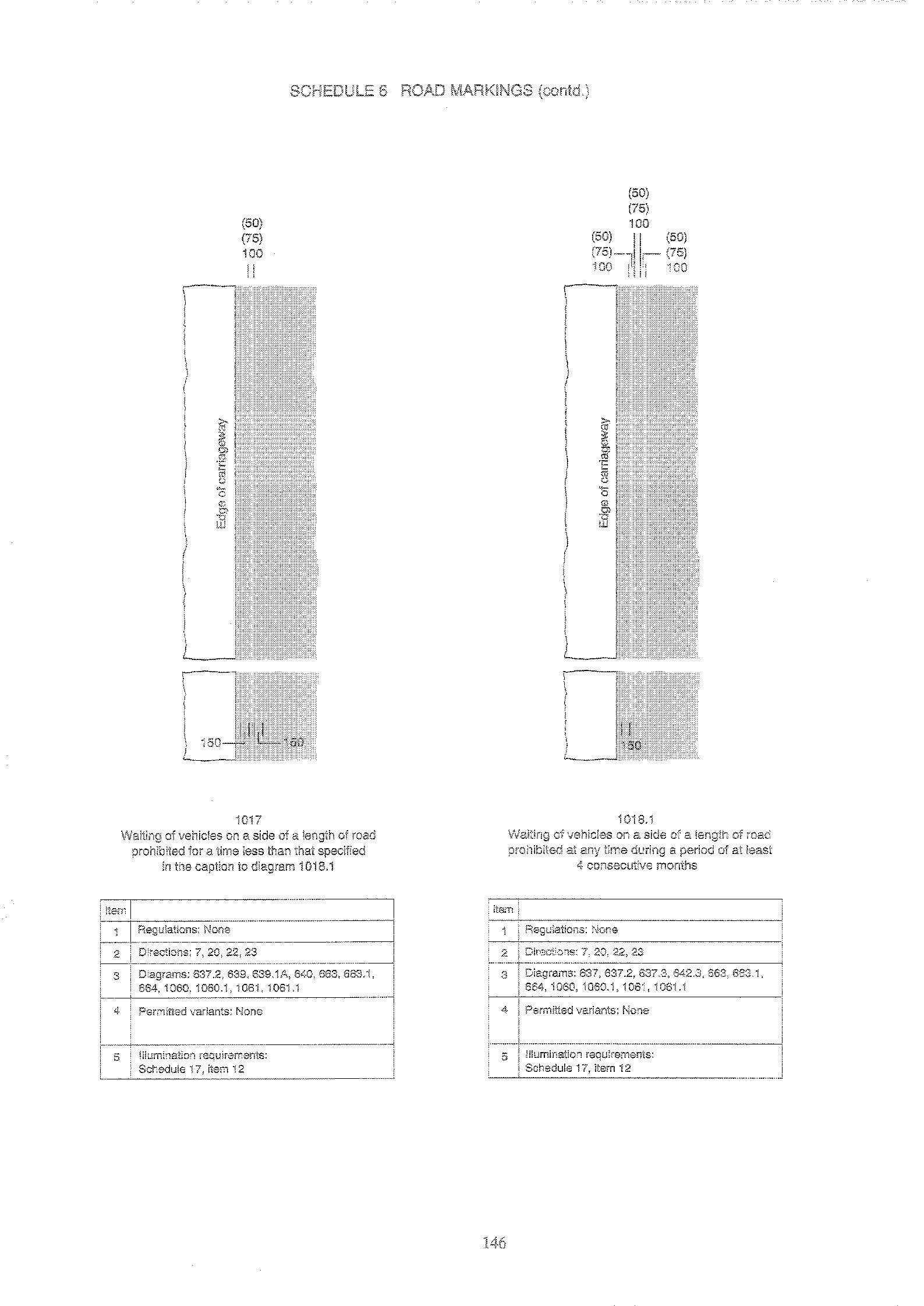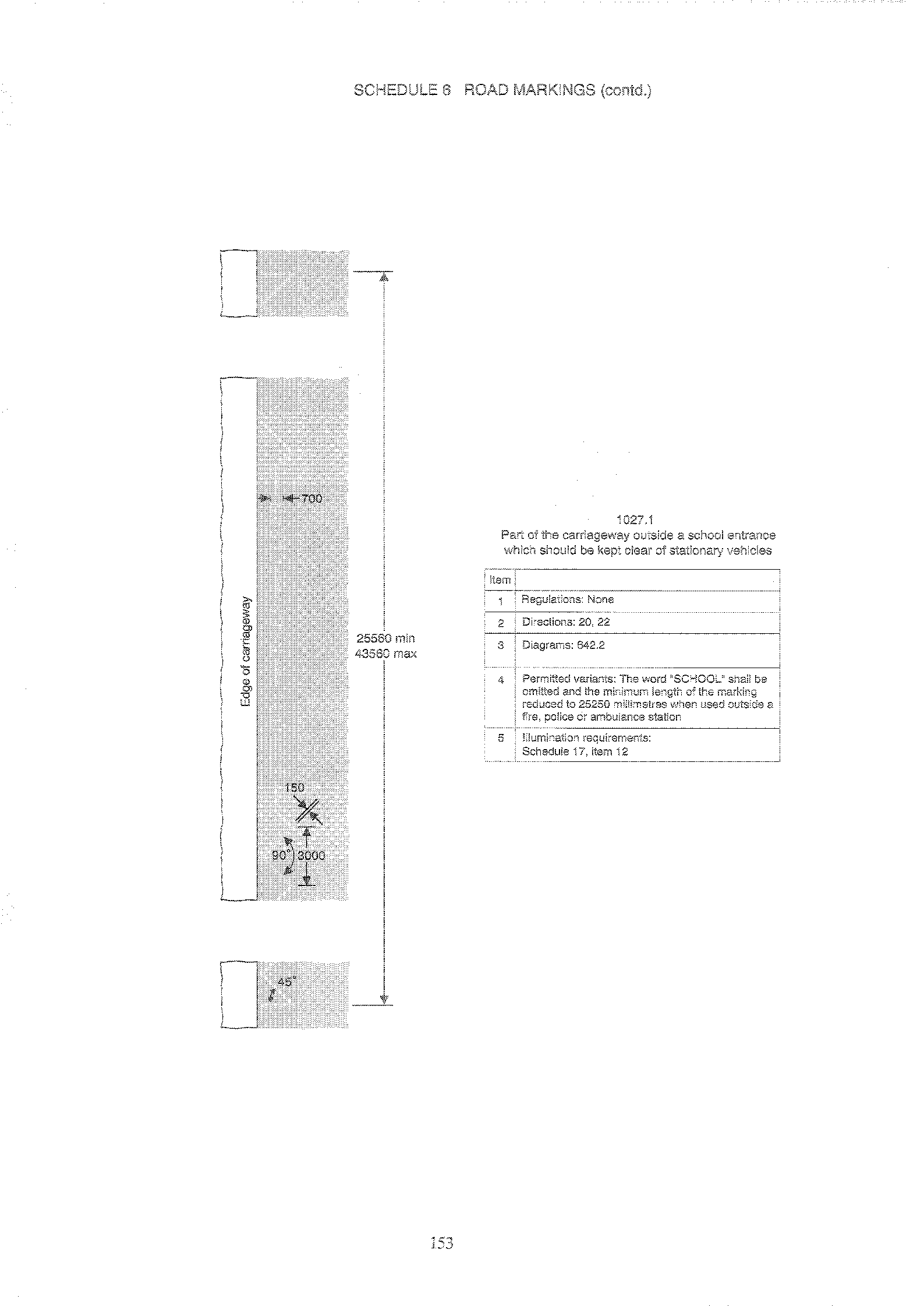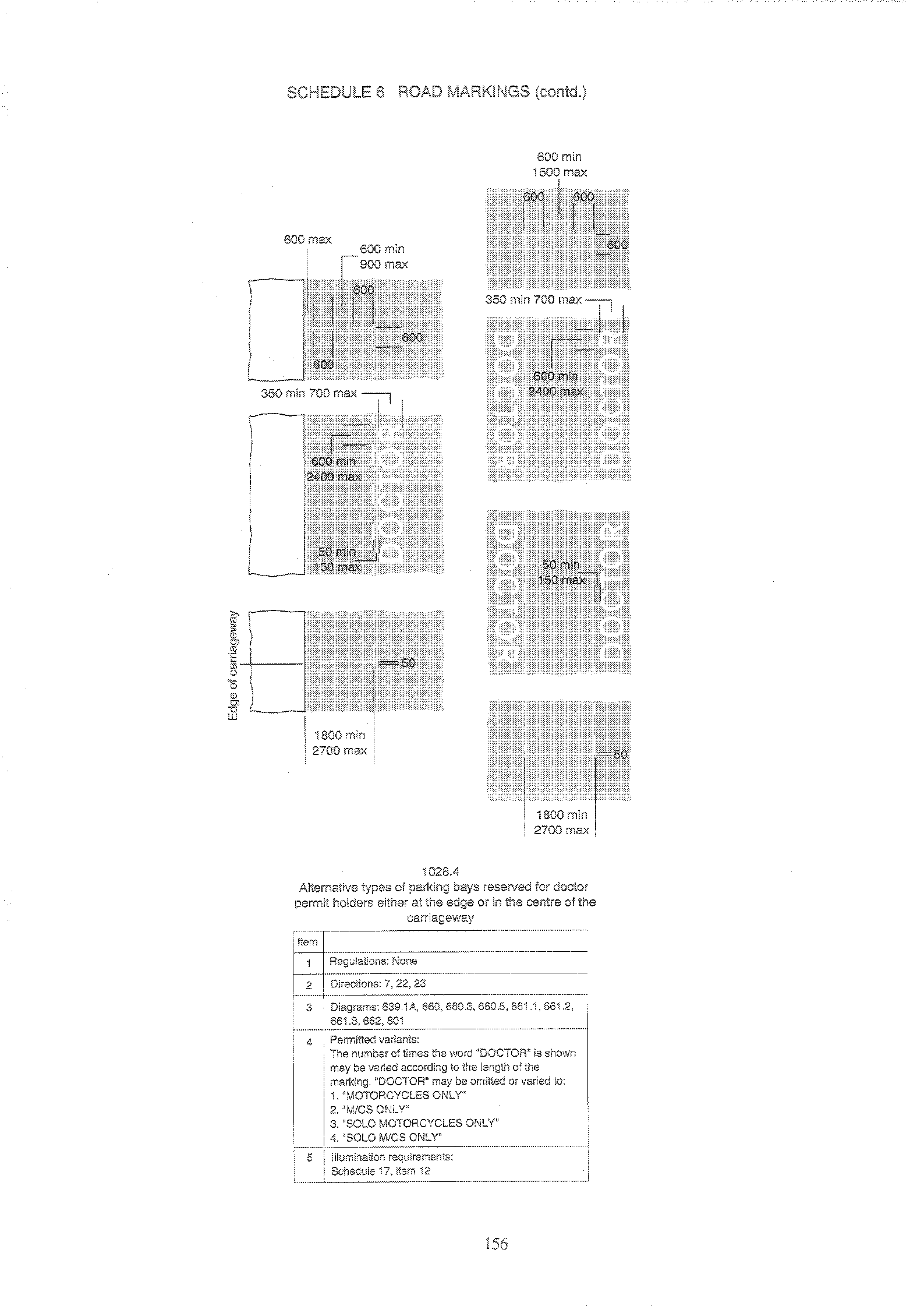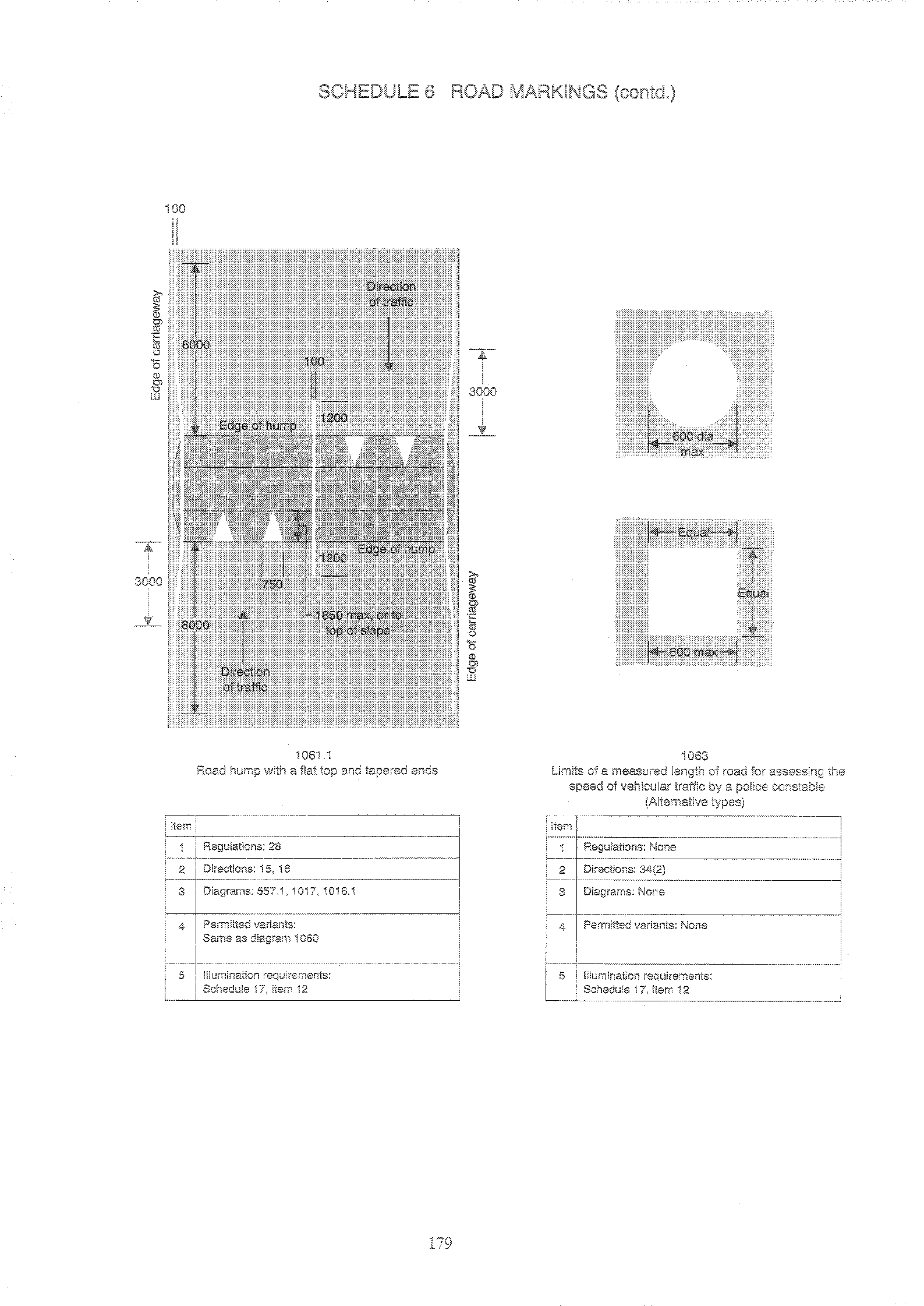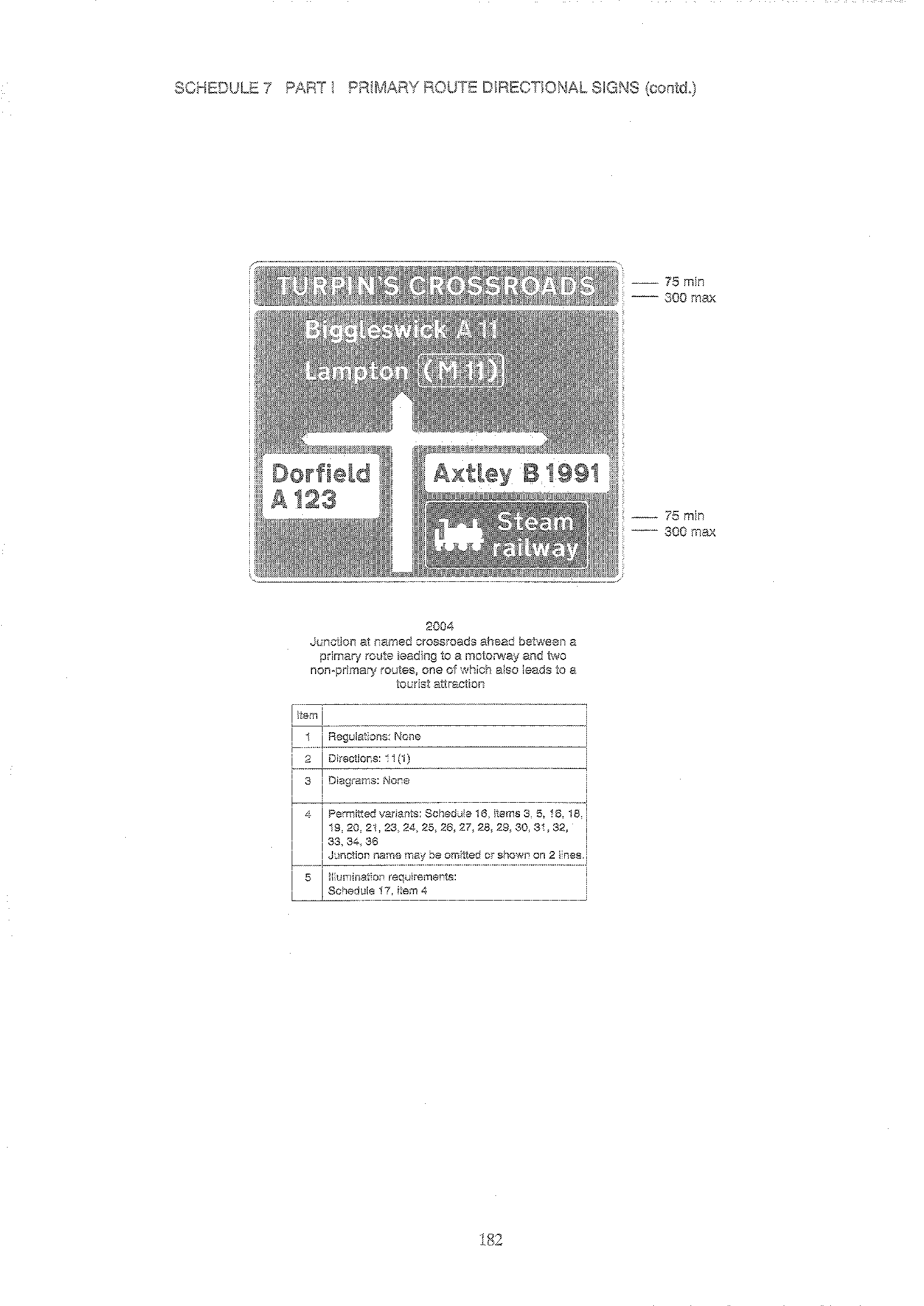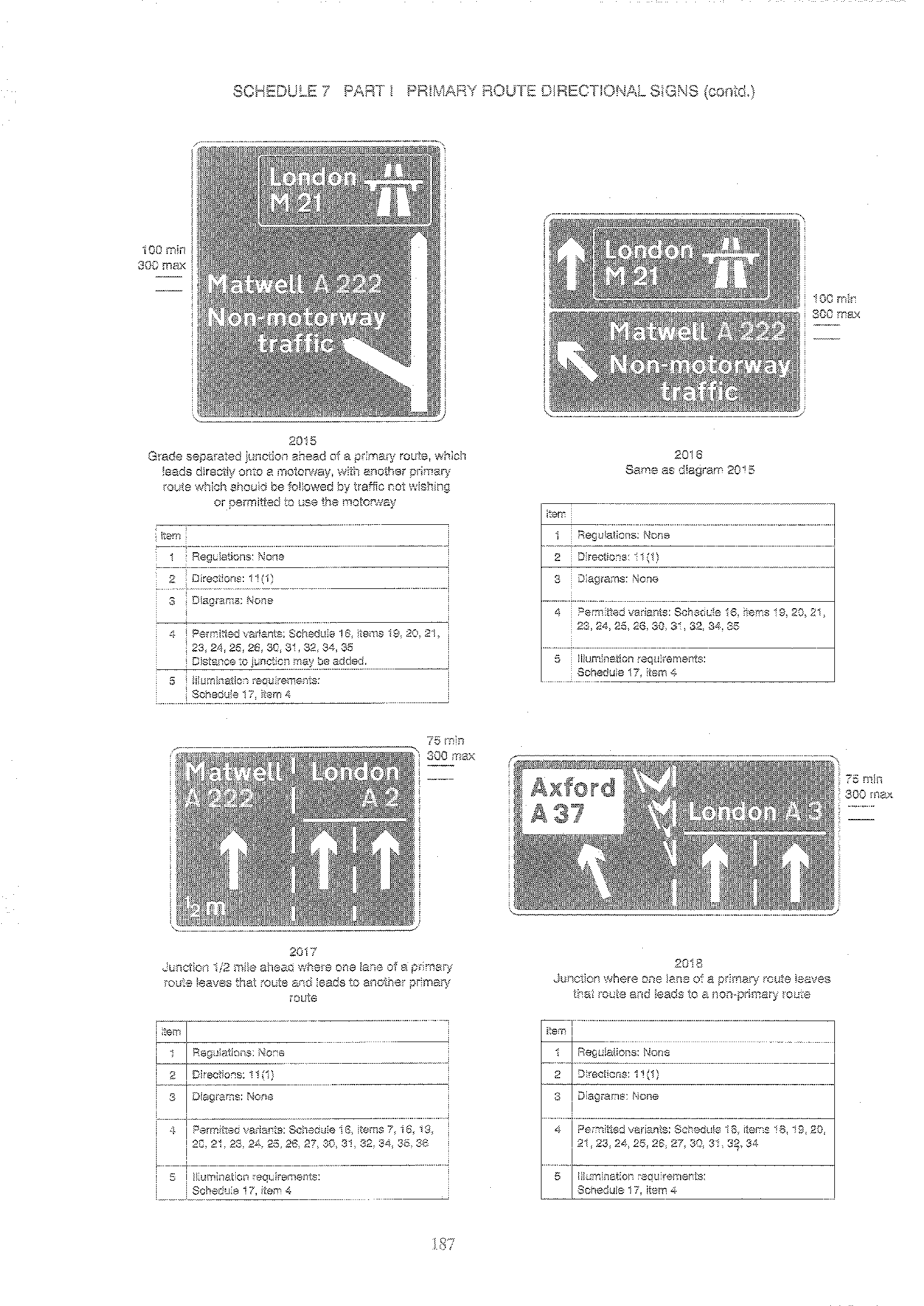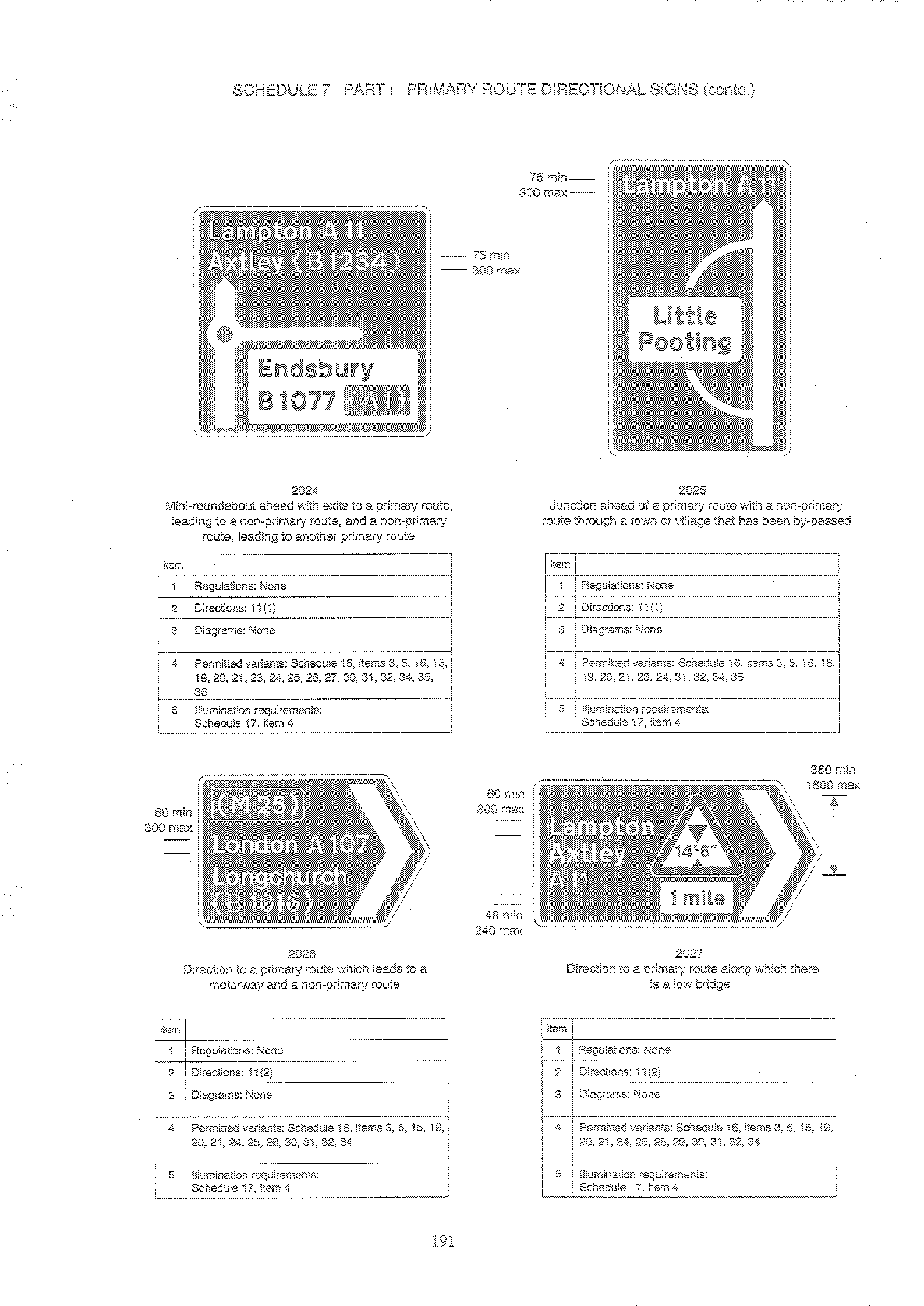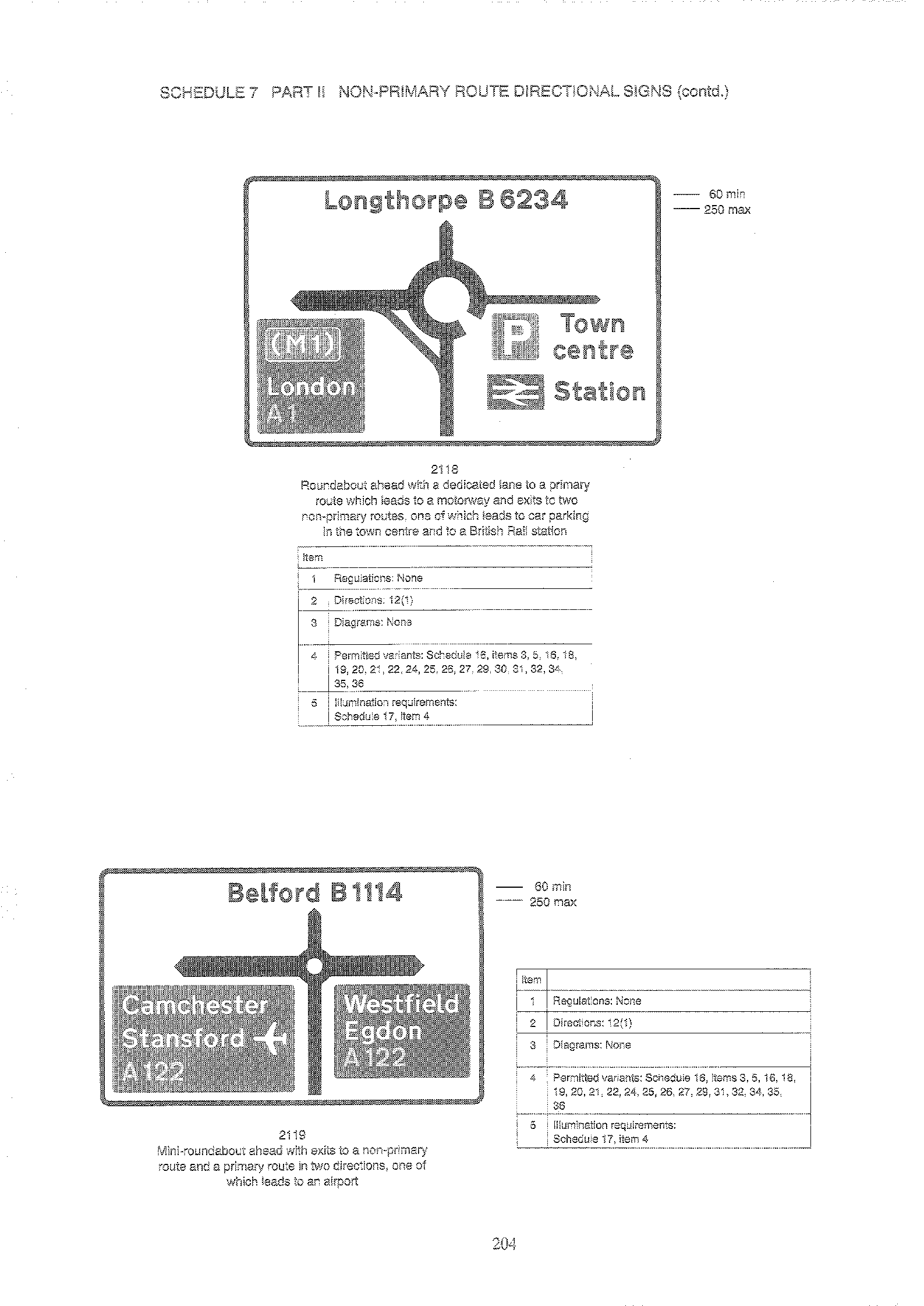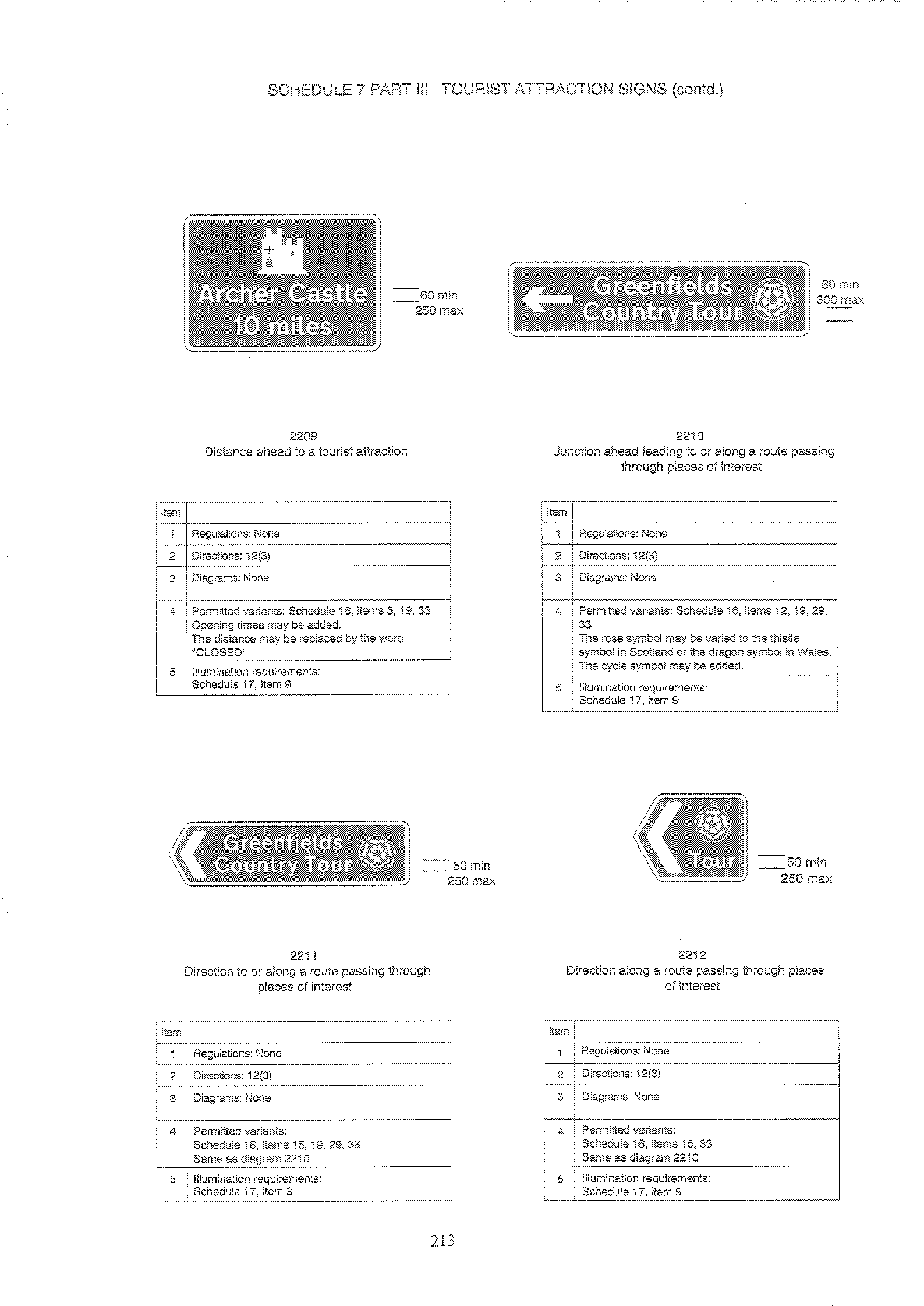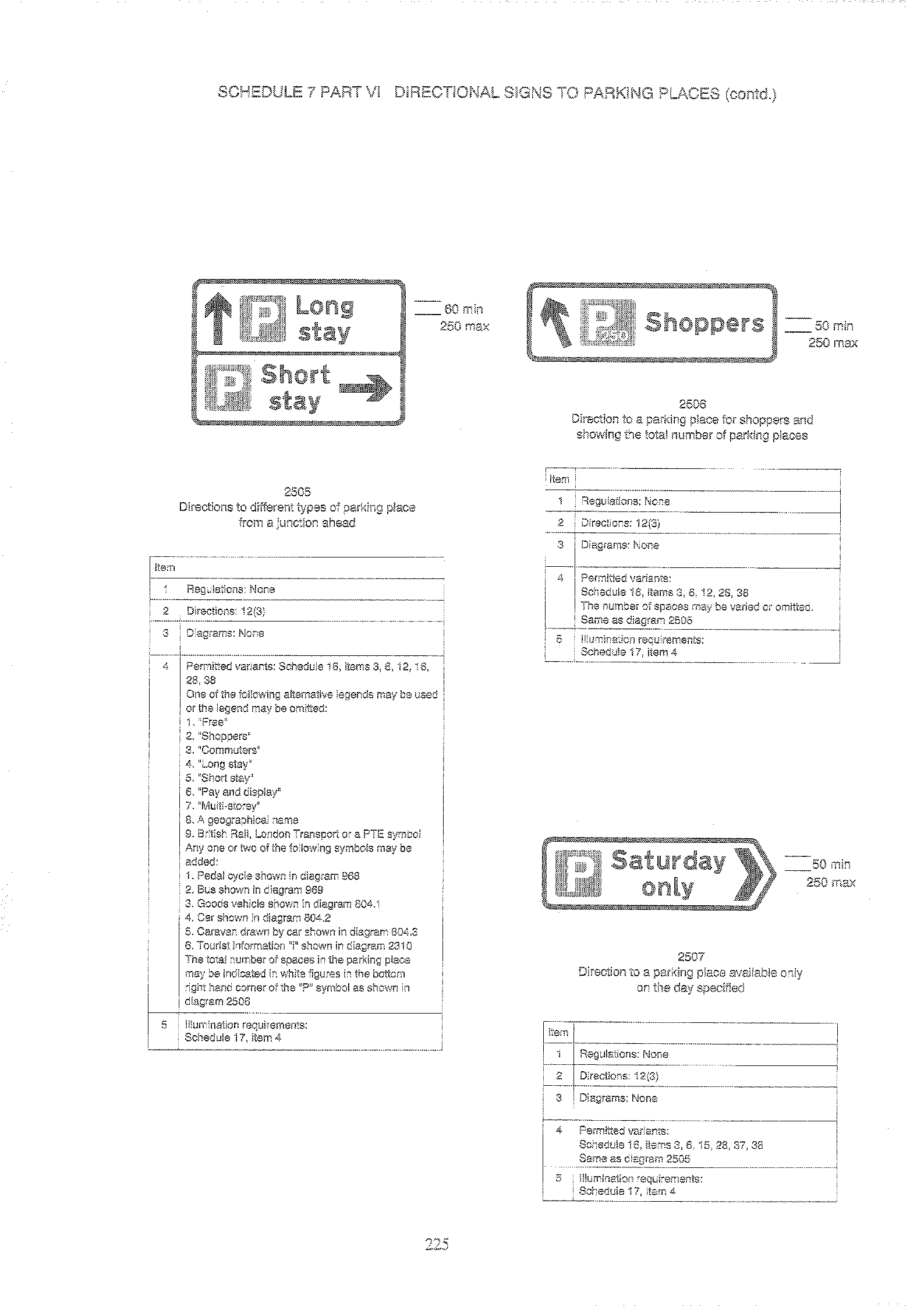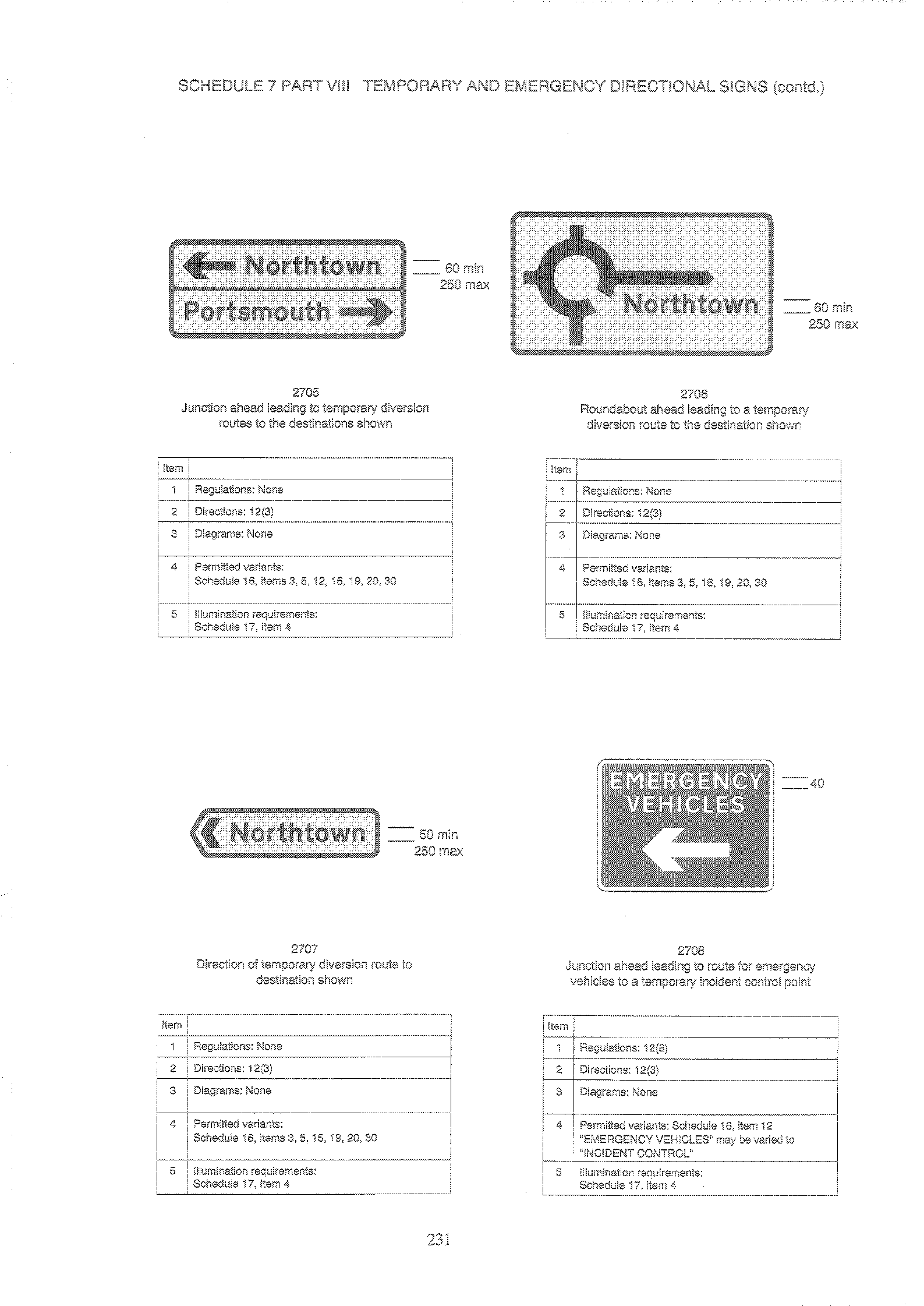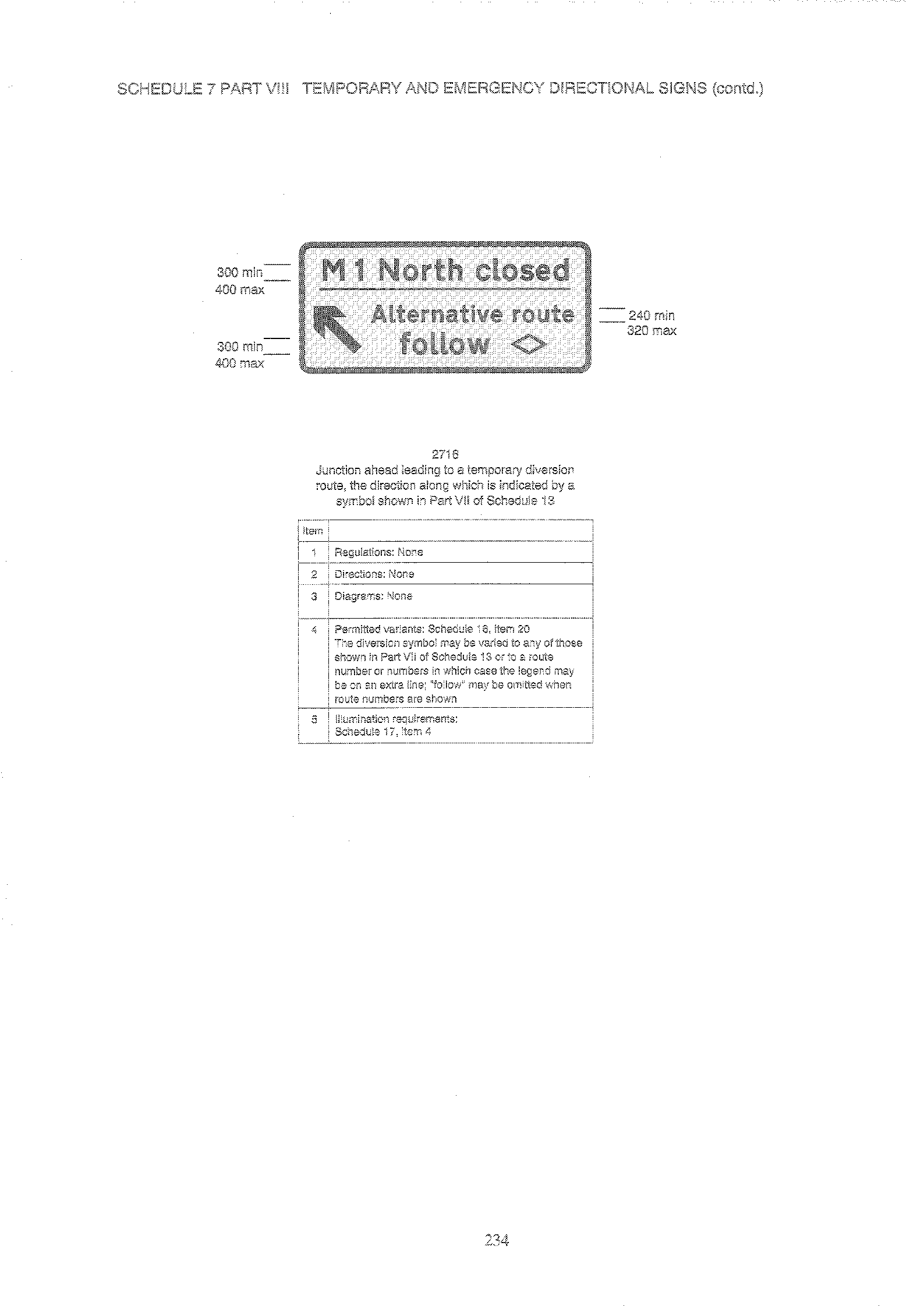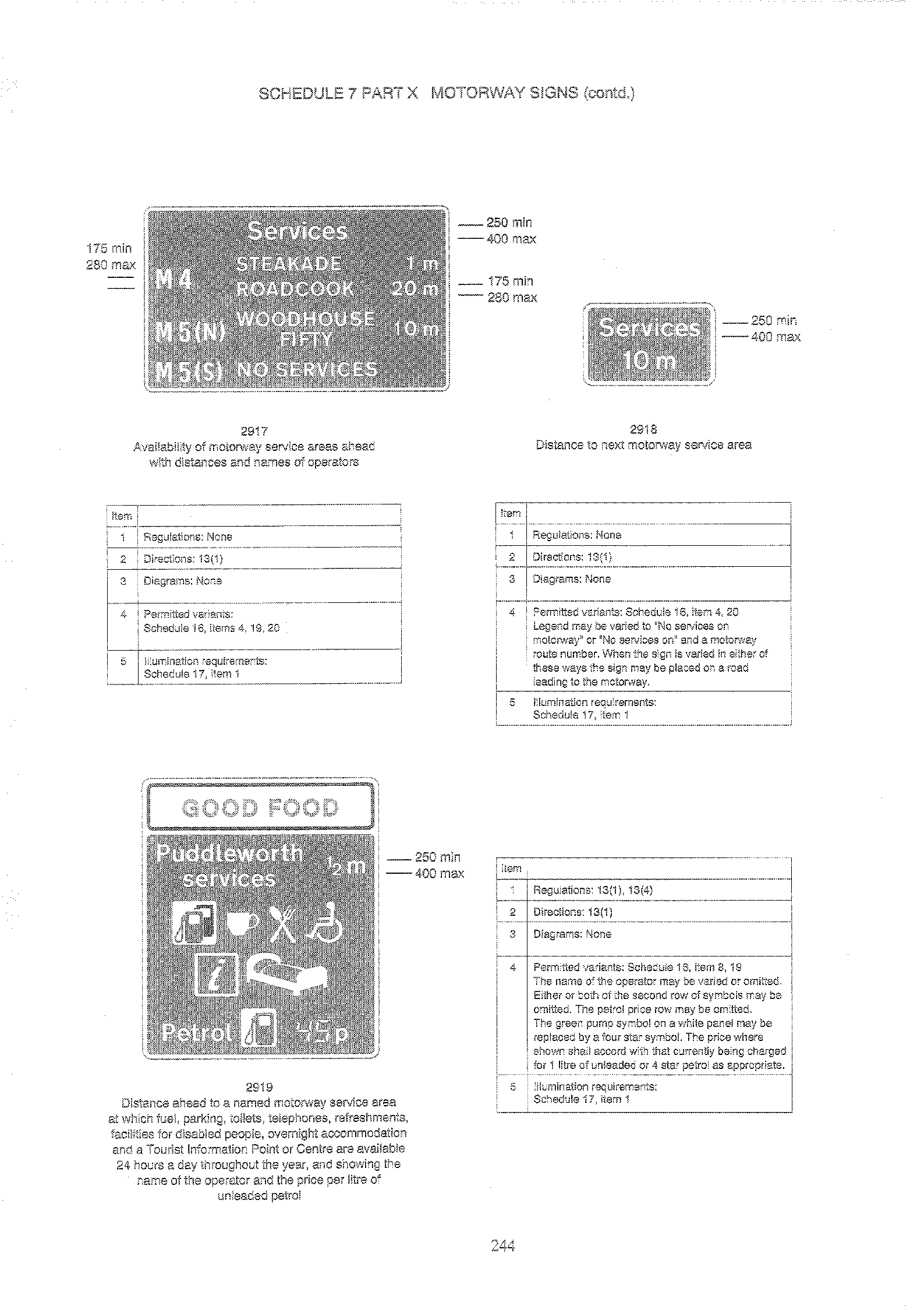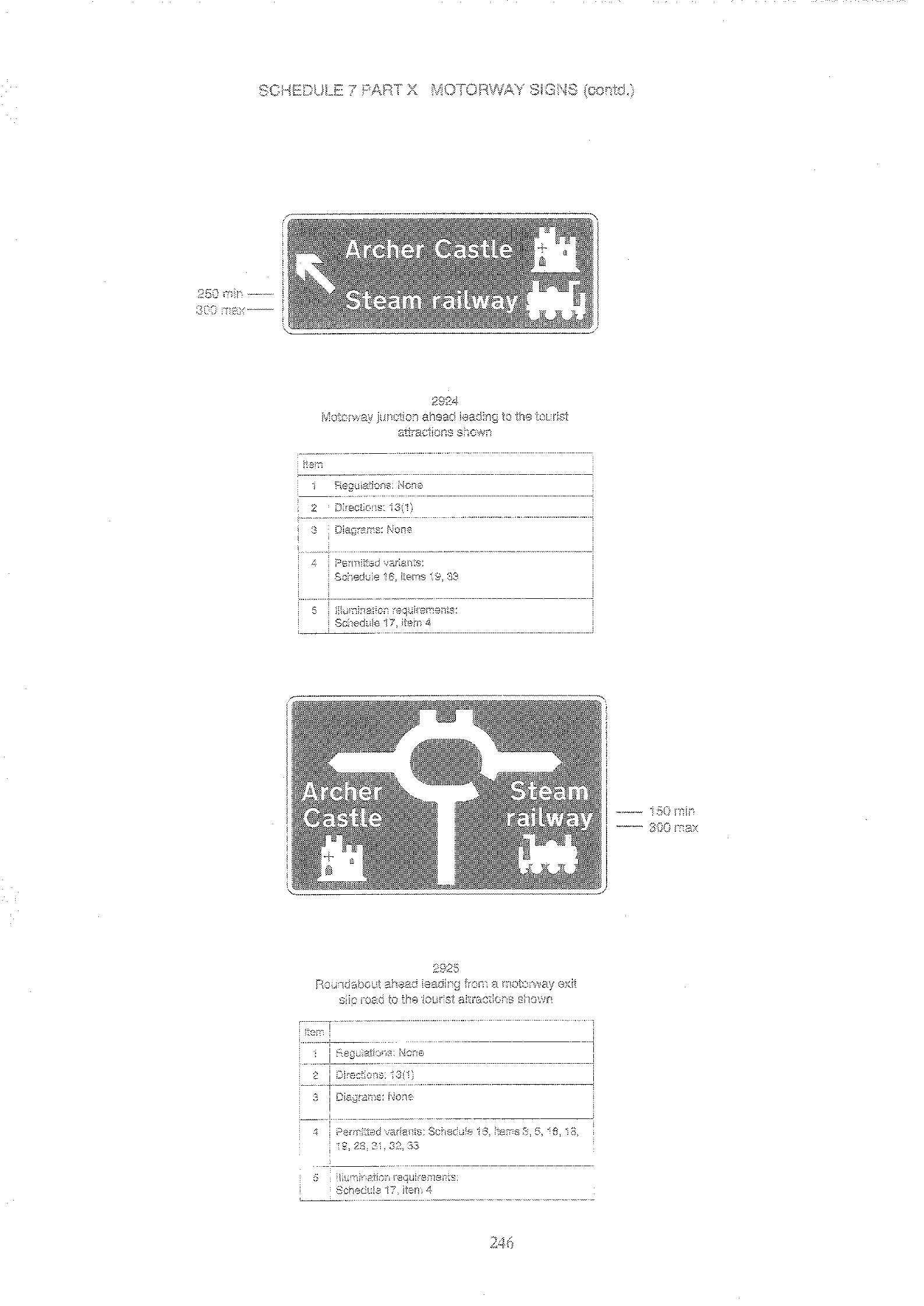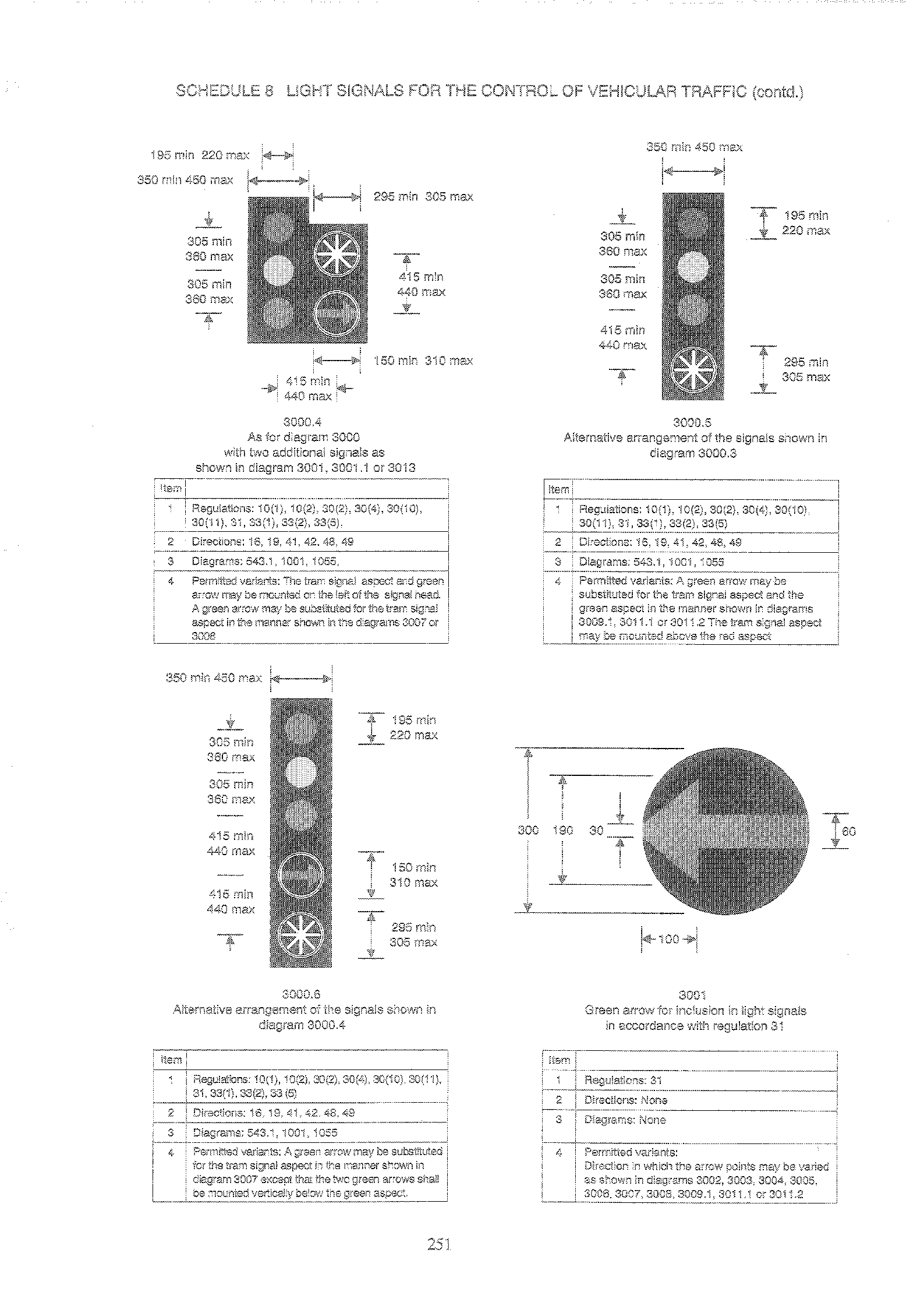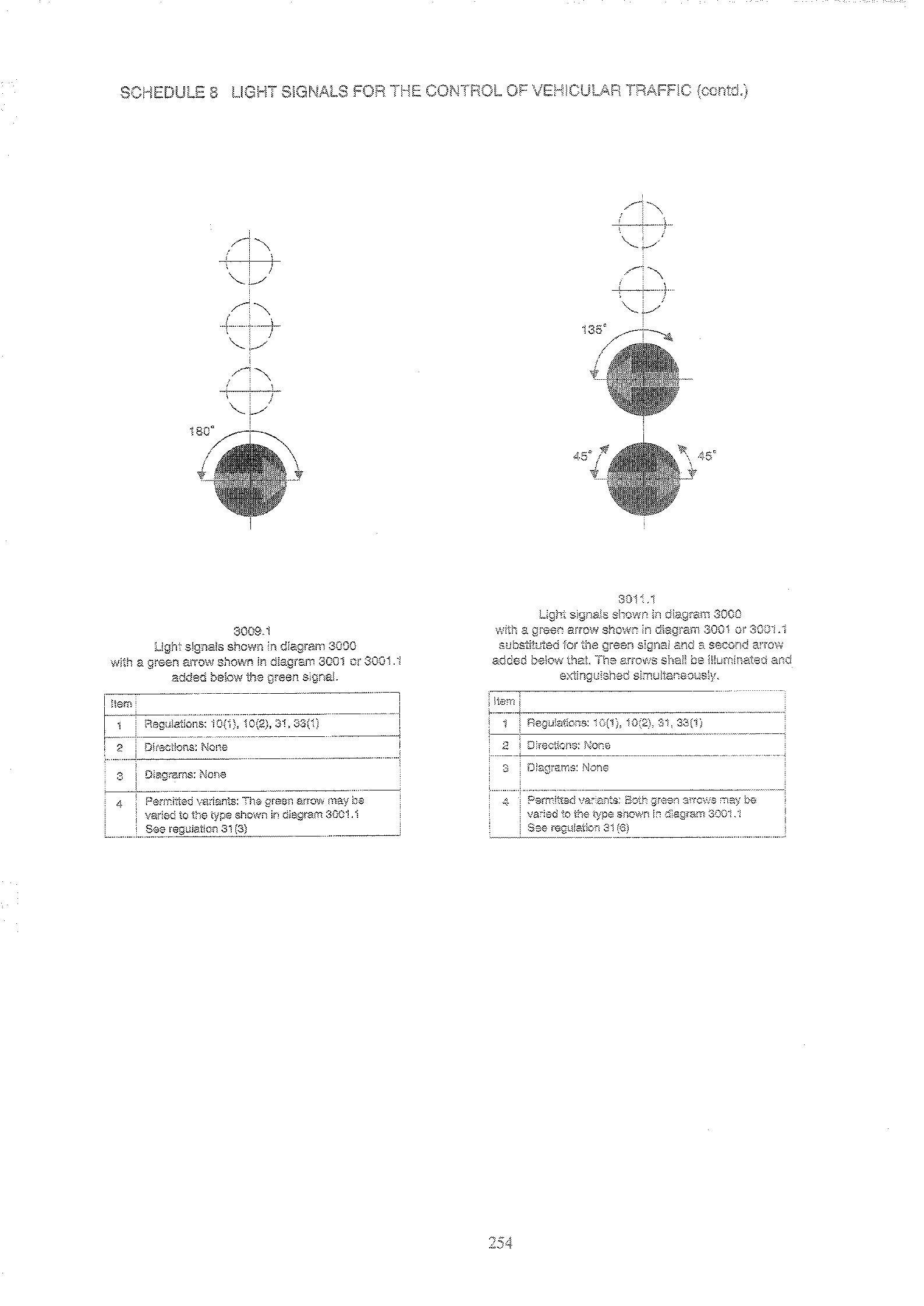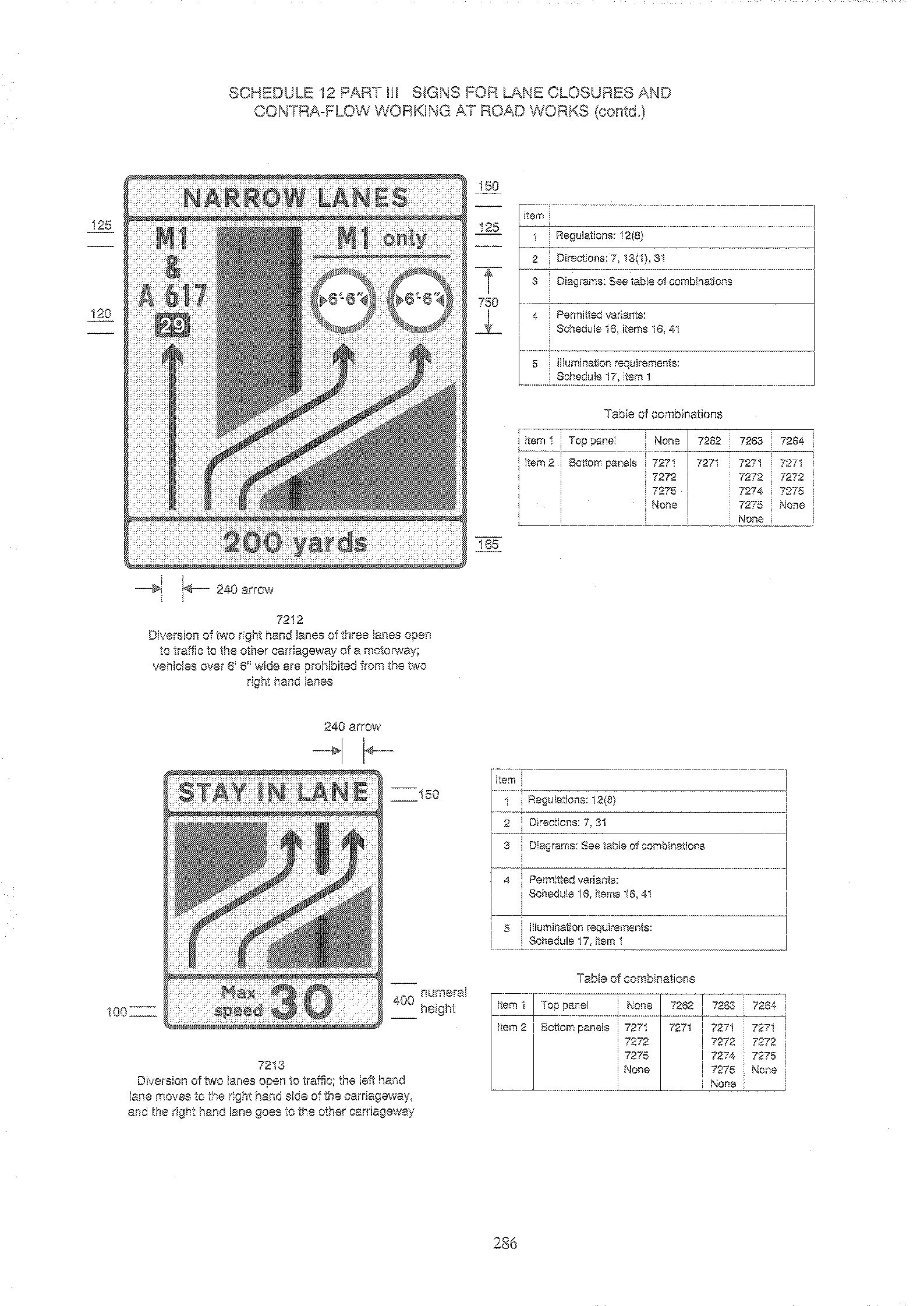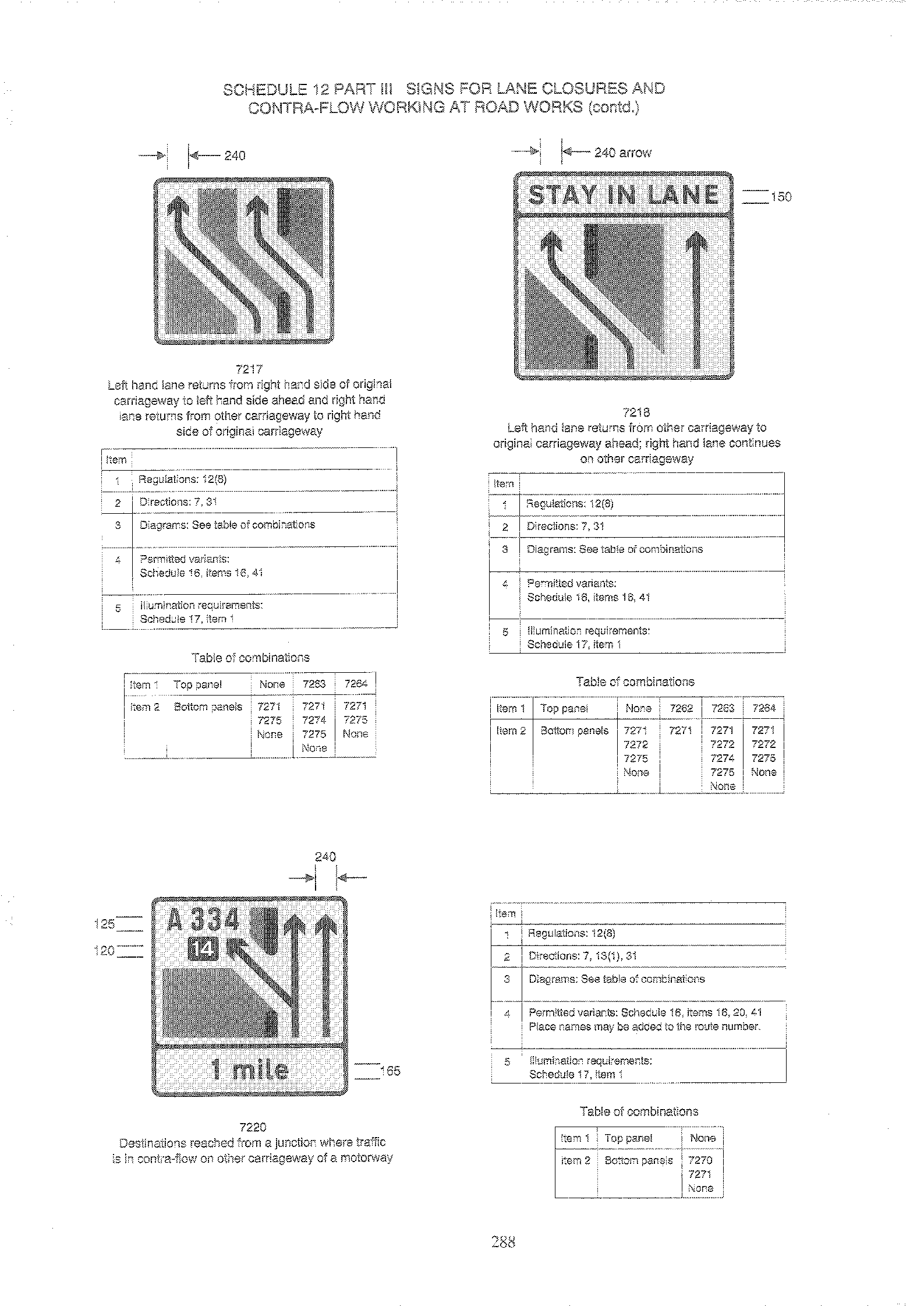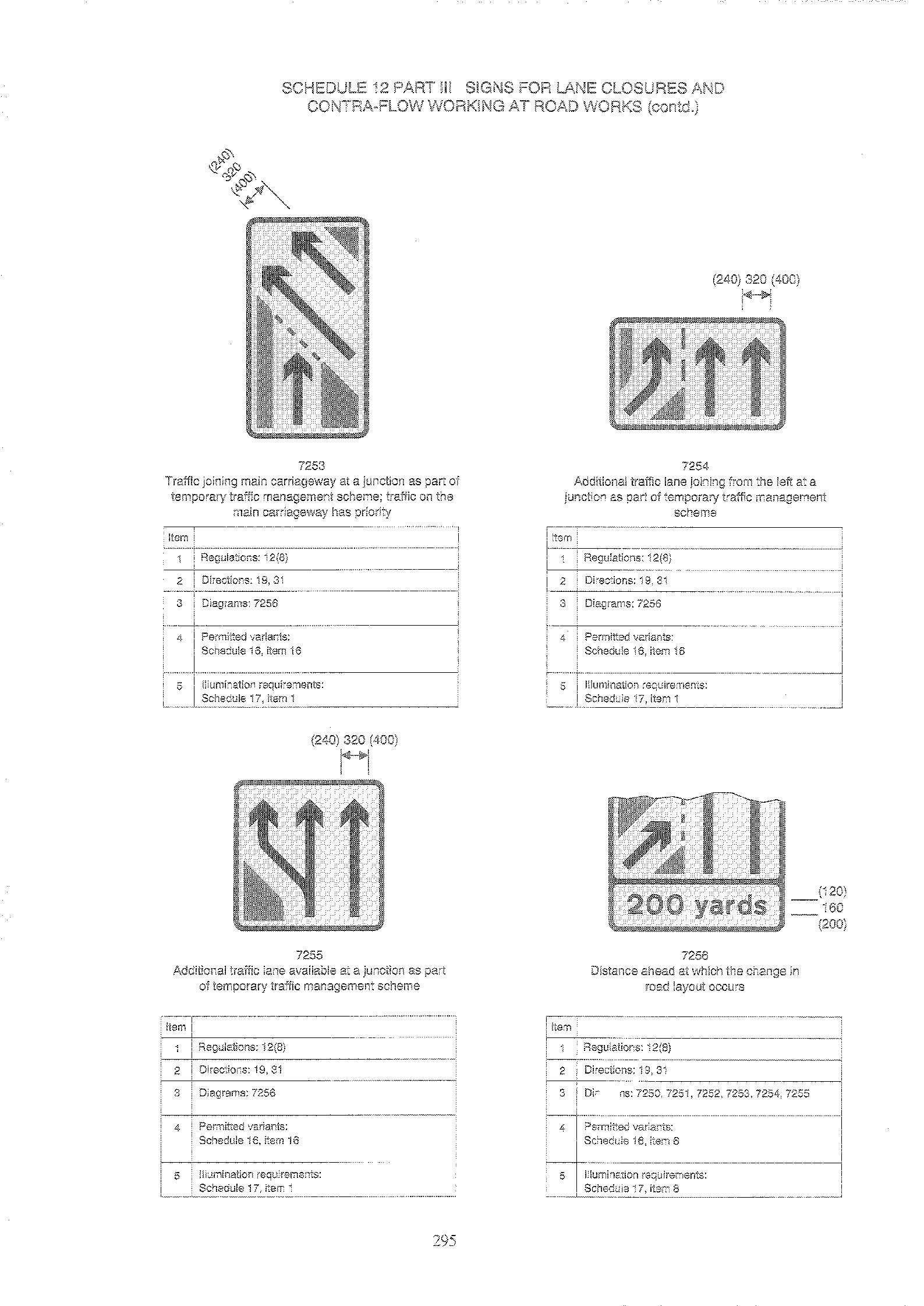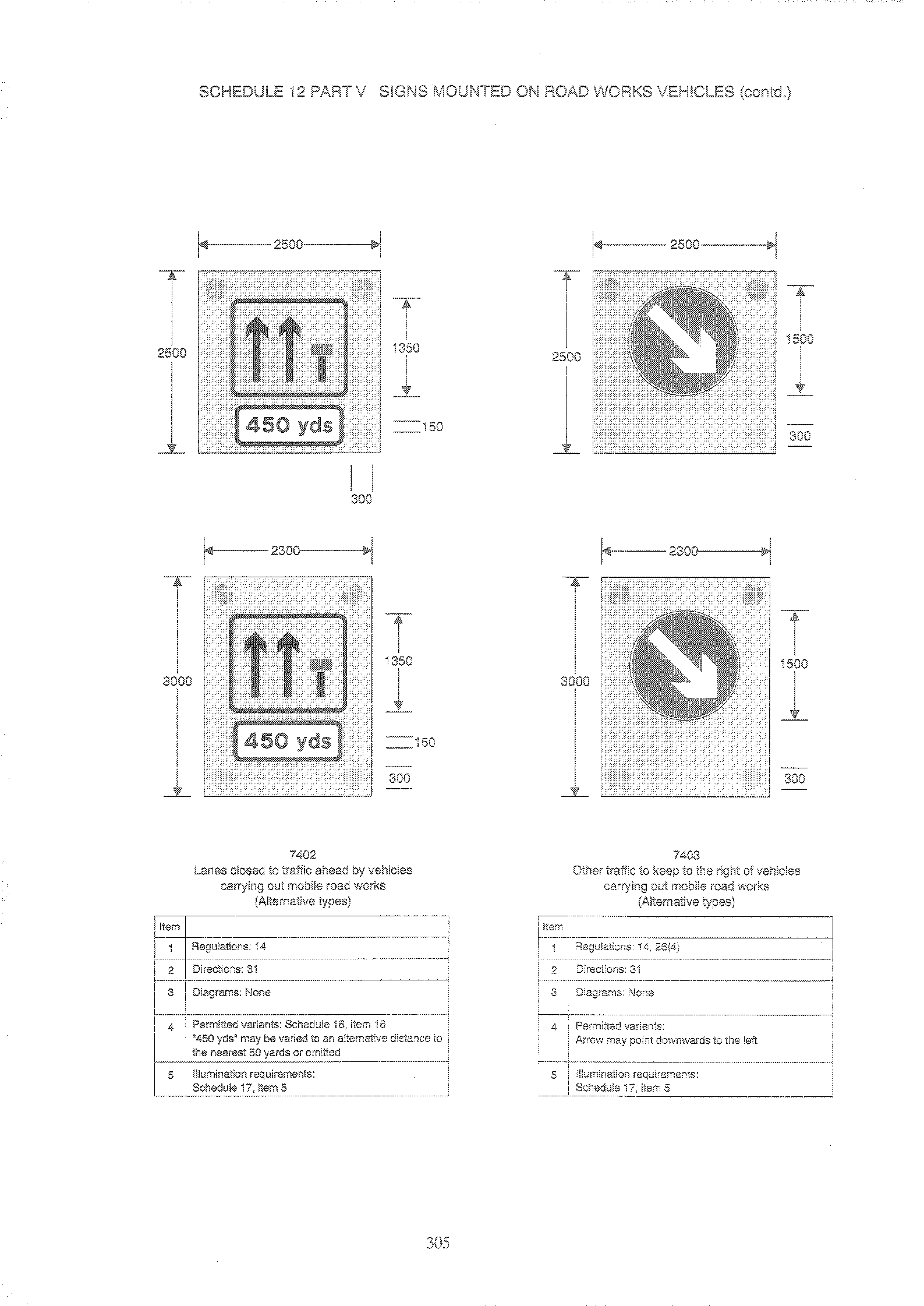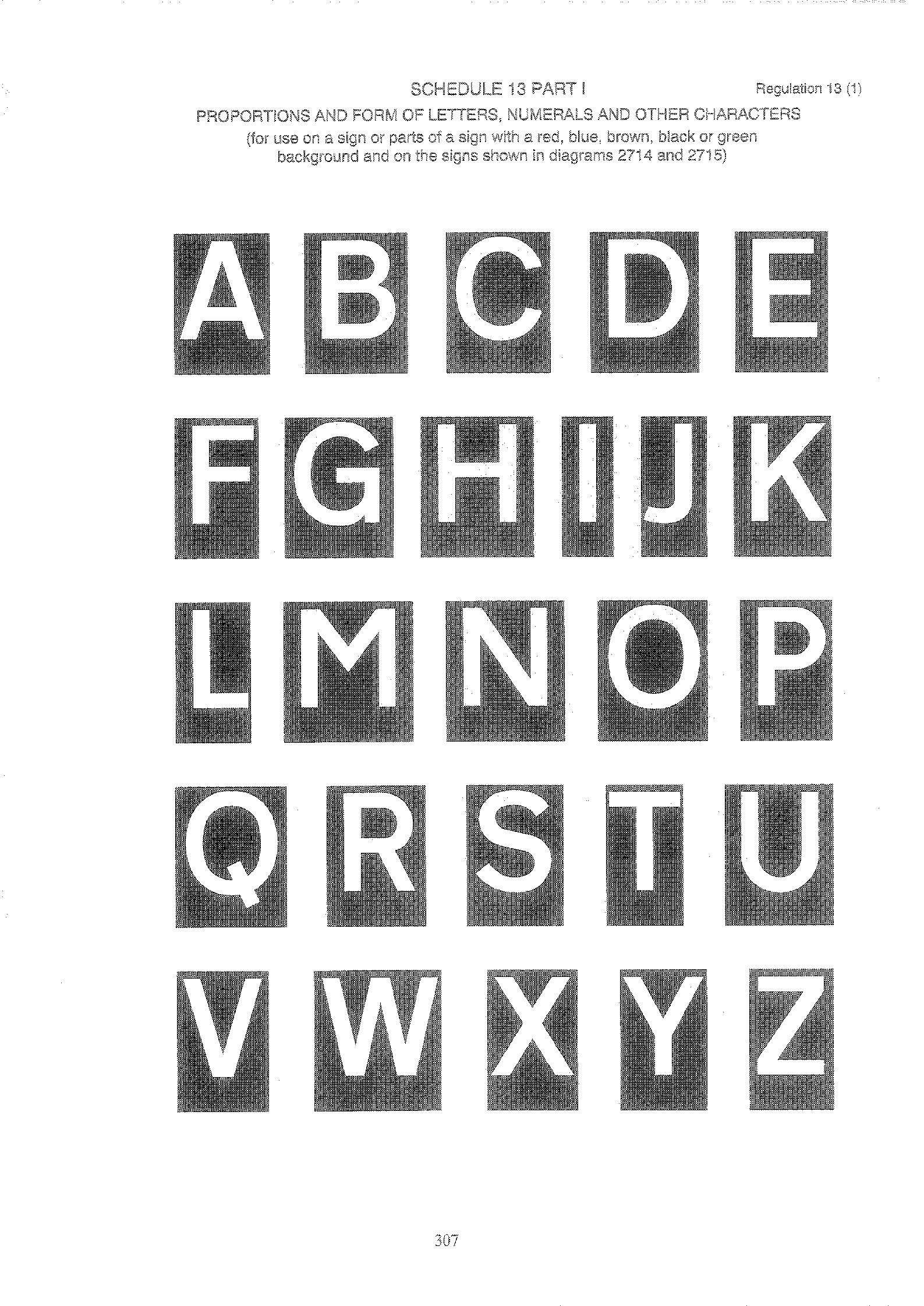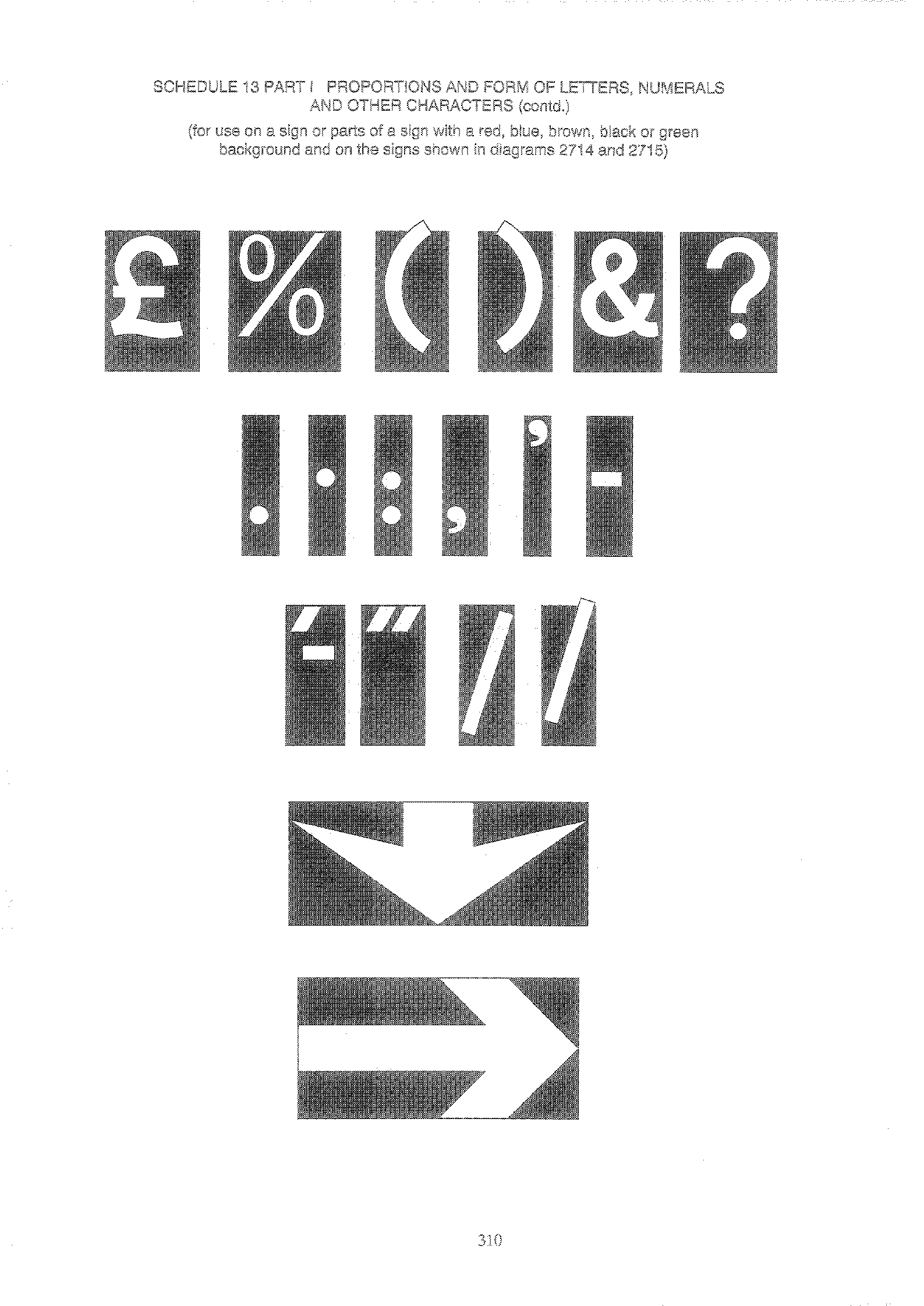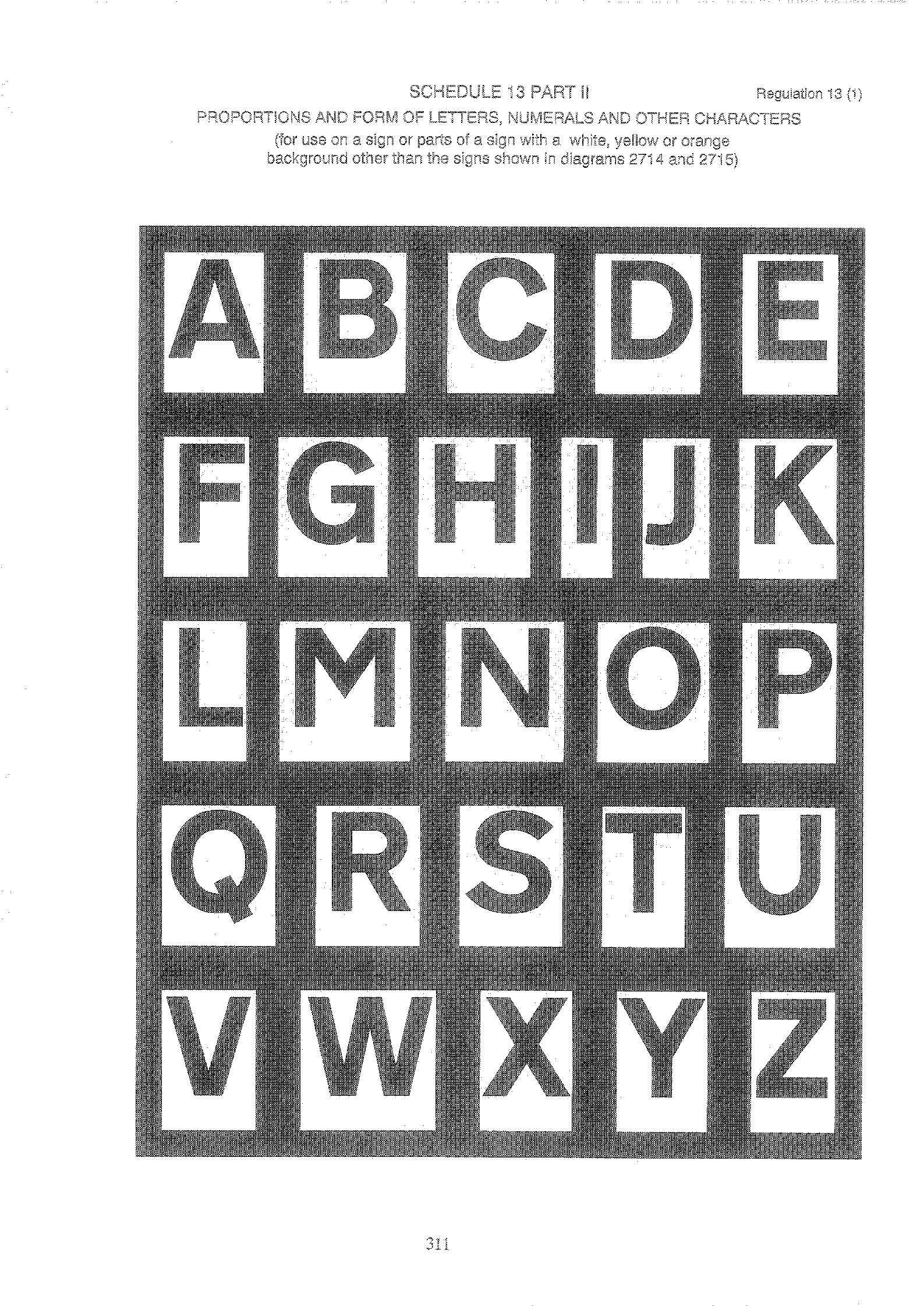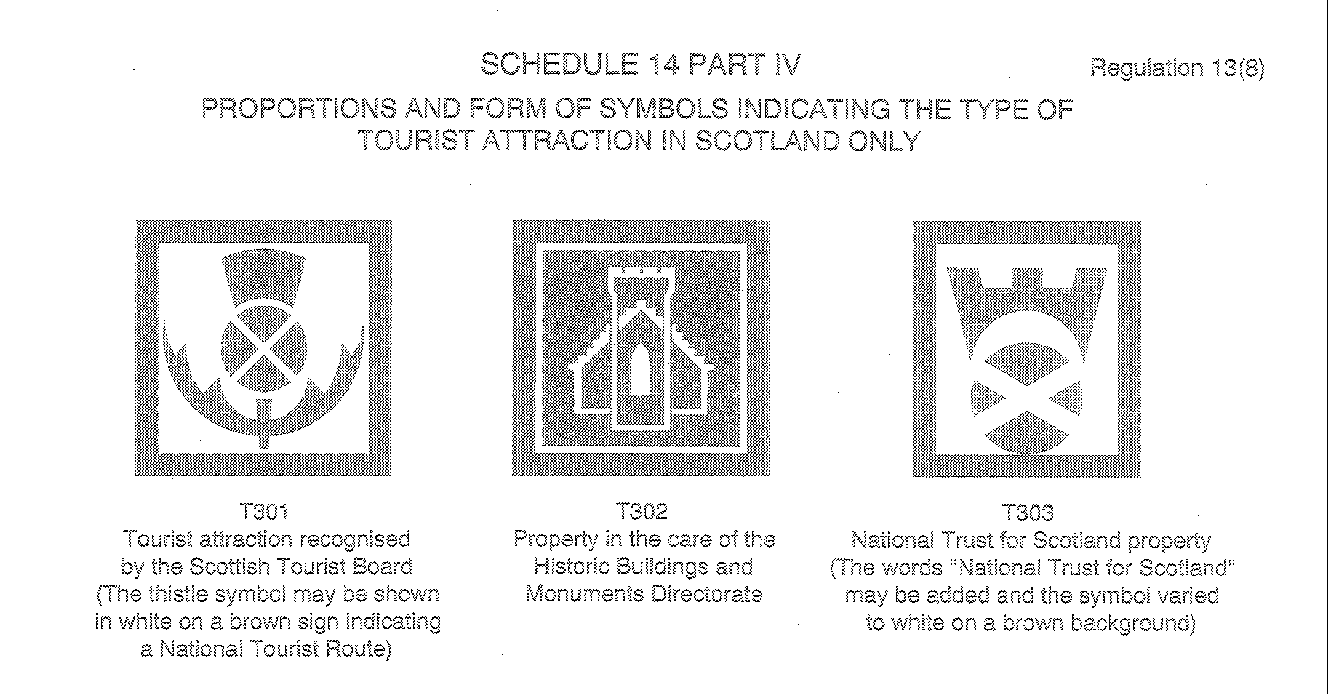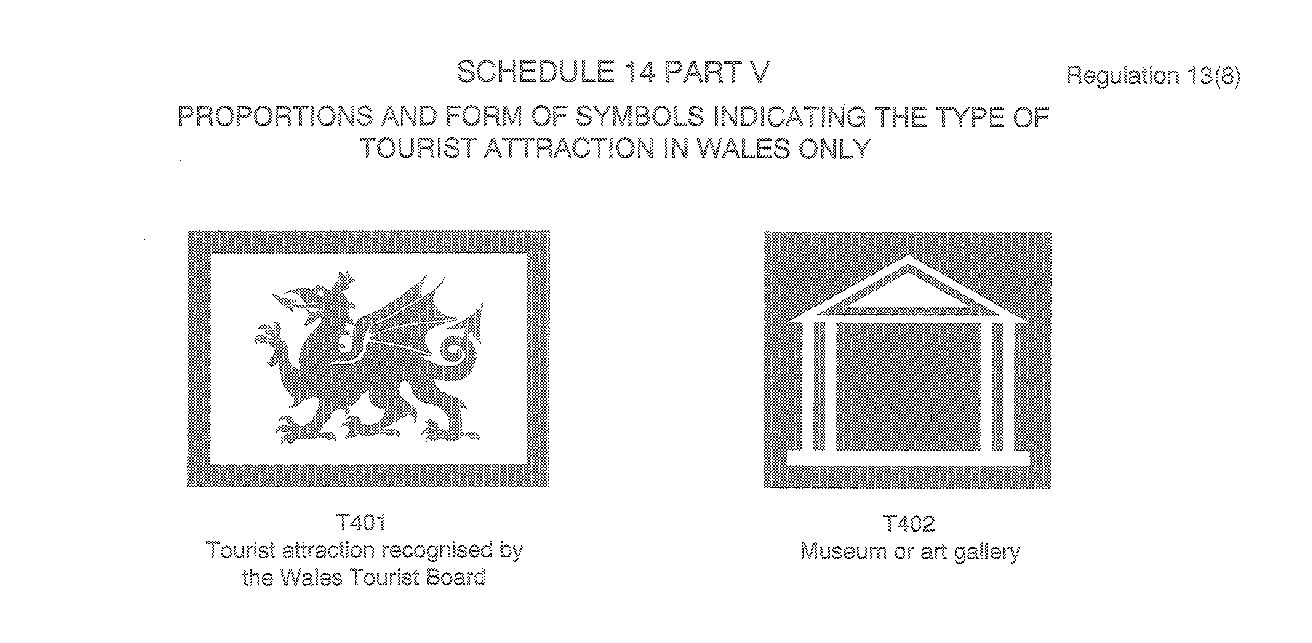- Y Diweddaraf sydd Ar Gael (Diwygiedig)
- Gwreiddiol (a wnaed Fel)
The Traffic Signs Regulations and General Directions 1994
You are here:
- Offerynnau Statudol y Deyrnas Unedig
- 1994 No. 1519
- Whole Instrument
- Blaenorol
- Nesaf
Rhagor o Adnoddau
Status:
Dyma’r fersiwn wreiddiol (fel y’i gwnaed yn wreiddiol). This item of legislation is currently only available in its original format.
Statutory Instruments
1994 No. 1519
ROAD TRAFFIC
The Traffic Signs Regulations and General Directions 1994
Made
26th May 1994
Laid before Parliament
22nd July 1994
Coming into force
12th August 1994
The Secretary of State for Transport, the Secretary of State for Scotland and the Secretary of State for Wales, acting in the manner and in exercise of the powers specified in Appendix 1 to this Instrument, hereby—
of this Instrument.
PART ITHE TRAFFIC SIGNS REGULATIONS 1994
SECTION 1PRELIMINARY
Citation and commencement
1. This Part of this Instrument—
(a)may be cited—
(i)as the Traffic Signs Regulations 1994, and
(ii)together with Part II below, as the Traffic Signs Regulations and General Directions 1994; and
(b)shall come into force on 12th August 1994.
Revocations
2. The Instruments specified in Appendix 2 to this Instrument, so far as they consist of or comprise regulations, are hereby revoked except that for the purposes of the Traffic Signs (Welsh and English Language Provisions) Regulations 1985(3) the revocations of the Regulations marked with an asterisk in Appendix 2 shall have no effect.
Savings
3.—(1) Subject to paragraph (2), any traffic sign which immediately before the coming into force of these Regulations is placed on or near any road shall be treated as prescribed by these Regulations, notwithstanding any provisions of these Regulations to the contrary, provided that—
(a)it is a sign prescribed, or to be treated as if prescribed, by the 1981 Regulations; and
(b)it continues to comply with those Regulations,
as if those Regulations had not been revoked.
(2) Paragraph (1) shall cease to have effect—
(a)on 1st January 1996 in relation to any road markings shown in diagrams RM 2 to RM 29 in the Second Schedule to the Traffic Signs Regulations 1957(4), in relation to the sign shown in diagram 623 in Schedule 1 and any road markings shown in diagrams 1005 to 1008, 1013, 1015, 1016, 1027, 1028, 1030, 1031 and 1034 to 1039 in Schedule 2 to the Traffic Signs Regulations 1964(5); and
(b)on 1st January 1999 in relation to any sign shown in any of the diagrams 508, 509, 537.1, 537.2, 537.3, 537.4, 542.1, 542.2, 554 (when varied to “Ice” or “Snowdrifts”), 556.3, 556.4, 577, 603, 605.1 and 622.1A (when varied to indicate a 16.5 tonne maximum gross weight prohibition) in Schedule 1 and diagrams 1016.1, 1018, 1020 and 1021 in Schedule 2 to the 1981 Regulations; and
(c)on 1st January 2005 in relation to any sign shown in any of the diagrams 403 to 405, 412A to 418, 422 to 433, 435 to 459, 468 to 472, and 474 to 495 in the First Schedule to the Traffic Signs Regulations 1957, in diagrams 742, 746, 837, and 838 in Schedule 1 to the Traffic Signs Regulations 1964, and in diagrams 626.1, 627, 628.1, 641, 642.1, 653, 734.7, 739.3, 742.1, 742.2, 742.3, 742.4, 742.5, 742.6, 747, 748, 749, 750, 751, 752, 752.1, 753, 753.1, 758, 759, 837.1, 838.1 and 905 in Schedule 1 to the 1981 Regulations; and
(d)on 1st January 2015 in relation to any sign shown in diagrams 728.1, 728.2, 729, 729.1, 729.2, 729.3, 730, 730.1, 732, 732.1, 732.2, 733, 733.1, 734.1, 734.2, 734.3, 734.4, 734.5, 734.6, 734.8, 734.9, 734.10, 736, 736.1, 737.1, 760 and 761 in Schedule 1 to the 1981 Regulations.
(3) A sign which is of the size, colour and type shown in diagram 701, 702, 702.1, 703, 703.1, 703.2, 703.3, 704, 705, 706, 707, 708, 709, 710, 710.1, 711.1, 712, 712.1, 713, 714, 715, 716, 717, 718, 718.1, 718.2, 718.3, 719, 719.1, 719.2, 719.3A, 719.4, 720, 721.1, 722, 723, 724, 724.1, 724.2, 725, 726, 727, 727.2, 728, 728.1, 728.2, 728.3, 729, 729.1, 729.2, 729.3, 730, 730.1, 732, 732.1, 732.2, 732.4, 732.5, 733, 733.1, 734.1, 734.2, 734.3, 734.4, 734.5, 734.6, 734.7, 734.8, 734.9, 734.10, 735.1, 735.2, 736, 736.1, 737.1, 739, 739.1, 739.2, 739.3, 739.4, 739.5, 741, 741.1 or 905 in Schedule 1 to the 1981 Regulations may be erected on or near a road after the coming into force of these Regulations, notwithstanding that it is not of the size, colour and type shown in any diagram in these Regulations, provided that the design or manufacture of the sign had begun before the coming into force of these Regulations.
Interpretation general
4. In these Regulations unless the context otherwise requires—
“the 1984 Act” means the Road Traffic Regulation Act 1984;
“the 1988 Act” means the Road Traffic Act 1988;
“the 1981 Regulations” means the Traffic Signs Regulations and General Directions 1981(6);
“articulated vehicle” means a motor vehicle with a trailer so attached to it as to be partially superimposed upon it;
“automatic half-barrier level crossing” means a level crossing where barriers are installed to descend automatically across part of the road when a railway vehicle or tramcar approaches and the operation of the barriers is monitored remotely from the crossing;
“automatic barrier crossing (L)” means a level crossing where barriers are installed to descend automatically across part of the road when a railway vehicle or tramcar approaches and the driver of the railway vehicle or tramcar is required to monitor the operation of the barriers when the railway vehicle or tramcar is at or near the crossing;
“automatic open crossing (L)” means a level crossing without automatic barriers where light signals are so installed as to be operated automatically by a railway vehicle or tramcar approaching the crossing and the driver of the railway vehicle or tramcar is required to monitor the operation of the light signals when the railway vehicle or tramcar is at or near the crossing;
“automatic open crossing (R)” means a level crossing without automatic barriers where light signals are so installed as to be operated automatically by a railway vehicle or tramcar approaching the crossing and the operation of the light signals is monitored remotely from the crossing;
“automatic level crossing” means an automatic half-barrier level crossing, an automatic barrier crossing (L), an automatic open crossing (L) or an automatic open crossing (R);
“central reservation” means—
any land between the carriageways of a road comprising two carriageways; or
any permanent work (other than a traffic island) in the carriageway of a road,
which separates the carriageway or, as the case may be, the part of the carriageway which is to be used by traffic moving in one direction from the carriageway or part of the carriageway which is to be used (whether at all times or at particular times only) by traffic moving in the other direction;
“contra-flow” means a part of a carriageway of a road where—
traffic is authorised to proceed in the opposite direction to the usual direction of traffic on that part; or
a specified class of traffic is authorised to proceed in the opposite direction to other traffic on that carriageway;
“cycle lane” means a part of the carriageway of a road which—
starts with the marking shown in diagram 1009; and
is separated from the rest of the carriageway—
if it may not be used by vehicles other than pedal cycles, by the marking shown in diagram 1049; or
if it may be used by vehicles other than pedal cycles, by the marking shown in diagram 1004 or 1004.1;
“dual carriageway road” means a road which comprises a central reservation;
“enactment” includes any Act or subordinate legislation as defined in section 21(1) of the Interpretation Act 1978(7);
“excursion or tour” has the meaning given in section 137(1) of the Transport Act 1985(8);
“goods vehicle” means a motor vehicle or trailer constructed or adapted for use for the carriage or haulage of goods or burden of any description;
“hours of darkness” means the time between half an hour after sunset and half an hour before sunrise;
“level crossing” means a place where a road is crossed by a railway or a tramway on a reserved track on the level;
“local bus” means a public service vehicle used for the provision of a local service not being an excursion or tour;
“local service” has the meaning given in section 2 of the Transport Act 1985;
“major road” means the road at a road junction into which there emerges vehicular traffic from a minor road;
“manually operated” means a change from one sign to another or one signal aspect to another set in process by an operator;
“maximum gross weight” means—
in the case of a motor vehicle not drawing a trailer or in the case of a trailer, its maximum laden weight;
in the case of an articulated vehicle, its maximum laden weight (if it has one) and otherwise the aggregate maximum laden weight of all the individual vehicles forming part of that articulated vehicle; and
in the case of a motor vehicle (other than an articulated vehicle) drawing one or more trailers, the aggregate maximum laden weight of the motor vehicle and the trailer or trailers drawn by it,
and the foregoing references to the maximum laden weight of a vehicle (including a vehicle which is a trailer) are references—
in the case of a vehicle as respects which a gross weight not to be exceeded in Great Britain is specified in construction and use requirements (as defined by section 41(8) of the 1988 Act), to the weight so specified, or
in the case of a vehicle as respects which no such weight is so specified, to the weight which the vehicle is designed or adapted not to exceed when in normal use and travelling on a road laden.
“minor road” means a road on which, at its junction with another road, there is placed the sign shown in diagram 601.1 or 602 or the road marking shown in diagram 1003;
“mobile road works” means works on a road carried out by or from a vehicle or vehicles which move slowly along the road or which stop briefly from time to time along that road;
“motorway” means a special road—
which in England or Wales (save as otherwise provided by or under regulations made under, or having effect as if made under, section 17 of the 1984 Act) can only be used by traffic of Class I or II as specified in Schedule 4 to the Highways Act 1980(9); or
which in Scotland can only be used by traffic of Class I or Class II as specified in Schedule 3 to the Roads (Scotland) Act 1984(10);
“non-primary route” means a route, not being a primary route or a motorway or part of a primary route or of a motorway;
“passenger vehicle” means a vehicle constructed or adapted for the carriage of passengers and their effects;
“pedal cycle” means a unicycle, bicycle, tricycle, or cycle having four or more wheels, not being in any case mechanically propelled unless it is an electrically assisted pedal cycle of such class as is to be treated as not being a motor vehicle for the purposes of the 1984 Act;
“pedestrian zone” means an area—
which has been laid out to improve amenity for pedestrians; and
to which the entry of vehicles is prohibited or restricted;
“Pelican crossing” means a pedestrian crossing which conforms to The “Pelican” Pedestrian Crossings Regulations and General Directions 1987(11);
“plate” means a sign which by virtue of general directions given in exercise of the power conferred by section 65 of the 1984 Act must always be placed in combination or in conjunction with another sign and which is supplementary to that other sign;
“police vehicle” means a vehicle being used for police purposes or operating under the instructions of a chief officer of police;
“primary route” means a route, not being a route comprising any part of a motorway, in respect of which the Secretary of State—
in the case of a trunk road is of the opinion, and
in any other case after consultation with the traffic authority for the road comprised in the route is of the opinion,
that it provides the most satisfactory route for through traffic between places of traffic importance;
“principal road” means a road for the time being classified as a principal road—
by virtue of section 12 of the Highways Act 1980 (whether as falling within subsection (1) or classified under subsection (3)), or
by the Secretary of State under section 11(1) of the Roads (Scotland) Act 1984;
“public service vehicle” has the meaning given in section 1 of the Public Passenger Vehicles Act 1981(12);
“retroreflecting material” means material which reflects a ray of light back towards the source of that light;
“road maintenance vehicle” means a vehicle which—
in England and Wales is specially designed or adapted for use on a road by or on behalf of a highway authority for the purposes of the Highways Act 1980 for the purposes of road maintenance; or
in Scotland is specially designed or adapted for use on a road by or on behalf of a roads authority for the purposes of the Roads (Scotland) Act 1984(13) for the purposes of road maintenance;
“road marking” means a traffic sign consisting of a line or mark or legend on a road;
“route” includes any road comprised in a route;
“scheduled express service” means a service provided by a public service vehicle—
used to carry passengers for hire or reward at separate fares otherwise than in the provision of a local service; and
which is operated in accordance with a timetable;
“school bus” means a vehicle constructed or adapted to carry 12 or more passengers and being used to carry persons to or from a school as defined in section 114(1) of the Education Act 1944(14) and, in Scotland, as defined in the Education (Scotland) Act 1980(15);
“sign” means a traffic sign;
“stud” means a prefabricated device fixed or embedded as a mark in the carriageway of a road;
“taxi” means—
in England and Wales, a vehicle licensed under—
or under any similar enactment; and
in Scotland, a taxi licensed under section 10 of the Civic Government (Scotland) Act 1982(18);
“taxi rank” means an area of carriageway reserved for use by taxis waiting to pick up passengers;
“temporary statutory provision” means—
a provision having effect under section 9 (experimental traffic orders), section 12 (experimental traffic schemes in Greater London) or section 14 (temporary restriction of traffic on roads) of the 1984 Act or under a provision referred to in section 66 (traffic signs for giving effect to local traffic regulations) of that Act;
a prohibition, restriction or requirement indicated by a traffic sign placed pursuant to section 67 (emergencies and temporary obstructions) of the 1984 Act; or
a provision having effect under section 62 (temporary prohibition or restriction of traffic etc on roads for reasons of safety or public convenience) of the Roads (Scotland) Act 1984;
“terminal sign” means a sign placed in accordance with direction 8 or 9 of the Traffic Signs General Directions 1994(19);
“tourist attraction” means a permanently established excursion destination which—
is recognised by a local authority, the English Tourist Board, the Scottish Tourist Board or the Wales Tourist Board;
caters primarily for visitors to the area in which the attraction is located rather than for local residents;
is open to the public without prior booking during its normal opening hours; and
does not have retailing or catering as its main purpose;
“Tourist Information Centre” means a staffed information service centre recognised and supported by the English, Scottish or Wales Tourist Board;
“Tourist Information Point” means a display of tourist information approved by a regional, area or local tourist board;
“traffic lane” means, in relation to a road, a part of the carriageway having, as a boundary which separates it from another such part, a road marking of the type shown in diagram 1004, 1004.1, 1005, 1005.1, 1008, 1008.1, 1010, 1013.1, 1013.3, 1040, 1040.2 or 1049;
“tramcar” has the meaning given in section 141A(4) of the 1984 Act(20);
“trolley vehicle” has the meaning given in section 141A(4) of the 1984 Act;
“trunk road” as respects England and Wales has the meaning given in section 329(1) of the Highways Act 1980 and as respects Scotland in section 151(1) of the Roads (Scotland) Act 1984;
“unladen vehicle” has the meaning given in Schedule 18;
“variable message sign” has the meaning given in regulation 46(1);
“with-flow lane” means a traffic lane reserved for a specified class of traffic proceeding in the same direction as general traffic in an adjoining traffic lane; and
“works bus” means a vehicle constructed or adapted to carry 12 or more passengers (excluding the driver) which has been provided by an employer for the purpose of carrying persons employed by him or on his behalf to or from their place of employment and is being used for that purpose.
Interpretation of “speed limit”
5.—(1) In these Regulations “speed limit” means—
(a)a maximum or minimum limit of speed on the driving of vehicles on a road—
(i)imposed by an order under section 14 of the 1984 Act (temporary prohibition or restriction of traffic on roads);
(ii)imposed by regulations under section 17 of the 1984 Act (traffic regulation on special roads);
(iii)arising by virtue of the road being restricted for the purposes of section 81 of the 1984 Act (general speed limit for restricted roads);
(iv)imposed by an order under section 84 of the 1984 Act (speed limits on roads other than restricted roads);
(v)imposed by an order under section 88 of the 1984 Act (temporary speed limits); or
(vi)imposed by or under a local Act; or
(b)a maximum limit of speed on the driving of vehicles on a road advised by a traffic authority,
and “maximum speed limit” and “minimum speed limit” should be construed accordingly.
(2) In these Regulations “national speed limit” means any prohibition imposed on a road by the 70 miles per hour, 60 miles per hour and 50 miles per hour (Temporary Speed Limit) Order 1977(21) or by regulation 3 of the Motorways (Speed Limit) Regulations 1974(22).
References in the Regulations
6. In these Regulations, unless it is expressly provided otherwise or the context otherwise requires—
(a)a reference to a numbered regulation is a reference to the regulation so numbered in these Regulations;
(b)a reference to a numbered paragraph is a reference to the paragraph so numbered in the regulation in which the reference occurs;
(c)a reference to a sub-paragraph followed by a number or letter is a reference to the sub-paragraph bearing that number or letter in the paragraph in which the reference occurs;
(d)a reference to a numbered diagram is a reference to the diagram so numbered in a Schedule to these Regulations;
(e)a reference to a sign or road marking shown in a diagram in a Schedule to these Regulations means a sign or road marking of the size, colour and type shown in that diagram and prescribed by these Regulations and includes a reference to that sign or road marking as varied in accordance with these Regulations;
(f)a reference to the information, warning, requirement, restriction, prohibition or speed limit conveyed by a sign shown in a diagram includes a reference to that information, warning, requirement, restriction, prohibition or speed limit, however expressed, as varied to accord with any variation of the diagram made in accordance with these Regulations; and
(g)in any provision which includes a table, references to a table or to a numbered table are to the table or as the case may be to the table so numbered in that provision.
Interpretation of Schedules 1 to 12
7.—(1) In any untitled table under or beside any diagram (in this paragraph referred to as “the diagram”) in Schedules 1 to 12—
(a)in item 1 any regulations which are specified are regulations in these Regulations in which a specific reference is made to the diagram;
(b)in item 2 any directions which are specified are directions in the Traffic Signs General Directions 1994(23) in which a specific reference is made to the diagram;
(c)in item 3 any diagrams which are specified are diagrams in the Schedules to these Regulations which show signs which may or must be placed in conjunction or in combination with the sign shown in the diagram;
(d)in item 4 any item which is specified is an item in Schedule 16 which specifies permitted variants to the diagram; and
(e)in item 5 any item which is specified is an item in Schedule 17 which specifies the illumination requirements for the sign shown in the diagram.
(2) The table entitled “Table of combinations” under or beside any diagram in Part III of Schedule 12 indicates the manner in which the sign shown in that diagram may be varied in accordance with paragraphs (6) to (8) of regulation 17.
(3) Dimensions indicated on any diagram shown in Schedules 1 to 12 are expressed in millimetres unless otherwise specified.
SECTION 2GENERAL PROVISIONS
Authorisations by the Secretary of State
8. Nothing in these Regulations shall be taken to limit the powers of the Secretary of State under section 64 of the 1984 Act to authorise the erection or retention of traffic signs of a character not prescribed by these Regulations.
Temporary obstructions
9. Nothing in these Regulations shall have effect so as to authorise any persons not otherwise authorised to do so to place on or near a road any object or device for warning traffic of a temporary obstruction.
Application of section 36 of the Road Traffic Act 1988 to signs and disqualification for offences
10.—(1) Section 36 of the 1988 Act shall apply to—
(a)the signs shown in any of the diagrams 601.1, 602, 606, 610, 611.1, 614, 616, 626.2, 629.2, 629.2A, 784, 953, 953.1 and 7023 and to the sign shown in diagram 602 when placed in combination with that shown in diagram 778 or 778.1;
(b)the red light signal when displayed by the light signals prescribed by regulation 30 or by regulation 32;
(c)the road markings shown in diagram 1013.1 or 1013.3 insofar as those markings convey the requirements specified in regulation 26;
(d)the road marking shown in diagram 1003 insofar as that marking conveys the requirements specified in regulation 25;
(e)the road markings shown in diagrams 1043, 1044 and 1045;
(f)the light signals prescribed by regulation 30(2) as varied in accordance with regulation 31 when they are displaying the green arrow signals shown in diagrams 3000.4, 3000.6, 3002, 3003, 3004, 3005, 3006, 3007, 3008, 3009.1, 3011.1 and 3011.2 insofar as they convey the restrictions specified in paragraphs (1)(f) and (1)(g) of regulation 33; and
(g)the light signal shown in diagram 3013.1.
(2) The signs hereby specified for the purposes of column 5 of the entry in Schedule 2 to the Road Traffic Offenders Act 1988(24) relating to offences under section 36 of the 1988 Act are:–
(a)the signs shown in diagrams 601.1 and 616;
(b)the signs shown in diagrams 629.2 and 629.2A;
(c)the sign shown in diagram 784;
(d)the red light signal when displayed by the light signals prescribed by regulation 30 or by regulation 32;
(e)the road markings shown in diagram 1013.1 or 1013.3 insofar as those markings convey the requirements specified in regulation 26(2); and
(f)the light signals prescribed by regulation 30(2) when they are displaying the green arrow signals shown in diagrams 3000.4, 3000.6, 3002, 3003, 3004, 3005, 3006, 3007, 3008, 3009.1, 3011.1 and 3011.2 insofar as they convey the restrictions specified in paragraphs (1)(f) and (1)(g) of regulation 33.
Signs, markings and signals to be of the sizes, colours and types shown in the diagrams
11.—(1) Subject to the provisions of these Regulations, a sign for conveying information or a warning, requirement, restriction, prohibition or speed limit of the description specified under a diagram in Schedules 1 to 7, Part II of Schedule 10 and Schedule 12 to traffic on roads shall be of the size, colour and type shown in the diagram.
(2) The signs shown in diagrams 515.1, 515.1A, 515.2, 1012.2, 1012.3, 1049.1 and 7102 shall be of the size, colour and type shown in the two parts of those diagrams.
(3) In Schedule 6, a road marking shown in a diagram as a horizontal line shall be laid transversely, and a marking shown as a vertical line shall be laid longitudinally, to the flow of traffic, except so far as the nature of the diagram or the caption to the diagram indicates that it may or should be laid in another direction.
(4) The road marking shown in diagram 1055 shall be white, silver or light grey in colour.
Variations of dimensions
12.—(1) Where any diagram in Schedules 1 to 12 specifies a dimension for an element of a sign together with a dimension for that element in brackets, the dimensions so specified shall, subject to paragraph (2), be alternatives.
(2) Subject to paragraphs (3) and (4), where alternative dimensions are specified for more than one element of a sign, the dimensions chosen for each element must correspond with one another so that the shape and proportions of the sign are as shown in the diagram.
(3) Paragraph (2) does not apply to the road marking shown in diagram 1009 and the respective lengths of the lines comprised in that sign and of the gaps between them may be either—
(a)600 and 300 millimetres, in which case the width of the lines may be 100, 150 or 200 millimetres; or
(b)300 and 150 millimetres, in which case the width of the lines shall be 100 millimetres.
(4) Paragraph (2) does not apply to the road markings shown in diagrams 1013.3, 1035, 1036.1, 1036.2, 1037.1, 1040, 1040.2, 1040.4 and 1041.
(5) Where any diagram in Schedules 1 to 12 specifies a maximum and a minimum dimension for an element of a sign, the dimension chosen for that element shall, subject to the footnote to Table 1, be not more than the maximum and not less than the minimum.
(6) Where maximum and minimum dimensions are specified for more than one element of a sign, the dimensions chosen for each element must correspond with one another so that the shape and proportions of the sign are as shown in the diagram.
(7) Where a sign shown in diagram 606, 607, 609, 610, 611, 611.1, 612, 613, 614, 616, 636, 638, 642, 643, 644 or 645 is placed temporarily on a road by a constable or a person acting under the instructions (whether general or specific) of the chief officer of police for the purposes of indicating a temporary statutory provision, any dimension in the diagram for the diameter of a roundel, or for the sign may be reduced so long as any dimension shown in the diagram for the diameter of a roundel or for the measurement horizontally of the sign is at least 200 millimetres, and the height of any lettering is at least 20 millimetres.
(8) Any sign shown in diagrams 960, 960.1, 7201, 7202, 7203, 7203.1, 7204, 7205, 7206, 7207, 7210, 7211, 7212, 7213, 7214, 7215, 7216, 7217, 7218, 7220, 7221, 7230, 7231, 7232, 7233, 7234, 7235, 7236, 7237, 7238, 7239, 7240, 7250, 7251, 7252, 7253, 7254, 7255, 7256 or in a diagram in Schedule 7 (other than diagrams 2032, 2130, 2208, 2708, 2711, 2712, 2713, 2714, 2715, 2922, 2923 and 2932) shall be of such dimensions as, having regard to the character of the road and the speed of the vehicular traffic generally using it, are necessary to accommodate any place name, route symbol or number, arrow, indication of distance, symbol or any other indication which, in accordance with these Regulations, may be shown on the sign and which it is appropriate to show for the purpose for which that sign is placed on the road.
(9) Any sign shown in a diagram in Part III of Schedule 12 shall be of such dimensions as, having regard to the character of the road and the speed of traffic generally using it, are necessary to accommodate the route symbols or arrows appropriate to the number of traffic lanes and the nature of the road works in relation to which the sign is placed.
(10) Any dimension (not being an angle or specified as a maximum or minimum) specified in these Regulations shall be treated as permitted by these Regulations if it is varied in accordance with the following Tables, subject, in the case of Tables 1 and 2, to the Notes to those Tables.
Table 1
Diagrams in Schedules 1 to 5, 7, 10 and 12 Height of letters or numbers
| (1) | (2) | (3) |
|---|---|---|
| Item | Dimensions shown in diagrams | Permitted variations |
NOTE: Where the height of letters or numbers is expressed as a range within maximum and minimum dimensions the permitted variations indicated in this Table shall apply to those dimensions shown as the maximum and minimum. | ||
| 1. | 100 millimetres or more | Up to 5% of the dimension |
| 2. | Less than 100 millimetres | Up to 7.5% of the dimension |
Table 2
Diagrams in Schedule 6 All dimensions
| (1) | (2) | (3) |
|---|---|---|
| Item | Dimensions shown in diagrams | Permitted variations |
NOTE: Where a dimension denoting the length or width of a road marking is varied in accordance with this Table, and there is a space between two parts of the marking, the dimensions of that space may be varied as required to accommodate the variation of the length or width of the marking, provided that the character of the marking is maintained. | ||
| 1. | 3 metres or more | (i)Up to 15% of the dimension where the varied dimension is greater than the specified dimension; or (ii)Up to 10% of the dimension where the varied dimension is less than the specified dimension. |
| 2. | 300 millimetres or more, but less than 3 metres | (i)Up to 20% of the dimension where the varied dimension is greater than the specified dimension; or (ii)Up to 10% of the dimension where the varied dimension is less than the specified dimension. |
| 3. | 10 millimetres or more but less than 300 millimetres | (i)Up to 30% of the dimension where the varied dimension is greater than the specified dimension; or (ii)Up to 10% of the dimension where the varied dimension is less than the specified dimension. |
| 4. | Less than 10 millimetres | (i)Up to 2 millimetres more than the dimension where the varied dimension is greater than the specified dimension; or (ii)Up to 1 millimetre less than the dimension where the varied dimension is less than the specified dimension. |
Table 3
All dimensions other than those in Tables 1 and 2
| (1) | (2) | (3) |
|---|---|---|
| Item | Dimensions shown in diagrams | Permitted variations |
| 1. | 300 millimetres or more | Up to 5% of the dimension |
| 2. | 50 millimetres or more, but less than 300 millimetres | Up to 7.5% of the dimension |
| 3. | Less than 50 millimetres | Up to 10% of the dimension |
(11) Any variation of any angle specified in any diagram in Schedule 1, 6 or 8, except diagrams 1043 and 1044, shall be treated as permitted by these Regulations if the variation does not exceed 5 degrees.
(12) Where—
(a)overall dimensions are given for a sign shown in any diagram in the Schedules to these Regulations; and
(b)the legend on that sign is varied in accordance with regulation 17 and with item 4 of the table appearing under or beside that diagram,
the overall dimensions or the number of lines filled by the legend, or both, may be varied so far as necessary to give effect to the variation of the legend.
Proportions and form of letters, numerals, symbols and other characters
13.—(1) Subject to paragraphs (2), (3) and (5)
(a)all letters, numerals and other characters incorporated in the signs or parts of the signs shown in the diagrams in Schedules 1 to 5, 7, 10 and 12 which have a red, blue, brown, black or green background (other than those incorporated in the bottom panel of diagram 674, diagrams 973, 973.1, 2401, 2402, 2403, 2607, 2610, 2610.1, 2610.2, the top panels of diagrams 2919 and 2920, the petrol price display in diagram 2919, and diagrams 5001.1, 5001.2, 5003, 5003.1, 5005 and 5005.1, the top and bottom panels of diagram 7008 and the words “National Trust for Scotland” used in conjunction with the symbol shown in diagram T303 in Part IV of Schedule 14) and the signs shown in diagrams 2714 and 2715 shall have the proportions and form shown in Part I of Schedule 13; and
(b)all letters, numerals and other characters incorporated in the signs or the parts of signs shown in the diagrams in Schedules 1 to 5, 7, 10 and 12 which have a white, yellow or orange background (other than those incorporated in the bottom panel of diagram 674, diagrams 973, 973.1, 2401, 2402, 2403, 2610, 2610.1, 2610.2, 2714, 2715, the top panels of diagrams 2919 and 2920, and the top and bottom panels of diagram 7008) shall have the proportions and form shown in Part II of Schedule 13.
(2) Letters and numerals used for the purpose of indicating a route number on any sign shown in a diagram in Part X of Schedule 7 (other than those incorporated in diagram 2913 and 2914) shall have the proportions and form shown in Part III of Schedule 13, except where a route number is indicated in brackets on a sign shown in diagram 2904, 2904.1, 2906, 2908 or 2909 in which case those letters and numerals shall have the proportions and form shown in either Part I or Part III of Schedule 13 as appropriate.
(3) Letters and numerals used for the purpose of indicating a route number on any sign shown in a diagram in Part III of Schedule 12 when used on a motorway shall have the proportions and form shown in Part IV of Schedule 13.
(4) Subject to and within the limits of any dimension specified as a maximum or minimum in diagrams 973, 973.1, 2401, 2402, 2403, 2607, 2610, 2610.1, 2610.2, the top panels of diagrams 2919 and 2920, the petrol price display in diagram 2919, and the top and bottom panels of diagram 7008 any letters or numerals or other characters incorporated in those diagrams may have proportions and form other than the proportions and form shown in Schedule 13.
(5) All letters, numerals, symbols and other characters incorporated in variable message signs shall have the general proportions and form shown in Part V of Schedule 13 where the construction or method of operation of the sign does not permit the use of letters, numerals and other characters of the proportions and form shown in Part I, II, III or IV of Schedule 13 or of symbols shown in diagrams in Schedules 1 to 5, 10 or 12.
(6) All letters, numerals and other characters incorporated in the road markings shown in the diagrams in Schedule 6 shall have the proportions and form shown in Part VI of Schedule 13.
(7) Symbols incorporated in signs for the purpose of indicating diversion routes to be followed in an emergency shall have the proportions and form shown in Part VII of Schedule 13.
(8) Symbols incorporated in signs for the purpose of indicating the type of a tourist attraction shall have the proportions and form shown in Schedule 14.
Signs attached to vehicles
14.—(1) A sign attached to a vehicle of the description and in the position on that vehicle specified in an item in column (2) of the Table, when the vehicle is on a road which is subject to a maximum speed limit specified in column (3) of that item, shall be of the size, colour and type shown in one of the diagrams specified in column (4) of that item.
Table
| (1) | (2) | (3) | (4) |
|---|---|---|---|
| Item | Description of vehicle, and position | Maximum speed limit | Diagram numbers |
| 1. | Road maintenance vehicle, on the front | 30 mph or under | 610, 7001 and 7001.1 |
| 2. | Road maintenance vehicle, on the rear | 30 mph or under | 610, 7001, 7001.1, 7401, 7401.1, 7402, 7403 and 7404 |
| 3. | Road maintenance vehicle, on the rear | More than 30 mph | 7401, 7401.1, 7402, 7403 and 7404 |
| 4. | Police vehicle, on the front or the rear | 70 mph or under | 829.1, 829.2, 829.3 and 829.4 |
(2) The operating requirements for the lamps that form part of the signs shown in diagrams 7401, 7402 and 7403 are that—
(a)the lamps shall be illuminated only when the signs are being used in accordance with the Table; and
(b)each lamp shall show an intermittent amber light at a rate of flashing of not less than 60 nor more than 90 flashes per minute, and in such a manner that the lights of one horizontal pair are always shown when the lights of the other horizontal pair are not shown.
SECTION 3WARNING, REGULATORY AND INFORMATORY TRAFFIC SIGNS
Sign shown in diagram 610 and its significance
15.—(1) Except as provided in paragraphs (2) and (3), the requirement conveyed by the sign shown in diagram 610 shall be that vehicular traffic passing the sign must keep to the left of the sign where the arrow is pointed downwards to the left, or to the right of the sign where the arrow is pointed downwards to the right.
(2) On an occasion where a vehicle is being used for fire brigade, ambulance or police purposes and the observance of the requirement specified in paragraph (1) would be likely to hinder the use of that vehicle for one of those purposes then, instead of that requirement, the requirement conveyed by the sign in question shall be that the vehicle shall not proceed beyond that sign in such a manner or at such a time as to be likely to endanger any person.
(3) The requirement specified in paragraph (1) does not apply to a tramcar or trolley vehicle.
Signs shown in diagrams 601.1, 602, 778, 778.1 and 784 and their significance
16.—(1) The requirements conveyed to vehicular traffic on roads by a sign shown in the diagram specified in column (2) of an item in the Table are specified in column (3) of that item.
Table
| (1) | (2) | (3) |
|---|---|---|
| Item | Diagram number | Requirements |
| 1. | 601.1 | (a)Every vehicle shall stop before crossing the transverse line shown in diagram 1002.1 or, if that line is not clearly visible, before entering the major road in respect of which the sign shown in diagram 601.1 has been provided; and (b)no vehicle shall cross the transverse line shown in diagram 1002.1 or, if that line is not clearly visible, enter the major road in respect of which the sign shown in diagram 601.1 has been provided, so as to be likely to endanger the driver of or any passenger in any other vehicle or to cause that driver to change the speed or course of his vehicle in order to avoid an accident. |
| 2. | 602 | No vehicle shall cross the transverse line shown in diagram 1003 nearer to the major road at the side of which that line is placed, or if that line is not clearly visible, enter that major road, so as to be likely to endanger the driver of or any passenger in any other vehicle or to cause that driver to change the speed or course of his vehicle in order to avoid an accident. |
| 3. | 602 when placed in combination with 778 or 778.1 | No vehicle shall cross the transverse line shown in diagram 1003 nearer to the level crossing at the side of which that line is placed, or if that line is not clearly visible, enter that level crossing, so as to be likely to endanger the driver of or any passenger in any railway vehicle or tramcar or to cause that driver to change the speed of his vehicle in order to avoid an accident. |
| 4. | 784 | No abnormal transport unit shall proceed onto or over an automatic half-barrier level crossing or an automatic open crossing (R) unless— (a) the driver of the unit has used a telephone provided at or near the crossing for the purpose of obtaining from a person, authorised in that behalf by the railway or tramway authority, permission for the unit to proceed; (b) that permission has been obtained before the unit proceeds; and (c) the unit proceeds in accordance with any terms attached to that permission. Provided that sub-paragraphs (b) and (c) above shall not apply if— (i) on the use by the driver of the telephone placed at or near the crossing he receives an indication for not less than two minutes that the telephone at the other end of the telephone line is being called, but no duly authorised person answers it, or he receives no indication at all due to a fault or malfunction of the telephone; and (ii) the driver then drives the unit on to the crossing with the reasonable expectation of crossing it within times specified in a railway or tramway notice at that telephone as being times between which railway vehicles or tramcars do not normally travel over that crossing. |
(2) In this regulation—
“abnormal transport unit” means—
a motor vehicle or a vehicle combination
the overall length of which, inclusive of the load (if any) on the vehicle or the combination, exceeds 55 feet; or
the overall width of which, inclusive of the load (if any) on the vehicle or the combination, exceeds 9 feet 6 inches; or
the maximum gross weight of which exceeds 38 tonnes; or
a motor vehicle, or a vehicle combination, which in either case is incapable of proceeding, or is unlikely to proceed, over an automatic railway level crossing at a speed exceeding 5 miles per hour;
“driver” in relation to an abnormal transport unit, means where that unit is a single motor vehicle the driver of that vehicle and, where that unit is a vehicle combination, the driver of the only or the foremost motor vehicle forming part of that combination; and
“vehicle combination” means a combination of vehicles made up of one or more motor vehicles and one or more trailers all of which are linked together when travelling.
Permitted variants
17.—(1) Where the circumstances in which a sign shown in a diagram in a Schedule (other than Schedule 6) to these Regulations is to be placed so require or where appropriate in those circumstances, the form of the sign shall or may be varied—
(a)in the manner (if any) allowed or required in item 4 of the untitled table below or beside the diagram; or
(b)in the manner allowed or required in column (3) of an item in Schedule 16, if the diagram is one whose number is given in column (2) of that item.
(2) A symbol in the form of a prescribed sign to which direction 7 of the Traffic Signs General Directions 1994 applies shall not be incorporated in a sign in accordance with item 31 of Schedule 16, except in circumstances where it could be placed as a sign in accordance with that direction.
(3) A symbol incorporated as mentioned in paragraph (2) shall or may be varied in the same manner as the sign which the symbol represents or from which it is derived.
(4) In each of the signs shown in diagrams 780, 780.1 and 780.2 the safe height shown on the sign shall be varied where necessary so that it is between 1 ½ and 2 feet (450 to 600 millimetres) less than the height of the lowest part of the overhead wire, of which the sign gives warning, over the highest part of the surface of the carriageway beneath that wire.
(5) Where a sign shown in a diagram in Schedule 7 indicates a road or a route, and that road or route is temporarily closed, there may be affixed to the sign or to that part of the sign where that road or route is indicated, in order to cancel temporarily the indication, a board coloured red and displaying in white lettering the words “Road temporarily closed” or “Route temporarily closed”.
(6) In this paragraph and paragraphs (7) and (8)—
(a)“combination sign” means a sign shown in diagram 7201, 7210, 7211, 7212, 7213, 7214, 7215, 7216, 7217, 7218, 7220, 7221, 7230, 7231, 7232, 7233, 7234, 7235, 7236, 7237, 7238, 7239 or 7240;
(b)“panel” means a sign shown in diagram 7260, 7261, 7262, 7263, 7264, 7270, 7271, 7272, 7273, 7274 or 7275 when used as part of a combination sign and references to a panel whose number is shown in a Table of combinations are to a sign shown in a diagram having a number so shown;
(c)“permitted combination” means one of the combinations specified in paragraph (8);
(d)“the table” in relation to a combination sign means the Table of combinations appearing below or beside the diagram in which that sign is shown;
(e)“top panel” means a panel shown at the top of a combination sign and “bottom panel” means a panel shown at the bottom of such a sign.
(7) If and only if the top and bottom panels of the sign as varied together constitute a permitted combination, a combination sign may be varied in the following ways—
(a)by substituting for the top panel or, where a top panel is not shown, by adding as a top panel, a panel whose number is shown in item (1) of the table;
(b)by substituting for the bottom panel or, where a bottom panel is not shown by adding as a bottom panel, a panel whose number is shown in item (2) of the table;
(c)if the word “none” appears in item (1) of the table, by omitting the top panel;
(d)if the word “none” appears in item (2) of the table, by omitting the bottom panel.
(8) Each of the following is a permitted combination—
(a)a top panel whose number appears in item (1) of a column in the table and a bottom panel whose number appears in item (2) of the same column;
(b)a top panel whose number appears in item (1) of a column in the table and, if the word “none” appears in item (2) of the same column, no bottom panel;
(c)a bottom panel whose number appears in item (2) of a column in the table and, if the word “none” appears in item (1) of the same column, no top panel;
(d)if the word “none” appears in both items of the same column of the table, no top panel and no bottom panel.
(9) Where the form of a sign is varied in accordance with these Regulations, the information, warning, requirement, restriction, prohibition or speed limit conveyed to traffic by the sign is varied to accord with the form of the sign as varied.
Illumination of signs
18.—(1) Subject to paragraph (2), every sign shown in a diagram whose number is indicated in column (2) of an item in Schedule 17 shall be illuminated in the manner and at the times described in column (3) of that item.
(2) Where a sign shown in a diagram whose number is indicated in column (2) of an item in Schedule 17 is placed for the purpose of conveying to vehicular traffic a warning, information, prohibition, restriction or requirement which applies only at certain times, the sign shall be illuminated in accordance with that Schedule only during those times.
(3) Where a sign shown in a diagram whose number is indicated in column (2) of an item in Schedule 17 is illuminated by means of external lighting, then that means of lighting shall be fitted to—
(a)the sign; or
(b)the structure on which the sign is mounted or which is otherwise specially provided,
except that if a sign is mounted on a bridge, tunnel or similar structure over a road the means of lighting may alternatively be mounted separately in a manner such as to illuminate the face of the sign effectively.
19.—(1) Nothing in this regulation shall apply to the signs shown in diagrams 560, 561, 776, 781, 5001.1, 5001.2, 5003, 5003.1, 5005 and 5005.1.
(2) Subject to the provisions of regulation 18 and paragraph (1), any sign shown in a diagram in Schedules 1 to 5, 7, 10 and 12—
(a)when placed as part of a road works scheme must, and
(b)in other situations may,
be illuminated by the use of retroreflecting material in accordance with the following provisions of this regulation.
(3) Subject to paragraph (4), where retroreflecting material is used on any part of a sign shown in a diagram, all other parts of that sign shall also be illuminated by means of retroreflecting material.
(4) No retroreflecting material shall be applied to—
(a)any part of a sign coloured black;
(b)that part of the sign shown in diagram 605.2 which is coloured fluorescent yellow, unless the retroreflecting material is applied to that part in horizontal strips with a gap between each strip, or unless the retroreflecting material is itself also fluorescent;
(c)that part of a sign shown in diagram 2714 or 2715 which is coloured orange,
and in this paragraph the word “part”, in relation to a sign, means any part of that sign which is uniformly coloured and bounded by parts of a different colour.
Illumination of plates
20.—(1) Where a plate is placed in combination with a sign shown in a diagram in Schedules 1 to 5 or 12, and that sign is illuminated in accordance with regulation 18, the plate shall, subject to paragraph (2), be illuminated by the same means as the sign.
(2) Paragraph (1) shall not apply where the means of lighting provided for the illumination of the sign adequately illuminates the plate.
Illumination of signs shown in diagrams 560 and 561
21.—(1) The signs shown in diagrams 560 and 561 shall not be illuminated by the fitting of a means of internal or external lighting.
(2) A sign shown in a diagram whose number appears in column (2) of an item in the Table and having the dimension specified in column (3) of that item shall be illuminated by either of the methods prescribed in paragraph (3) which are shown in column (4) of the item, and by no other method.
Table
| (1) | (2) | (3) | (4) |
|---|---|---|---|
| Item | Diagram number | Dimension | Method of illumination |
| 1. | 560 | 150 millimetres diameter | Paragraph 3(a) or (b) |
| 2. | 560 | 75 millimetres or more but less than 150 millimetres diameter | Paragraph 3(c) or (d) |
| 3. | 561 | 180 square centimetres area | Paragraph 3(b) or (e) |
(3) The prescribed methods of illumination are—
(a)the use of 14 circular reflectors of the corner cube type, each reflector having a diameter of 22 millimetres;
(b)the use of retroreflecting material extending over the whoe surface of the sign;
(c)the use of a single circular reflector of the corner cube type extending over the whole surface of the sign;
(d)the use of reflectors consisting of bi-convex lenses extending over the whole surface of the sign; and
(e)the use of a single rectangular reflector of the corner cube type extending over the whole surface of the sign.
Buses and coaches
22.—(1) In the signs shown in the permitted variants of diagrams 618.1, 618.2, 618.3, 618.3A, 620 and 820, in diagrams 877, 954, 954.1, 954.2, 954.3, 970, 973, 973.1, 974, 975, 1025, 1025.1, 1025.2 and 1025.3 and in the permitted variant of diagram 1028.2 the expressions “bus”, “buses” and “buses and coaches” have the meanings given in paragraphs (2) and (3).
(2) “Buses” in the signs referred to in paragraph (1) means—
(a)before 1st January 1997—
(i)public service vehicles used for the provision of local services or scheduled express services;
(ii)school buses; or
(iii)works buses; and
(b)after 31st December 1996—
(i)motor vehicles constructed or adapted to carry more than 8 passengers (exclusive of the driver); and
(ii)local buses not so constructed or adapted;
and “bus” shall be construed accordingly.
(3) The expression “buses and coaches” referred to in paragraph (1) means until 31st December 1996 vehicles constructed or adapted to carry 12 or more passengers (exclusive of the driver).
Bus lanes
23.—(1) In the sign shown in diagram 962, 962.2, 963, 963.2, 964, 1048 or 1048.1 the expression “bus lane” has the meaning given in paragraphs (2) and (3).
(2) Before 1st January 1997 “bus lane” in the signs referred to in paragraph (1) means a traffic lane reserved for—
(a)public service vehicles used in the provision of local services or scheduled express services;
(b)school buses;
(c)works buses; and
(d)pedal cycles and taxis where indicated on the sign shown in diagram 958 or 959 and pedal cycles where indicated on the sign shown in diagram 960, 962.2, 963.2 or 1048.1.
(3) After 31st December 1996 “bus lane” in the signs referred to in paragraph (1) means a traffic lane reserved for—
(a)motor vehicles constructed or adapted to carry more than 8 passengers (exclusive of the driver);
(b)local buses not so constructed or adapted; and
(c)pedal cycles and taxis where indicated on the sign shown in diagram 958 or 959 and pedal cycles where indicated on the sign shown in diagram 960, 962.2, 963.2 or 1048.1.
Bus symbols
24.—(1) Before 1st January 1997 the symbol representing a bus (“the bus symbol”) in the sign or the permitted variant of the sign shown in a diagram whose number is indicated in column (2) of an item in the Table refers to the vehicles indicated in column (3) of that item.
Table
| (1) | (2) | (3) |
|---|---|---|
| Item | Diagram number | Vehicles |
| 1. | 952 | All motor vehicles constructed or adapted to carry more than 12 passengers (exclusive of the driver), except— (a) public service vehicles used in the provision of local services; (b) scheduled express services; (c) school buses; or (d) works buses. |
| 2. | 953, the permitted variant of 953.1 with the bus symbol, the permitted variants of 958 and 959 without the legend “local”, 960, 962, 962.2, 963, 963.2 and 970 | (a)Public service vehicles used in the provision of local services; (b)scheduled express services; (c)school buses; or (d)works buses. |
| 3. | (a)The permitted variants of 640.2A, 665 and 666 with the bus symbol; (b)969 and 2106; (c)the permitted variants of 958 and 959 with the legend “& coaches” placed on the symbol; and (d)the permitted variants of diagrams 832.3, 832.4, 832.5, 832.6 and 832.7 | All motor vehicles constructed or adapted to carry 12 or more passengers (exclusive of the driver). |
| 4. | 972 | Public service vehicles used in the provision of excursions or tours. |
(2) After 31st December 1996 the bus symbol when incorporated into any sign refers to—
(a)motor vehicles constructed or adapted to carry more than 8 passengers (exclusive of the driver); or
(b)local buses not so constructed or adapted.
(3) In the signs shown in diagrams 953, the permitted variant of 953.1, 958, 959 and 960 the word “local” on the bus symbol indicates that the road or the traffic lane on or near which the sign has been placed shall be used only by local buses.
SECTION 4ROAD MARKINGS
Road marking shown in diagram 1003 and its significance
25.—(1) The requirements conveyed to vehicular traffic on roads by the road marking shown in diagram 1003 shall be as follows.
(2) Except as provided by paragraphs (3) and (4), the requirement conveyed by the transverse lines shown in diagram 1003, whether or not they are placed in conjunction with the sign shown in diagram 602 or 1023, shall be that no vehicle shall proceed past such one of those lines as is nearer the major road into that road in a manner or at a time likely to endanger the driver of or any passenger in a vehicle on the major road or to cause the driver of such a vehicle to change its speed or course in order to avoid an accident.
(3) Wherever the transverse lines are placed in conjunction with the sign shown in diagram 602, and that sign is at the same time placed in combination with the sign shown in diagram 778 or 778.1 at a level crossing, then the requirement shall be that no vehicle shall proceed past such one of those lines as is nearer the level crossing in a manner or at a time likely to endanger the driver of or any passenger in a railway vehicle or tramcar, or to cause that driver to change the speed of his vehicle in order to avoid an accident.
(4) Wherever the transverse lines are placed in advance of a point in the road where the width of the carriageway narrows significantly, then the requirement shall be that no vehicle shall proceed past such one of these lines as is nearer to the point of narrowing in a manner or at a time likely to endanger the driver of or any passenger in a vehicle that is proceeding in the opposite direction to the first-mentioned vehicle, or to necessitate the driver of such a vehicle to change its speed or course in order to avoid an accident.
Road markings shown in diagrams 1013.1 and 1013.3 and their significance
26.—(1) A road marking for conveying the requirements specified in paragraph (2) and the warning specified in paragraph (5) shall be of the size, colour and type shown in diagram 1013.1 or 1013.3.
(2) The requirements conveyed by the road marking mentioned in paragraph (1) shall be that—
(a)subject to paragraph (3), no vehicle shall stop on any length of road along which the marking has been placed at any point between the ends of the marking; and
(b)subject to paragraph (4), every vehicle proceeding on any length of road along which the marking has been so placed that, as viewed in the direction of travel of the vehicle, a continuous line is on the left of a broken line or of another continuous line, shall be so driven as to keep the first-mentioned continuous line on the right hand or off side of the vehicle.
(3) Nothing in paragraph (2)(a) shall apply—
(a)so as to prevent a vehicle stopping on any length of road so long as may be necessary for any of the following purposes—
(i)to enable a person to board or alight from the vehicle,
(ii)to enable goods to be loaded on to or to be unloaded from the vehicle,
(iii)to enable the vehicle to be used in connection with—
(a)any building operation or demolition;
(b)the removal of any obstruction to traffic;
(c)the maintenance, improvement or reconstruction of that length of road; or
(d)the laying, erection, alteration or repair in or near that length of road of any sewer or of any main, pipe or apparatus for the supply of gas, water or electricity, or of any telecommunications apparatus as defined in paragraph 1(1) of Schedule 2 to the Telecommunications Act 1984(25),
if the vehicle cannot be used for such a purpose without stopping on the length of road;
(b)so as to prevent a vehicle stopping in a lay-by;
(c)to a vehicle for the time being used for fire brigade, ambulance or police purposes;
(d)to a pedal bicycle not having a sidecar attached thereto, whether additional means of propulsion by mechanical power are attached to the bicycle or not;
(e)to a vehicle stopping in any case where the person in control of the vehicle is required by law to stop, or is obliged to do so in order to avoid an accident, or is prevented from proceeding by circumstances outside his control;
(f)to anything done with the permission or at the direction of a constable in uniform or in accordance with the direction of a traffic warden; or
(g)to a vehicle on a road with more than one traffic lane in each direction.
(4) Nothing in paragraph (2)(b) shall be taken to prohibit a vehicle from being driven across, or so as to straddle, the continuous line referred to in that paragraph, if it is safe to do so and if necessary to do so—
(a)to enable the vehicle to enter, from the side of the road on which it is proceeding, land or premises adjacent to the length of road on which the line is placed, or another road joining that road;
(b)in order to pass a stationary vehicle;
(c)owing to circumstances outside the control of the driver;
(d)in order to avoid an accident;
(e)in order to pass a road maintenance vehicle which is in use, is moving at a speed not exceeding 10 miles per hour, and is displaying to the rear the sign shown in diagram 610 or 7403;
(f)in order to pass a pedal cycle moving at a speed not exceeding 10 miles per hour;
(g)in order to pass a horse that is being ridden or led at a speed not exceeding 10 miles per hour; or
(h)for the purposes of complying with any direction of a constable in uniform or a traffic warden.
(5) The warning conveyed by the road marking mentioned in paragraph (1) shall be that no vehicle while travelling next to a broken line placed on the left of a continuous line, as viewed in the direction of travel of the vehicle, should cross or straddle the first-mentioned line unless it is seen by the driver of the vehicle to be safe to do so.
Permitted variants
27.—(1) Where the circumstances in which a road marking shown in a diagram in Schedule 6 is to be placed so require or where appropriate in those circumstances, the form of the marking shall or may be varied as follows
(a)in the manner (if any) allowed or required in item 4 of the untitled table below or beside the diagram; or
(b)in the manner allowed or required in column (3) of an item in Schedule 16, if the diagram is one whose number is given in column (2) of that item.
(2) In the road marking shown in diagram 1035, route numbers, place names and the direction in which any arrow-head points shall be varied to accord with the circumstances but the words “turn left”, “ahead” or “turn right” shall not be included in the marking.
(3) Where the form of a road marking is varied in accordance with this regulation, the information, warning, requirement, restriction, prohibition or speed limit conveyed by the marking is varied to accord with the form of marking as varied.
Illumination of road markings
28.—(1) Subject to paragraph (2) a road marking shown in diagram 1001, 1002.1, 1003, 1003.1, 1003.3, 1003.4, 1004, 1004.1, 1005, 1005.1, 1008, 1008.1, 1009, 1010, 1012.1, 1012.2, 1012.3, 1013.1, 1013.3, 1014, 1022, 1023, 1024, 1024.1, 1036.1, 1036.2, 1037.1, 1039, 1040, 1040.2, 1040.3, 1040.4, 1040.5, 1041, 1042, 1046, 1049, 1060, 1060.1, 1061 or 1061.1 shall be illuminated with retroreflecting material.
(2) Paragraph (1) shall not apply to a road marking shown in diagram 1003, 1023 or 1049 when varied for use on a cycle track as defined in the Highways Act 1980 or The Roads (Scotland) Act 1984.
(3) Subject to paragraph (4), studs incorporating reflectors or retroreflecting material and so spaced as to form a single line of studs not less than 3 nor more than 4.5 metres apart shall be fitted—
(a)between the two lines constituting the marking shown in diagram 1013.1 unless that marking—
(i)is placed on an automatic level crossing;
(ii)is placed on a length of the road situated within 90 metres of the transverse stop line shown in diagram 1001 provided in association with any such crossing; or
(iii)is so placed that the continuous lines shown in version B of diagram 1013.1 are more than 175 millimetres apart and are separated by an area of cross-hatching so shown;
(b)between the two continuous parallel lines forming part of the marking shown in diagram 1013.3.
(4) Where the marking shown in diagram 1013.1 is placed in any of the cases referred to in paragraphs (i), (ii) and (iii) of paragraph (3)(a) then the studs mentioned in paragraph (3) shall be fitted either in opposite pairs within the width of each of the two lines or in a single line between them.
(5) Subject to the foregoing provisions of this regulation, and to paragraph (6), any road marking may be illuminated with retroreflecting material, and studs incorporating reflectors or retroreflecting material may be used with a road marking shown in diagram 1004, 1004.1, 1005, 1005.1, 1008, 1008.1, 1009, 1010, 1012.1, 1012.2, 1012.3, 1025.2, 1025.3, 1035, 1040, 1040.2, 1040.3, 1040.4, 1040.5, 1041 or 1042 in such a manner that any such stud shall not be fitted to any part of the marking coloured white or yellow but shall be applied to the surface of the carriageway in the gaps between parts of the marking.
(6) In the case of a road marking shown in diagram 1012.1, 1012.2, 1012.3 or 1042 the studs shall, if fitted, be applied to the surface of the carriageway at the side of and adjacent to the line shown in the diagram.
(7) Reflectors or retroreflecting material incorporated in studs shall be white except that in the case of studs used with a road marking shown in diagram 1009, 1010, 1012.1, 1012.2, 1012.3, 1025.2, 1025.3, 1040.3, 1041 or 1042 the reflectors or retroreflecting material shall reflect—
(a)red light where the near side edge of a carriageway is indicated to drivers of approaching vehicles, or when placed in conjunction with the markings shown in diagrams 1041 and 1042 to indicate the off side edge of a carriageway;
(b)amber light to indicate the off side edge of a carriageway which is contiguous to a central reservation or to traffic cones or cylinders at road works or the road marking shown in diagram 1040.3, or which carries traffic in one direction only; and
(c)green light when placed in conjunction with a road marking shown in diagram 1009, 1010, 1025.2 or 1025.3 where the edge of any part of the carriageway available for through traffic at a road junction, a lay-by or a parking place is so indicated to drivers of approaching vehicles.
(8) The colour of the parts of the stud other than the reflectors or retroreflecting material shall either be the same as the reflectors or retroreflecting material, or be white, or be a natural metallic finish or other neutral colour, or shall be fluorescent green/yellow in the case of studs placed temporarily at road works.
Height of road markings and size of studs
29.—(1) The size and shape of a stud incorporating reflectors or retroreflecting material shall be such that the part which is visible above the surface of the road can be contained within—
(a)an overall length in the direction of travel of traffic of not less than 35 millimetres and not exceeding 250 millimetres; and
(b)an overall width of not less than 84 millimetres and not exceeding 230 millimetres.
(2) No road marking or stud shall project above the surface of the adjacent carriageway more than 6 millimetres at any point except—
(a)a depressible stud, which shall not project above that surface more than 25 millimetres at its highest point, whether depressed or not;
(b)a non-depressible stud, which shall not project above that surface more than 20 millimetres at its highest point;
(c)the road marking shown in diagram 1003.4, which shall not project above that surface more than 125 millimetres at its highest point or 6 millimetres at its perimeter;
(d)the road marking shown in diagram 1012.2, the raised ribs on which shall project above the surface of the remainder of the marking by 11 millimetres; or
(e)the road marking shown in diagram 1012.3, the raised ribs on which shall project above the surface of the remainder of the marking by 8 millimetres; and
(f)the road marking shown in diagram 1049.1, the height of which above the surface of the adjacent carriageway shall be within the range of dimensions indicated on the second part of that diagram illustrating the cross-section of the marking.
(3) In this regulation, the expression “depressible stud” means a stud so fitted that the height by which it, or part of it, projects above the surface of the adjacent carriageway is apt to be reduced when pressure is applied to the stud from above; and “non-depressible stud” and “depressed” shall be construed accordingly.
SECTION 5LIGHT SIGNALS AND WARNING LIGHTS
Use of different types of light signals
30.—(1) Light signals used for the control of vehicular traffic shall be of the size, colour and type prescribed in paragraph (2), (3), (5), (7) or (9).
(2) Subject to regulation 31, light signals used to control vehicular traffic at road junctions, at places where the headroom or the width of the road is permanently restricted, or at places where pedestrians cross the road (other than Pelican crossings) shall be of the size, colour and type shown in diagram 3000, 3000.3, 3000.4, 3000.5 or 3000.6 and be illuminated in the sequence prescribed in paragraph (4).
(3) Light signals used to control vehicular traffic consisting solely of pedal cycles shall be of the size, colour and type shown in diagram 3000.2 and be illuminated in the sequence prescribed in paragraph (4).
(4) The sequence of illumination of the lights shown by the signals prescribed in paragraphs (2) and (3) shall be as follows—
(a)red,
(b)red and amber together,
(c)green,
(d)amber,
provided that where the light signals are varied as prescribed in regulation 31, the green arrow shown in diagram 3000.4 or 3000.6 and shown as a permitted variant of diagram 3000.3 or 3000.5 or one of the green arrows shown as a permitted variant of diagram 3000.3, 3000.4 or 3000.6 may be illuminated while any of the lights referred to in sub-paragraphs (a), (b), (c) and (d) are illuminated.
(5) Light signals used to control vehicular traffic entering or proceeding along a motorway or dual carriageway road shall be—
(a)of the size, colour and type shown in diagram 6031.1 or 6032.1; and
(b)operated as prescribed in paragraph (6).
(6) The operating requirements for the light signals prescribed in paragraph (5) are that—
(a)each lamp shall show an intermittent red light at a rate of flashing of not less than 60 nor more than 90 flashes per minute, and in such a manner that the lights of one vertical pair are always shown when the lights of the other vertical pair are not shown; and
(b)the red cross or the white symbol shown in diagram 6031.1 or 6032.1 shall be illuminated by a steady light when the red lights are flashing.
(7) Light signals used to control road traffic at level crossings, swinging or lifting bridges, tunnels, airfields or in the vicinity of premises used regularly by fire, police or ambulance service vehicles shall be—
(a)of the size, colour and type shown in diagram 3014; and
(b)illuminated in the sequence prescribed in paragraph (8).
(8) The sequence for the illumination of the light signals prescribed in paragraph (7) shall be as follows—
(a)a single steady amber light,
(b)two intermittent red lights, each of which will be shown at a rate of flashing of not less than 60 nor more than 90 flashes per minute, and in such a manner that one light is always shown when the other light is not shown.
(9) Light signals used to control tramcars shall—
(a)be of the size, colour and type shown in diagram 3013; and
(b)display the aspects shown in diagrams 3013.1, 3013.2, 3013.3, 3013.4 and 3013.5 in the sequence prescribed in paragraph (10).
(10) The sequence for the illumination of the light signals prescribed in paragraph (9) shall be as follows—
(a)the horizontal line shown in diagram 3013.1,
(b)the vertical line shown in diagram 3013.2 or either of the diagonal lines shown in diagram 3013.3 or 3013.4,
(c)the central circle shown in diagram 3013.5.
(11) When the light signals prescribed in paragraph (9) (“tram signals”) are affixed to the light signals mentioned in paragraph (2) (“standard signals”) in the manner shown in diagram 3000.3, 3000.4, 3000.5 or 3000.6 their aspect may be such that they convey to the driver of a tramcar a significance (within the meaning of regulation 33) which is different from that conveyed at the same time to the drivers of other vehicular traffic by the aspect of the standard signals to which the tram signals are affixed.
Permitted variants of green arrow light signals
31.—(1) A lens or lenses of the size and colour shown in either diagram 3001 or 3001.1 which, when illuminated, shows a green arrow
(a)may be substituted for the lens showing the green light in the light signals referred to in regulation 30(2) using any of the methods shown in diagram 3003, 3005, 3006, 3011.1 or 3011.2; or
(b)may be affixed to the light signals referred to in regulation 30(2) or to those signals as altered in accordance with sub-paragraph (a) using any of the methods shown in diagram 3000.4, 3000.6, 3002, 3004, 3005, 3006, 3007, 3008, 3009.1, 3011.1 or 3011.2.
(2) The direction of the arrow prescribed as the permitted variant of diagram 3000.3 and shown in diagram 3000.4 may be varied so that the head of the arrow points to any position on the 90° arc shown in diagram 3002 or 3004.
(3) The direction of the arrow prescribed as the permitted variant of diagrams 3000 and 3000.5 and shown in diagram 3000.6 may be varied so that the head of the arrow points to any position on the 180° arc shown in diagram 3003 or 3009.1.
(4) The direction of any arrow prescribed as a permitted variant of diagrams 3000.3 and 3000.4 where the arrow is substituted for the green light may be varied so that the head of the arrow points to any position on the 90° arcs shown in diagram 3005 or 3006, provided that there is a difference of not less than 45° between the directions in which paired arrows point.
(5) The direction of either of the green arrows included in diagram 3000.4, where the sign shown in that diagram has been varied by the substitution of a green arrow for the tram signal aspect, may be varied so that the head of the arrow points to any position on the 45° arcs shown in diagram 3007 or 3008 provided that there is a difference of not less than 45° between the directions in which paired arrows point.
(6) The direction of either of the green arrows included in diagram 3000.6, where the sign shown in that diagram has been varied by the substitution of a green arrow for the tram signal aspect, may be varied so that—
(a)when the arrows are illuminated and extinguished simultaneously, the head of the upper arrow may point in any direction on the 135° arc and the head of the lower arrow may point in any direction on either of the two 45° arcs shown in diagram 3011.1, provided that there is a difference of not less than 45° between the directions in which the two arrows point ; and
(b)when the arrows are illuminated and extinguished independently, the head of either of the arrows may point in any direction on the two 180° arcs shown in diagram 3011.2, provided that there is a difference of not less than 45° between the directions in which the two arrows point.
Portable light signals
32. Portable light signals—
(a)shall be of the size, colour and type shown in diagram 3000.1; and
(b)shall be illuminated in the sequence prescribed by regulation 30(4).
Significance of light signals
33.—(1) The significance of the light signals prescribed in paragraphs (2) and (3) of regulation 30 and in regulation 32 shall be as follows—
(a)except as provided in sub-paragraphs (b), (f) and (g) the red signal shall convey the prohibition that vehicular traffic other than tramcars shall not proceed beyond the stop line;
(b)when a vehicle is being used for fire brigade, ambulance or police purposes and the observance of the prohibition conveyed by the red signal in accordance with sub-paragraph (a) would be likely to hinder the use of that vehicle for the purpose for which it is being used, then sub-paragraph (a) shall not apply to the vehicle, and the red signal shall convey the prohibition that that vehicle shall not proceed beyond the stop line in a manner or at a time likely to endanger any person or to cause the driver of any vehicle proceeding in accordance with the indications of light signals operating in association with the signals displaying the red signal to change its speed or course in order to avoid an accident;
(c)except as provided in sub-paragraph (f), the red-with-amber signal shall denote an impending change to green or a green arrow in the indication given by the signals but shall convey the same prohibition as the red signal;
(d)the green signal shall indicate that vehicular traffic other than tramcars may proceed beyond the stop line and proceed straight on or to the left or to the right;
(e)the amber signal shall, when shown alone, convey the same prohibition as the red signal, except that, as respects any vehicle other than a tramcar which is so close to the stop line that it cannot safely be stopped without proceeding beyond the stop line, it shall convey the same indication as the green signal or green arrow signal which was shown immediately before it;
(f)save as provided in sub-paragraph (g), the green arrow signal shall indicate that vehicular traffic other than tramcars may, notwithstanding any other indication given by the signals, proceed beyond the stop line only in the direction indicated by the arrow for the purpose of procceding in that direction through the junction controlled by those signals; and
(g)where more than one green arrow is affixed to light signals in accordance with regulation 31(1)(b), vehicular traffic other than tramcars may, notwithstanding any other indication given by the signals, proceed beyond the stop line only in the direction indicated by any one of the green arrows for the purpose of procceding in that direction through the junction controlled by those signals.
(2) Vehicular traffic proceeding beyond a stop line in accordance with paragraph (1) shall proceed with due regard to the safety of other road users and subject to any direction given by a constable in uniform or a traffic warden or to any other applicable prohibition or restriction.
(3) The significance of the light signals prescribed in regulation 30(5) shall be as follows—
(a)when placed beside the carriageway of a road, they shall convey the prohibition that vehicular traffic (other than vehicles being used in the circumstances described in paragraph (1)(b)) shall not proceed beyond the signals; and
(b)when displayed on a gantry over the carriageway, they shall convey the prohibition that vehicular traffic (other than vehicles being used in the circumstances described in paragraph (1)(b)) proceeding in the traffic lane immediately below the signals shall not proceed beyond them in that lane,
and for the purposes of this paragraph light signals which are mounted on a post situated beside the carriageway but which are projected over it or part of it shall be treated as light signals placed beside the carriageway of that road.
(4) The significance of the light signals prescribed in regulation 30(7) shall be as follows—
(a)the amber signal shall convey the prohibition that traffic shall not proceed beyond the stop line on the carriageway, except for a vehicle which is so close to the stop line that it cannot safely be stopped without proceeding beyond the stop line; and
(b)the intermittent red signals shall convey the prohibition that traffic shall not proceed beyond the stop line.
(5) The significance of the light signals prescribed in regulation 30(9) shall be as follows—
(a)the aspect shown in diagram 3013.1 shall convey the prohibition that a tramcar shall not proceed beyond the stop line;
(b)the aspect shown in diagram 3013.2 shall indicate that a tramcar may proceed beyond the stop line and proceed straight ahead;
(c)the aspect shown in diagram 3013.3 shall indicate that a tramcar may proceed beyond the stop line and proceed to the left;
(d)the aspect shown in diagram 3013.4 shall indicate that a tramcar may proceed beyond the stop line and proceed to the right; and
(e)the aspect shown in diagram 3013.5 shall convey the prohibition that a tramcar shall not proceed beyond the stop line except that, as respects a tramcar which is so close to the stop line that it cannot safely be stopped without proceeding beyond the stop line, it shall convey the same indication as the aspect which was shown immediately before it.
(6) In this regulation—
(a)“primary signals” means light signals erected on or near the carriageway of a road and sited near either one or both ends of the stop line, or if there is no stop line, sited at either or both edges of the carriageway or part of the carriageway which is in use by traffic approaching and controlled by the signals;
(b)“secondary signals” means light signals erected on or near the carriageway facing traffic approaching from the direction of the primary signals but sited beyond those signals as viewed from the direction of travel of such traffic;
(c)“stop line” in relation to light signals means the road marking shown in diagram 1001 placed on a carriageway in conjunction with those light signals being either primary signals alone, or secondary signals alone or both primary and secondary signals and, where no stop line is provided or the stop line is not visible, references in the preceding paragraphs of this regulation to the stop line are—
(i)in a case where the sign shown in diagram 7011 is placed in conjunction with the light signals, to be treated as references to that sign; and
(ii)in any other case, to be treated as references to the post or other structure on which the primary signals are mounted; and
(d)any reference to light signals, to the signals or to a signal of a particular colour is, where secondary signals have been placed, a reference to the light signals displayed by both the primary and secondary signals or, as the case may be, by the primary signals operating without the secondary signals or by the secondary signals operating without the primary signals.
Light signals for lane control of vehicular traffic
34.—(1) A light signal placed above the carriageway and facing the direction of oncoming vehicular traffic used for the control of that traffic proceeding along the traffic lane over which those signals have been placed shall be of the size, colour and type shown in diagram 5001.1, 5001.2, 5003, 5003.1, 5005 or 5005.1.
(2) The height of the centre of each light signal from the surface of the carriageway in the immediate vicinity shall be not less than 5.5 metres nor more than 9 metres.
(3) The signals prescribed by this regulation shall be so designed that—
(a)the red cross shown in diagram 5003 or 5003.1 (“the red cross”) can be internally illuminated in such a manner as to show a steady red light;
(b)the green arrow shown in diagram 5001.1 or 5001.2 (“the downward green arrow”) can be internally illuminated in such a manner as to show a steady green light;
(c)the white arrow shown in diagram 5005 or 5005.1 (“the diagonal white arrow”) can be internally illuminated in such a manner as to show a steady white light; and
(d)whenever one of the signals referred to in sub-paragraphs (a) to (c) is illuminated neither of the other signals referred to in those sub-paragraphs shall be illuminated when placed over the same traffic lane.
(4) The significance of the light signals prescribed in this regulation shall be as follows—
(a)the red cross shall convey to vehicular traffic proceeding in the traffic lane above which it is displayed the prohibition that such traffic shall not proceed beyond the red cross in the traffic lane until that prohibition is cancelled by a display over that traffic lane of the downward green arrow or diagonal white arrow or by a display over that traffic lane or beside the carriageway of the traffic sign shown in diagram 5015 or 6001;
(b)the downward green arrow shall convey to vehicular traffic proceeding in the traffic lane above which it is displayed the information that such traffic may proceed or continue to do so in the lane beneath the arrow; and
(c)the diagonal white arrow shall convey to vehicular traffic proceeding in the traffic lane above which it is displayed the warning that such traffic should move into the adjacent traffic lane in the direction indicated by the arrow as soon as traffic conditions permit.
Warning signal for motorways and dual carriageway roads
35.—(1) A traffic sign for conveying the warning specified in paragraph (2) to vehicular traffic on a motorway or a dual carriageway road shall be a light signal of the size, colour and type shown in diagram 6023.
(2) The warning conveyed by the light signal shall be that—
(a)there is a hazard ahead on the motorway or dual carriageway road; and
(b)drivers should drive at a speed which does not exceed 30 miles per hour until they are certain that the hazard has been passed or removed.
(3) When the light signal prescribed by this regulation is operated, each lamp shall show an intermittent amber light at a rate of flashing of not less than 60 nor more than 90 flashes per minute and in such a manner that one light is always shown when the other light is not shown.
Matrix signs for motorways and dual carriageway roads
36.—(1) In this regulation “matrix sign” means a sign shown in a diagram in Part I of Schedule 11 for conveying to traffic on motorways and dual carriageway roads information or a warning, requirement, restriction, prohibition or speed limit—
(a)relating to or arising out of temporary hazardous conditions on or near the motorway or dual carriageway road; and
(b)specified under a diagram contained in Part I of that Schedule.
(2) A matrix sign shall be a light signal and shall be of the size, colour and type prescribed by this regulation and shown in a diagram in Part I of Schedule 11.
(3) Where a matrix sign is placed beside the carriageway of a road the warning, requirement, restriction, prohibition or speed limit conveyed by the sign shall apply to all vehicular traffic facing that sign and proceeding along the carriageway beside which the sign is placed.
(4) For the purposes of this regulation a sign which is mounted on a post situated beside the carriageway but is projected over it or part of it shall be treated as a sign placed beside the carriageway of that road.
(5) Where a matrix sign mounted on a gantry or other structure is so placed that a traffic lane of the carriageway passes directly beneath it, the warning, requirement, restriction, prohibition or speed limit conveyed by the sign shall apply only to vehicular traffic facing that sign and proceeding along the traffic lane passing directly beneath it.
(6) The legend or symbol in a matrix sign shall be displayed by means of white or off-white light and except in the case of the sign shown in diagram 6012 shall be accompanied by the four lamps prescribed in paragraph (7).
(7) The four lamps mentioned in paragraph (6)—
(a)shall be of the size, colour and type shown in diagram 6022 when placed beside the carriageway or in diagram 6021 when mounted on a gantry or other structure over the carriageway; and
(b)when a matrix sign other than the one shown in diagram 6012 is displayed, each lamp shall show an intermittent amber light at a rate of flashing of not less than 60 nor more than 90 flashes per minute and in such a manner that one horizontal pair of lights is always shown when the lights of the other horizontal pair of lights is not shown.
Light signals for pedestrians
37.—(1) Light signals for conveying to pedestrians the information mentioned in paragraph (3) shall be of the size, colour and type shown in diagram 4002.
(2) The signals shall be so designed that—
(a)the red figure shown in diagram 4002 (“the red signal”) can be internally illuminated by a steady light;
(b)the green figure shown in diagram 4002 (“the green signal”) can be internally illuminated by a steady light;
(c)when one signal is illuminated the other signal is not illuminated; and
(d)the green signal is and remains illuminated only for so long as there is conveyed to vehicular traffic a requirement, prohibition or restriction against entering that part of the carriageway across which the light signals for pedestrians are facing, being a requirement, prohibition or restriction indicated by—
(i)the light signals prescribed in paragraphs (2), (3) or (9) of regulation 30;
(ii)the light signals prescribed in regulation 30(2) varied in accordance with regulation 31 as respects the direction of the green arrow; or
(iii)a traffic sign shown in diagram 606, 612, 613 or 616.
(3) The period during which, in the interests of safety, pedestrians—
(a)should not cross the carriageway shall be shown by the red signal during such time as it is illuminated; and
(b)may cross the carriageway shall be shown by the green signal during such time as it is illuminated by the steady light.
(4) Any audible signal emitted by any device for emitting audible signals provided in conjunction with the green signal, and any tactile signal made by any device for making tactile signals similarly provided, shall convey to pedestrians the information mentioned in paragraph (3)(b).
(5) A sign of the size, colour and type shown in diagram 4003 shall during such time as the word “WAIT” is illuminated indicate to pedestrians the warning mentioned in sub-paragraph (a) of paragraph (3).
38.—(1) Light signals conveying to pedestrians at level crossings the prohibition mentioned in paragraph (2) shall be of the size, colour and type shown in diagram 4006 and so designed that—
(a)the red figure shown in diagram 4006 is internally illuminated by an intermittent red light which is shown at a rate of flashing of not less than 60 nor more than 90 flashes per minute; and
(b)the red figure is illuminated only when the intermittent red lights prescribed in regulation 30(8)(b) are illuminated.
(2) The red figure when illuminated in the manner described in paragraph (1) shall convey the prohibition that pedestrians shall not proceed beyond the transverse road marking shown in diagram 1003.2 on the footway or diagram 1001 on the carriageway.
School crossing patrol signs and warning lights
39.—(1) A sign which is exhibited by a school crossing patrol for the purpose of stopping any vehicle in accordance with section 28 of the 1984 Act shall be of the size, colour and type shown in diagram 605.2.
(2) A sign for conveying a warning to vehicular traffic, which is approaching a place in a road where children on their way to or from school or on their way from one part of a school to another cross or seek to cross that road (“a crossing place”), that the crossing place lies ahead and is being patrolled by a school crossing patrol or is otherwise in use by such children—
(a)shall be a light signal of the size, colour and type shown in diagram 4004, each lamp of which when operated shall show an intermittent amber light at a rate of flashing of not less than 60 nor more than 90 flashes per minute and in such a manner that one light is always shown when the other light is not shown; and
(b)may be erected on or near part of the road in advance of a crossing place in relation to oncoming traffic.
Cattle crossing signs and warning lights
40.—(1) A sign of the size, colour and type shown in diagram 4005 may be erected on or near a road in advance of a place in that road where cattle under the supervision of a herdsman on their way from one part of a farm to another cross the road (“a cattle crossing”) to convey to oncoming traffic the warning specified in paragraph (2).
(2) The warning conveyed by the sign shall be that—
(a)a cattle crossing lies ahead and may be in use; and
(b)traffic should be prepared to stop.
(3) When the sign is operated, each lamp shall show an intermittent amber light at a rate of flashing of not less than 60 nor more than 90 flashes per minute and in such a manner that one light is always shown when the other light is not shown.
SECTION 6MISCELLANEOUS TRAFFIC SIGNS
Certain temporary signs
41.—(1) A temporary sign shall be of such size, colour and type as is specified in this regulation.
(2) The shape of a temporary sign shall be—
(a)rectangular;
(b)rectangular but with the corners rounded; or
(c)pointed at one end but otherwise rectangular in accordance with (a) or (b).
(3) A temporary sign may incorporate—
(a)wording;
(b)numerals;
(c)arrows or chevrons;
(d)any appropriate symbol taken from any diagram in any Schedule; and
(e)the arms, badge or other device of a traffic authority, police authority or an organisation representative of road users,
and shall be of a size appropriate to the circumstances in which it is placed.
(4) Every letter and numeral incorporated in a temporary sign other than any letter incorporated in the sign in accordance with paragraph (3)(e) shall be not less than 40 nor more than 350 millimetres in height, and every arrow so incorporated shall be not less than 250 nor more than 1000 millimetres in length.
(5) Every letter, numeral, arrow, chevron or symbol, other than a sign shown in a diagram in Schedules 1 to 5 when used as a symbol, incorporated in a temporary sign shall be—
(a)black on a background of white or of yellow;
(b)white on a blue background;
(c)blue on a white background;
(d)if the sign conveys information or warnings of the kind mentioned in sub-paragraphs (c) or (d) of paragraph (7), white on a red background, except where it is placed on a motorway when it shall be black on a yellow background; or
(e)if the sign is a variable message sign, yellow on a black background or black on a yellow background, except when the sign is not in use when it shall display a plain black or grey face.
(6) No temporary sign shall convey to traffic any information, warning, requirement, restriction or prohibition of a description which can be conveyed either by a sign shown in a diagram in Schedules 1 to 12 or by a sign so shown placed in combination or in conjunction with another sign so shown in such a diagram.
(7) In this regulation “temporary sign” means a sign placed temporarily on or near a road for conveying to traffic—
(a)information as respects deviations or alternative traffic routes;
(b)information as respects the route which may conveniently be followed on the occasion of a sports meeting, exhibition or other public gathering which in each case it is anticipated will attract a considerable volume of traffic;
(c)information as to the date from which works are to be executed on or near a road;
(d)information or warnings as to the avoidance of any temporary hazards occasioned by works being executed on or near a road, by adverse weather conditions or other natural causes, by the failure of street lighting or by malfunction of or damage to any apparatus, equipment or facility used in connection with the road or anything situated on, near or under it or by damage to the road itself; or
(e)requests for information by the police in connection with a road traffic accident.
Flashing beacons
42.—(1) A beacon—
(a)showing an intermittent amber light and placed in combination with a temporary sign within the meaning of regulation 41 or the sign shown in diagram 562, 610, 7001, 7009, 7010, 7012, 7013, 7019, 7020, 7021 or 7022, and in compliance with the requirements in paragraph (2); or
(b)showing an intermittent blue light and placed by a constable or a person acting under instructions (whether general or specific) of the chief officer of police in combination with a sign shown in diagram 606, 609, 610, 616, 633, 829.1, 829.2, 829.3, 829.4 or 7105, and in compliance with (c) and (d) of the requirements in paragraph (2),
shall convey the warning that drivers of vehicles should take special care.
(2) The requirements mentioned in paragraph (1) are—
(a)the peak intensity of light emitted by the lens or lenses of each such beacon shall be—
(i)if the period between individual flashes does not exceed of a second, not less than 100 candela on the principal axis of the relevant lens;
(ii)if the period between individual flashes exceeds of a second, not less than 2000 candela on the principal axis; or
(iii)if the period between the cessation of a double flash and the start of the succeeding double flash exceeds of a second, not less than 1000 candela on the principal axis;
(b)each lens shall be of such a shape and size that the perimeter of its area projected horizontally onto a vertical plane shall be capable of lying wholly inside a square having sides of 200 millimetres in length and wholly outside a square having sides of 100 millimetres in length;
(c)the height of the centre of the lenses from the surface of the carriageway in the immediate vicinity shall be not less than 800 nor more than 1500 millimetres; and
(d)the rate of flashing shall be not less than 40 nor more than 150 individual or double flashes per minute.
Road danger lamps
43.—(1) A lamp showing a steady or intermittent amber light which—
(a)conforms to British Standard Specification BS3143: Part 1: 1985 amended by Amendment No.1 dated February 1985; or BS3143: Part 2: 1990; or an equivalent specification of a European Economic Area State; and
(b)is illuminated separately and by a single source of light,
shall indicate to traffic the limits of a temporary obstruction of the road and in this regulation is called a “road danger lamp”.
(2) The height of the centre of each lens of a road danger lamp from the surface of the road in the immediate vicinity of the lamp shall not exceed 1500 millimetres where the speed limit on the road is 40 miles per hour or less, or 1200 millimetres where the speed limit on the road is more than 40 miles per hour.
(3) Where a road danger lamp which shows an intermittent light is placed—
(a)within 50 metres of a street lamp lit by electricity on a road subject to a speed limit of 40 miles per hour or less, the lamp shall operate in such a way that the rate of flashing shall be not less than 40 nor more than 150 flashes per minute; and
(b)on roads other than those mentioned in sub-paragraph (a), the rate of flashing shall be not less than 900 flashes per minute.
Cones, delineators and cylinders
44.—(1) The sign shown in diagram 7101 shall, subject to paragraph (2), consist of a conically shaped device made of rubber or flexible plastic material of which—
(a)the base is coloured red, black, grey or brown;
(b)the base is a polygon having not more than eight sides, which would be contained wholly within a circle with a diameter of three quarters of the height of the device; and
(c)the part of the device coloured white is illuminated with white retroreflecting material,
and information about the manufacture of the sign required in order to comply with British Standard Specification BS 873: Part 8: 1985 or an equivalent specification of a European Economic Area State, occupying an area not exceeding 30 square centimetres, may be indicated on the part of the sign coloured white in characters not exceeding 5 millimetres in height, at least 90% of the remaining area of white colour shall be illuminated with white retroreflecting material, and the part of the device coloured red may be illuminated with red retroreflecting material.
(2) A rotating device which is red and not illuminated by means of retroreflecting material and which displays one or more of the signs shown in diagram 560 or 561, which shall be coloured amber, intermittently while rotating and constantly while static, may be mounted on top of the sign shown in diagram 7101.
(3) The sign shown in diagram 7102 shall consist of a device made of rubber or flexible plastic material of which—
(a)the base is coloured red, black, grey or brown, except that a white line 100 millimetres wide at an angle of not more than 60° to the road surface and illuminated with retroreflecting material may be marked on one side of the base at right angles to the face of the device;
(b)the base has a maximum width (measured parallel to the face of the device) of three quarters of the height of the device, a minimum length of three quarters of the height of the device and is no more than 70 millimetres high at the outermost edge; and
(c)the part of the device coloured white is illuminated with white retroreflecting material,
and information about the manufacture of the sign required in order to comply with British Standard Specification BS 873: Part 8: 1985 or an equivalent specification of a European Economic Area State, occupying an area not exceeding 30 square centimetres, may be indicated on the part of the sign coloured white in characters not exceeding 5 millimetres in height and, if only one side of the device is illuminated in accordance with this paragraph, the reverse side shall be coloured red or grey in material which is not retroreflecting, and the part of the device coloured red may be illuminated with red retroreflecting material.
(4) The sign shown in diagram 7103 shall consist of a cylindrically shaped device made of rubber or flexible plastic material and—
(a)the part of the device coloured white shall be illuminated with white retroreflecting material; and
(b)information about the manufacture of the sign required in order to comply with British Standard Specification BS 873: Part 8: 1985 or an equivalent specification of a European Economic Area State, occupying an area not exceeding 30 square centimetres, may be indicated on the part of the sign coloured white in characters not exceeding 5 millimetres in height, and at least 90% of the remaining area of white colour shall be illuminated with white retroreflecting material; and
(c)the part of the device coloured red may be illuminated with red retroreflecting material.
Refuge indicator lamps
45. A lamp in the form of an illuminated spherical globe for conveying the warning that drivers of vehicles are approaching a street refuge may be placed subject to the following conditions—
(a)the globe shall be white;
(b)the globe shall have a diameter of not less than 290 nor more than 310 millimetres; and
(c)the height of the centre of the globe above the surface of the carriageway in the immediate vicinity shall be not less than 3800 millimetres nor more than 5000 millimetres.
Variable message signs
46.—(1) A device may display at different times—
(a)a sign shown in a diagram in Schedules 1 to 5, 7, 11 or 12;
(b)a legend of a type shown in Schedule 15 in accordance with the provisions of that Schedule; or
(c)a blank grey or a blank black face,
and in these Regulations such a device is referred to as a “variable message sign”.
(2) A variable message sign shall be of a size appropriate to display the messages referred to in sub-paragraphs (a) and (b) of paragraph (1), having regard to the normal speed of traffic on the road on or near which the sign is situated.
(3) If the construction or method of operation of a variable message sign prevents the sign from being displayed in the colours shown for it in the appropriate diagram in Schedules 1 to 5, 7, Part I of Schedule 11 or Schedule 12, a black legend or symbol on a white or yellow background may be displayed as a white, off-white or yellow legend or symbol on a dark background, provided that any red triangle or red circle forming part of the sign is retained.
(4) When a variable message sign displays the sign shown in diagram 670, any sign shown in a diagram in Part I of Schedule 11 other than diagram 6012, or a legend of the type shown in Schedule 15, it may also display four lamps of the size, colour and type specified in regulation 36(7), save that the rate of flashing shall be not less than 60 nor more than 150 flashes per minute and the distance between the lamps shall be varied to accord with the overall size of the variable message sign.
(5) The display of a blank black or grey face on a variable message sign accompanied by four flashing lamps of the kind mentioned in paragraph (4) shall indicate to drivers that they should take special care.
(6) A variable message sign which displays alternately the signs shown in diagrams 7023 and 7024 shall be manually operated.
Regulation 11(1) and (5)
SCHEDULE 1WARNING SIGNS
(other than those for railway and tramway level crossings, bus and pedal cycle facilities, and road works)
Regulation 11(1)
SCHEDULE 2REGULATORY SIGNS
(other than those for railway and tramway level crossings, bus and pedal cycle facilities, and road works)
Regulation 11(1)
SCHEDULE 3SIGNS FOR RAILWAY AND TRAMWAY LEVEL CROSSINGS
Regulation 11(1)
SCHEDULE 4OTHER INFORMATORY SIGNS
Regulation 11(1)
SCHEDULE 5SIGNS FOR BUS, TRAM AND PEDAL CYCLES FACILITIES
Regulation 11
SCHEDULE 6ROAD MARKINGS
SCHEDULE 7
Regulation 11(1)
PART IPRIMARY ROUTE DIRECTIONAL SIGNS
Regulation 11(1)
PART IINON-PRIMARY ROUTE DIRECTIONAL SIGNS
Regulation 11(1)
PART IIITOURIST ATTRACTION SIGNS(other than on motorways or for pedestrians)
Regulation 11(1)
PART IVSERVICES SIGNS(other than on motorways)
Regulation 11(1)
PART VBOUNDARY SIGNS(other than on motorways)
Regulation 11(1)
PART VIDIRECTIONAL SIGNS TO PARKING PLACES
Regulation 11(1)
PART VIIDIRECTIONAL SIGNS FOR CYCLISTS AND PEDESTRIANS
Regulation 11(1)
PART VIIITEMPORARY AND EMERGENCY DIRECTIONAL SIGNS
Regulation 11(1)
PART IXOTHER NON-MOTORWAY DIRECTIONAL SIGNS
Regulation 11(1)
PART XMOTORWAY SIGNS
Regulations 30, 31, 32
SCHEDULE 8LIGHT SIGNALS FOR THE CONTROL OF VEHICULAR TRAFFIC
Regulations 37-40
SCHEDULE 9LIGHT SIGNALS FOR PEDESTRIANS AND ANIMAL CROSSINGS
SCHEDULE 10
Regulation 34
PART ILANE CONTROL SIGNALS
Regulation 11(1)
PART IILANE CONTROL SIGNS
SCHEDULE 11
Regulation 36
PART IMATRIX SIGNS(for motorways and dual carriageway roads)
Regulations 30 and 35
PART IILIGHT SIGNALS(for motorways and dual carriageway roads)
SCHEDULE 12
Regulation 11(1)
PART IMISCELLANEOUS WARNING, INFORMATORY AND REGULATORY SIGNS FOR ROAD WORKS
Regulation 11(1)
PART IIROAD WORKS DELINEATORS AND BARRIERS
Regulation 11(1)
PART IIISIGNS FOR LANE CLOSURES AND CONTRA-FLOW WORKING AT ROAD WORKS
Regulation 11(1)
PART IVSIGNS FOR ROAD WORKS ENTRANCES AND EXITS
Regulation 11(1), 14
PART VSIGNS MOUNTED ON ROAD WORKS VEHICLES
SCHEDULE 13
Regulation 13(1)
PART IPROPORTIONS AND FORM OF LETTERS, NUMERALS AND OTHER CHARACTERS(for use on a sign or parts of a sign with red, blue, brown, black or green background and on the signs shown in diagrams 2714 and 2715)
Regulation 13(1)
PART IIPROPORTIONS AND FORM OF LETTERS, NUMERALS AND OTHER CHARACTERS(for use on a sign or parts of a sign with a white, yellow or orange background and on the signs shown in diagrams 2714 and 2715)
Regulation 13(3)
PART IIIPROPORTIONS AND FORM OF LETTERS, NUMERALS AND OTHER CHARACTERS(for route numbers on permanent motorway signs with blue backgrounds)
Regulation 13(3)
PART IVPROPORTIONS AND FORM OF LETTERS, NUMERALS AND OTHER CHARACTERS(for route numbers on temporary motorway signs with yellow backgrounds)
Regulation 13(5)
PART VPROPORTIONS AND FORM OF LETTERS, NUMERALS AND OTHER CHARACTERS FOR USE ON VARIABLE MESSAGE SIGNS(where the characters shown in Parts I, II, III and IV cannot be used because of the method of construction or operation of the sign)
Regulation 13(6)
PART VIPROPORTIONS AND FORM OF LETTERS, NUMERALS AND OTHER CHARACTERS FOR USE IN THE ROAD MARKINGS SHOWN IN SCHEDULE 6
(a) with a height of 1.6 metres)
(b) with a height of 2.8 metres)
(c) for use in the road markings shown in diagrams 1027.1, 1028.2, 1028.3, 1028.4, 1029 and 1033
Regulation 13
PART VIIPROPORTIONS AND FORM OF LETTERS, NUMERALS AND OTHER CHARACTERS(Symbols for use on directional signs to indicate diversion routes)
SCHEDULE 14
Regulation 13(8)
PART IPROPORTIONS AND FORM OF SYMBOLS INDICATING THE TYPE OF TOURIST ATTRACTION IN ENGLAND, SCOTLAND AND WALES
Regulation 13(8)
PART IIPROPORTIONS AND FORM OF SYMBOLS INDICATING THE TYPE OF TOURIST ATTRACTION IN ENGLAND AND WALES
Regulation 13(8)
PART IIIPROPORTIONS AND FORM OF SYMBOLS INDICATING THE TYPE OF TOURIST ATTRACTION IN ENGLAND ONLY
Regulation 13(8)
PART IVPROPORTIONS AND FORM OF SYMBOLS INDICATING THE TYPE OF TOURIST ATTRACTION IN SCOTLAND ONLY
Regulation 13(8)
PART VPROPORTIONS AND FORM OF SYMBOLS INDICATING THE TYPE OF TOURIST ATTRACTION IN WALES ONLY
Regulation 46
SCHEDULE 15LEGENDS FOR USE ON VARIABLE MESSAGE SIGNS
PART ISIGNS AUTOMATICALLY ACTIVATED BY VEHICULAR TRAFFIC
1. One of the following legends may be displayed on a sign which is activated automatically by a particular type of vehicle approaching the equipment which controls the sign
(a)“OVERHEIGHT VEHICLE DIVERT” with
(i)an arrow;
(ii)“USE” and a route number; or
(iii)“FOLLOW” and a symbol shown in Part VII of Schedule 13;
(b)“OVERHEIGHT VEHICLE TURN BACK”;
(c)“HIGH VEHICLE USE MIDDLE OF ROAD”; or
(d)“ONCOMING VEHICLE IN MIDDLE OF ROAD”.
PART IILEGENDS GIVING WARNINGS OF ADVERSE WEATHER OR OTHER TEMPORARY HAZARDS
2. A legend shown in an item in column (2) of the Table may be used only in conjunction with one of the legends shown in any item in column (3).In addition one of the legends shown in any item in column (4) may also be displayed.The information indicated in square brackets may be omitted.The number of a motorway junction should be shown on the sign in the format of the letter “J” followed by the number of the junction.
Table
| (1) | (2) | (3) | (4) |
|---|---|---|---|
| Item | Type of hazard | Location of hazard (for use with any item in column (2)) | Additional information (optional-for use with any appropriate combination of items in columns (2) and (3)) |
| 1. | “HIGH WINDS” | A route number, including abbreviated compass point directions where appropriate | “[LONG] DELAYS” |
| 2. | “SNOW” | “AT” and a place name, the name of a bridge or tunnel, or a junction name or number | A number and “HR DELAYS” |
| 3. | “FOG” | “AFTER” and a place name, the name of a bridge or tunnel, or a junction name or number | [“CARS”, “HGV'S”, “CARAVANS” or “M'CYCLES”] “USE” and a route number or numbers, including abbreviated compass point directions where appropriate |
| 4. | “FLOODS” | A number and “MILES AHEAD” | [“CARS”, “HGV'S”, “CARAVANS” or “M'CYCLES”] “FOLLOW” and a symbol shown in Part VII of Schedule 13 or a place name |
| 5. | “QUEUE” | “AHEAD” | [“CARS”, “HGV'S”, “CARAVANS” or “M'CYCLES”] and “LEAVE AT NEXT JCT”, “LEAVE AT” and a junction name or number |
| 6. | “ACCIDENT” | “SLOW DOWN” | |
| 7. | “SETTING OUT ROAD WORKS” |
PART IIIINFORMATION ON DIVERSION ROUTES
3. One of the legends shown in any item in column (3) of the Table may be used in conjunction with a legend shown in any item in column (2).The information indicated in square brackets may be omitted.The number of a motorway junction should be shown on the sign in the format of the letter “J” followed by the number of the junction.
Table
| (1) | (2) | (3) |
|---|---|---|
| Item | Basic Message | Alternative route information (optional-for use with any item in column (2)) |
| 1. | A route number, including abbreviated compass point direction where appropriate, or junction name including abbreviated compass point directions where appropriate | “[ALTERNATIVE ROUTE] USE” and a route number or numbers, or number and the word “CLOSED”. |
| 2. | “ROAD CLOSED” | “[ALTERNATIVE ROUTE] FOLLOW” and a symbol shown in Part VII of Schedule 13 or a place name |
| 3. | [Name] “BRIDGE CLOSED” | “FOR” and a place name “USE” and a route number or numbers, including abbreviated compass point directions where appropriate |
| 4. | [Name] “TUNNEL CLOSED” | “FOR” and a place name “FOLLOW” and a symbol shown in Part VII of Schedule 13 or another place name |
| 5. | “ROAD WORKS” | “LEAVE AT NEXT JCT”, “LEAVE AT” and a junction name or number |
PART IVOTHER LEGENDS
4. The following legends may also be displayed on a variable message sign
(a)“SIGNAL UNDER TEST”
(b)“SIGN UNDER TEST”
In either case the message may be used with a pattern displayed which has no particular meaning but which is designed to test the functioning of the sign or signal.
Regulation 17
SCHEDULE 16PERMITTED VARIANTS
| (1) | (2) | (3) |
|---|---|---|
| Item | Diagram numbers | Permitted variant |
| 1. | 513.2, 523.1, 524.1, 530, 531.1, 532.2, 532.3, 629, 629.1, 629.2, 629.2A, 669.1 (other than in respect of distance), 670, 672, 673, 675, 780, 780.1 (in respect of height), 780.2, 6001, 7275, 7283, 7284, 7290 (in respect of speed limit) | Numerals may be varied but (with the exception of 0.5 tonne and one decimal place of a metre indicating a height, width or length) no fractions or decimal places shall be used. |
| 2. | 629, 629.1, 780, 780.1 (in respect of height), 780.2 | Metric units to one decimal place of a metre may be substituted for imperial units. |
| 3. | 2001, 2002, 2003, 2004, 2005, 2006, 2007, 2008, 2009, 2022, 2023, 2024, 2025, 2026, 2027, 2028, 2029, 2033, 2101, 2102, 2104, 2105, 2108, 2109, 2110, 2111, 2112, 2113, 2113.1, 2118, 2119, 2120, 2121, 2122, 2127, 2131, 2132, 2133, 2134, 2205, 2213, 2214, 2216, 2322, 2323, 2504, 2505, 2506, 2507, 2603, 2605, 2606, 2607, 2608, 2609, 2610, 2610.2, 2701, 2705, 2706, 2707, 2801, 2802, 2803, 2804, 2807, 2925 | An indication of distance to the destination may be shown in accordance with item 4, 5 or 6. |
| 4. | 2911, 2912, 2917, 2918 | Numerals indicating distance may be varied with distances being expressed in miles to the nearest mile. |
| 5. | 527, 583.1, 2001, 2002, 2003, 2004, 2005, 2006, 2007, 2008, 2009, 2022, 2023, 2024, 2025, 2026, 2027, 2028, 2029, 2030, 2030.1, 2033, 2101, 2102, 2103, 2104, 2105, 2106, 2107, 2108, 2109, 2110, 2111, 2112, 2113, 2113.1, 2118, 2119, 2120, 2121, 2122, 2125, 2126, 2127, 2128, 2131, 2132, 2206, 2207, 2209, 2213, 2214, 2309, 2601, 2602, 2705, 2706, 2707, 2803, 2804, 2807, 2925, 2926, 7273 | Numerals indicating distance may be varied with distances being expressed in miles except that the fractions ¾, ½ and ¼ may be used for distances of less than 3 miles. |
| 6. | 502, 503, 547.3, 548.1, 556.2, 557.2, 557.3, 557.4, 570, 572, 573, 669 and 669.1 (in respect of distance), 780.1 (in respect of distance), 818.1, 876, 2010, 2123, 2133, 2134, 2201, 2202, 2203, 2204, 2205, 2216, 2301, 2302, 2303, 2304, 2305, 2306, 2307, 2316, 2317, 2318, 2319, 2320, 2321, 2322, 2323, 2501, 2502, 2503, 2504, 2505, 2506, 2507, 2508, 2603, 2604, 2605, 2606, 2607, 2608, 2609, 2610, 2610.1, 2610.2, 2701, 2713.1, 2801, 2802, 2916, 5014, 7012, 7015, 7208, 7209, 7306, 7307 | Numerals indicating distance may be varied with— (a) distances of over 3 miles being expressed in miles to the nearest mile; (b) distances of ½ mile or more but less than 3 miles being expressed to the nearest ¼ mile with the fractions ¾, ½ and ¼ being used; and (c) distances of less than ½ mile being expressed in yards to the nearest 10 yards; “yards” or “YARDS” and the abbreviation “yds” may be used interchangeably. |
| 7. | 832.6, 832.7, 2011, 2012, 2013, 2017, 2020, 2021, 2101.1, 2115, 2116, 2117, 2310, 2313, 2903, 2904, 2905, 2908, 2909 | Numerals indicating distance to a junction ahead may be varied by the substitution of the figure 1 or the fractions ⅓ or ⅔ as appropriate for the location of the sign. |
| 8. | 2919 | “½m” may be varied to “1 ½m” or “1/3m”. |
| 9. | 556.2, 573, 2020, 2021, 2103, 2106, 2107, 2112, 2116, 2117, 2125, 2126, 2202, 2203, 2204, 2206, 2207, 2302, 2304, 2306, 2309, 2316, 2317, 2318, 2319, 2320, 2321, 2501, 2508, 2601, 2602, 2604, 2610.1, 2713.1, 2905, 2908, 2909 | The indication of distance may be omitted from the sign. |
| 10. | 669, 669.1, 2201, 2301, 2303, 2305, 2307, 2319, 2501, 2502, 2503 | The indication of distance may be replaced by an arrow pointing horizontally to the left or to the right as appropriate. |
| 11. | 637, 637.1, 637.3, 638, 639.1A, 650.1, 650.2, 651, 660, 660.3, 660.4, 660.5, 661, 661.1, 662, 669, 669.1, 2201, 2205, 2301, 2303, 2305, 2319, 2503, 2713.1, 7271 | An arrow may be added to the sign, pointing to the left or to the right as appropriate. |
| 12. | 780.1, 2003, 2005, 2006, 2019, 2028, 2029, 2103, 2106, 2107, 2111, 2114, 2127, 2131, 2133, 2135, 2202, 2206, 2210, 2213, 2215, 2216, 2308, 2311, 2312.1, 2314, 2315.1, 2505, 2506, 2509, 2601, 2603, 2610.2, 2702, 2703, 2705, 2708, 2709, 2801, 2803, 2805, 2902.1, 2926, 2929, 7018, 7303, 7304 | The direction in which the arrow or arrows point may be varied. |
| 13. | 515, 515.1, 553, 557.3, 557.4, 573, 606, 638.1, 639, 640, 640.2A, 644, 788, 810, 962, 962.1, 962.2, 2316, 2610.1, 2711, 5013, 5014, 7104 | The direction of the arrow or chevron may be varied with the arrow or chevron pointing horizontally to the left or to the right. The arrow may also point vertically upwards. |
| 14. | 557.4, 638.1, 639, 640, 640.2A, 780.1, 962, 962.1, 962.2, 2316 | The arrow may be omitted from the sign. |
| 15. | 832.9, 2026, 2027, 2125, 2126, 2132, 2134, 2136, 2137, 2203, 2204, 2207, 2208, 2211, 2212, 2214, 2302, 2304, 2306, 2309, 2312, 2315, 2317, 2318, 2320, 2321, 2322, 2323, 2504, 2507, 2508, 2602, 2604, 2605, 2606, 2607, 2608, 2609, 2610, 2701, 2704, 2707, 2710, 2713, 2802, 2804, 2806, 2807, 2902, 2921, 7305 | The direction in which the sign points may be reversed. |
| 16. | 817, 817.2, 868, 868.1, 872, 873, 874, 875, 877, 960, 960.1, 2001, 2002, 2003, 2004, 2005, 2007, 2008, 2009, 2010, 2017, 2018, 2019, 2021, 2022, 2023, 2024, 2025, 2029, 2033, 2101, 2102, 2103, 2104, 2105, 2106, 2107, 2108, 2109, 2110, 2111, 2112, 2113, 2113.1, 2114, 2115, 2115.1, 2117, 2118, 2119, 2120, 2121, 2122, 2123, 2124, 2127, 2216, 2505, 2509, 2705, 2706, 2803, 2805, 2904, 2904.1, 2909, 2913, 2914, 2925, 2926, 6006, 6006.1, 6008, 6009, 6009.1, 6009.2, 7201, 7202, 7203, 7203.1, 7204, 7205, 7206, 7207, 7210, 7211, 7212, 7213, 7214, 7215, 7216, 7217, 7218, 7220, 7221, 7230, 7231, 7232, 7233, 7234, 7235, 7236, 7237, 7238, 7239, 7240, 7250, 7251, 7252, 7253, 7254, 7255, 7306, 7402 | Route symbols, or the number of arrows, or symbols indicating which lanes are open or closed to traffic, may be varied. |
| 17. | 504.1, 506.1, 507.1 | The thickness of the route symbols may be varied to indicate which is the major road at the junction ahead. |
| 18. | 2001, 2002, 2004, 2007, 2008, 2009, 2010, 2022, 2023, 2024, 2025, 2033, 2101, 2102, 2104, 2105, 2108, 2109, 2110, 2112, 2113, 2113.1, 2118, 2119, 2120, 2121, 2122, 2123, 2124, 2913, 2914, 2925 | The thickness of the route symbols may be varied to reflect the status of the routes indicated. |
| 19. | 674, 1035, 2001, 2002, 2003, 2004, 2005, 2006, 2007, 2008, 2009, 2010, 2011, 2012, 2013, 2014, 2015, 2016, 2017, 2018, 2019, 2020, 2021, 2022, 2023, 2024, 2025, 2026, 2027, 2028, 2029, 2030, 2030.1, 2033, 2034, 2101, 2101.1, 2101.2, 2102, 2103, 2104, 2105, 2106, 2107, 2108, 2109, 2110, 2111, 2112, 2113, 2113.1, 2114, 2115, 2115.1, 2116, 2117, 2118, 2119, 2120, 2121, 2122, 2123, 2124, 2125, 2126, 2127, 2128, 2131, 2132, 2133, 2134, 2138, 2201, 2202, 2203, 2206, 2207, 2209, 2210, 2211, 2213, 2214, 2215, 2216, 2308, 2309, 2401, 2402, 2403, 2509, 2601, 2602, 2605, 2607, 2608, 2610.1, 2701, 2705, 2706, 2707, 2803, 2804, 2806, 2807, 2902, 2903, 2904, 2904.1, 2905, 2906, 2908, 2909, 2911, 2913, 2914, 2915, 2917, 2919, 2920, 2924, 2925, 2926, 2927, 2928, 2929 | The destination, other place name or junction name shown may be varied. The words “Other routes” or “Ring road” may be substituted for the destination. The phrases “via toll road”, “Byway to” and “Single track road” may be used in addition to the destination. |
| 20. | 2001, 2002, 2003, 2004, 2005, 2006, 2007, 2008, 2009, 2010, 2011, 2012, 2013, 2014, 2015, 2016, 2017, 2018, 2019, 2020, 2021, 2022, 2023, 2024, 2025, 2026, 2027, 2028, 2029, 2030, 2030.1, 2031, 2033, 2034, 2101, 2101.1, 2101.2, 2102, 2103, 2104, 2105, 2106, 2107, 2108, 2109, 2110, 2111, 2112, 2113, 2113.1, 2114, 2115, 2115.1, 2116, 2117, 2118, 2119, 2120, 2121, 2122, 2125, 2126, 2127, 2128, 2129, 2131, 2132, 2138, 2705, 2706, 2707, 2716, 2805, 2806, 2901, 2902, 2902.1, 2903, 2904, 2904.1, 2905, 2906, 2908, 2909, 2910, 2910.1, 2911, 2912, 2913, 2914, 2915, 2917, 2918, 2929, 7001.2, 7002, 7220, 7233, 7240, 7285, 7286 | Identification numbers of routes may be added where not shown. The identification numbers of any route may be varied or omitted. A compass point (“North”, “South”, “East” or “West”) may be added to the route number, shown in brackets in the same colour as the route number. Superseded route numbers may be retained provided they are cancelled with a diagonal red bar. Any motorway junction numbers may be varied or omitted. The junction number may be shown in either the bottom left hand or top left hand corner of a sign on a motorway. The emergency diversion route symbols shown in Part VII of Schedule 13 may be added. |
| 21. | 2001, 2002, 2003, 2004, 2005, 2007, 2008, 2009, 2011, 2012, 2013, 2014, 2015, 2016, 2017, 2018, 2019, 2020, 2021, 2022, 2023, 2024, 2025*, 2026*, 2027*, 2028*, 2029, 2031*, 2033, 2101, 2101.1, 2101.2, 2102, 2103, 2104, 2105, 2106, 2107, 2108, 2109, 2110, 2111, 2112, 2113, 2113.1, 2114, 2115, 2115.1, 2116, 2117, 2118, 2119, 2120, 2121*, 2122*, 2123*, 2124*, 2125*, 2126*, 2127*, 2128*, 2129*, 2131*, 2132*, 2138*, 2805*, 2806*, 2913*, 2914* *Permitted variant (a) does not apply to these signs. | (a)Where a route leads directly onto a motorway, route number, destinations and motorway symbol shall be shown in white on a blue panel and the motorway junction number may be shown in white on a black patch on the blue panel in the manner shown in diagrams 2023 and 2104. (b)Where the route leads indirectly to a motorway, the motorway route number with or without a compass point (“North”, “South”, “East” or “West”) shall be shown in brackets in white on a blue patch. The blue patch shall have a white border on signs with green or black backgrounds. (c)The emergency diversion route symbols shown in Part VII of Schedule 13 may be added. |
| 22. | 2101, 2101.1, 2101.2, 2102, 2103, 2104, 2105, 2106, 2107, 2108, 2109, 2110, 2111, 2112, 2113, 2113.1, 2114, 2115, 2115.1, 2116, 2117, 2118, 2119, 2120, 2121, 2122, 2123*, 2124*, 2125*, 2126*, 2127, 2128*, 2131*, 2132*, 2138*, 2805*, 2806*, 2913, 2914 *Permitted variant (a) does not apply to these signs. | (a)Where a route leads directly onto a primary route, the destinations shall appear in white letters and the route number in yellow both on a green panel. The green panel shall have a white border on signs with blue backgrounds. (b)Where a route leads indirectly to a primary route, the route number with or without a compass point (“North”, “South”, “East” or “West”) shall be shown in brackets in yellow on a green patch. The green patch shall have a white border on signs with black backgrounds. (c)The emergency diversion route symbols shown in Part VII of Schedule 13 may be added. |
| 23. | 2001, 2002, 2003, 2004, 2005, 2006, 2007, 2008, 2009, 2010, 2011, 2012, 2013, 2014, 2015, 2016, 2017, 2018, 2019, 2020, 2021, 2022, 2023, 2024, 2025, 2029, 2033, 2913, 2914 | Where a route leads directly onto a non-primary route, the destination, and route number if appropriate, shall appear in black letters on a white panel. |
| 24. | 2001, 2002, 2003, 2004, 2005, 2006, 2007, 2008, 2009, 2010, 2011, 2012, 2013, 2014, 2015, 2016, 2017, 2018, 2019, 2022, 2023, 2024, 2025, 2026, 2027, 2028, 2029, 2033, 2101, 2101.1, 2101.2, 2102, 2103, 2104, 2105, 2106, 2108, 2110, 2111, 2113, 2114, 2115, 2115.1, 2118, 2119, 2120, 2121, 2122, 2123, 2124, 2125, 2126, 2127, 2203, 2607, 2913, 2914 | A symbol shown in Schedule 14, or the name of a tourist attraction, or such a symbol and such a name together may be shown in white on a brown panel. The direction in which the symbol faces and the relative positions of the symbol and name shall be reversed as necessary. The brown panel shall have a white border on signs with green or blue backgrounds. |
| 25. | 2001, 2002, 2003, 2004, 2005, 2006, 2008, 2009, 2010, 2011, 2012, 2013, 2014, 2015, 2016, 2017, 2018, 2019, 2022, 2023, 2024, 2026, 2027, 2028, 2029, 2033, 2101, 2101.1, 2101.2, 102, 2103, 2104, 2105, 2106, 2107, 2108, 2109, 2110, 2111, 2112, 2113, 2113.1, 2114, 2115, 2115.1, 2118, 2119, 2122, 2123, 2124, 2127, 2913, 2914 | The white lorry symbol shown in diagram 2805 may be incorporated on a black panel to indicate a route recommended for goods vehicles. The lorry symbol may be reversed. The black panel shall have a white border on signs with green or blue backgrounds. |
| 26. | 2001, 2002, 2003, 2004, 2005, 2006, 2007, 2008, 2009, 2010, 2011, 2012, 2013, 2014, 2015, 2016, 2017, 2018, 019, 2022, 2023, 2024, 2026, 2027, 2028, 2029, 2033, 2101, 2101.1, 2101.2, 2102, 2103, 2104, 2105, 2106, 2107, 2108, 2109, 2110, 2111, 2112, 2113.1, 2114, 2115, 2115.1, 2118, 2119, 2120, 2122, 2123, 2124, 2127, 2913, 2914 | Directions to a Ministry of Defence establishment may be shown, with destinations appearing in black letters on a white panel with a red border as shown in diagram 2113. There shall be a white rim round the red border on signs with green or blue backgrounds. |
| 27. | 2001, 2002, 2003, 2004, 2005, 2006, 2007, 2008, 2009, 2010, 2017, 2018, 2019, 2022, 2023, 2024, 2033, 2101, 2101.1, 2101.2, 2102, 2103, 2104, 2107, 2108, 2109, 2110, 2111, 2112, 2113, 2113.1, 2114, 2115, 2115.1, 2118, 2119, 2120, 2122, 2123, 2124, 2127 | A route recommended for pedal cyclists may be shown, with destinations appearing in white letters together with a white cycle symbol on a blue panel as shown in diagram 2105. The blue panel shall have a white border on signs with a green background. |
| 28. | 505.1, 506.1, 507.1, 512, 512.1, 512.2, 513, 517, 559, 609, 789, 789.1, 789.2, 823, 824, 825, 950, 962, 962.1, 962.2, 963, 963.1, 963.2, 1039, 1057, 2004, 2005, 2007, 2105, 2106, 2107, 2108, 2109, 2112, 2113, 2113.1, 2120, 2135, 2136, 2137, 2201, 2202, 2206, 2207, 2208, 2215, 2216, 2316, 2317, 2318, 2319, 2320, 2321, 2322, 2323, 2503, 2504, 2505, 2506, 2507, 2508, 2601, 2602, 2603, 2604, 2605, 2606, 2607, 2608, 2609, 2610, 2610.1, 2711, 2713.1, 2805, 2806, 2925, 2926, 2929, 6003, 7221 | The symbol may be reversed. Where a bus symbol faces left a door shall be shown at the front of that side; when the symbol is reversed to face right a window shall be substituted for the door. |
| 29. | 2003, 2004, 2005, 2027, 2105, 2106, 2107, 2109, 2111, 2112, 2113, 2113.1, 2118, 2119, 2133, 2134, 2137, 2202, 2204, 2210, 2211, 2213, 2214, 2215, 2216, 2304, 2306, 2317, 2318, 2320, 2321, 2322, 2601, 2602, 2603, 2604, 2605, 2606, 2607, 2608, 2609, 2610, 2701, 2801, 2802, 2902, 2902.1, 2926 | The relative positions of the symbol and other legend may be reversed. |
| 30. | 2001, 2002, 2003, 2004, 2005, 2006, 2007, 2008, 2009, 2010, 2012, 2013, 2014, 2015, 2016, 2017, 2018, 2019, 2020, 2021, 2022, 2024, 2026, 2027, 2028, 2029, 2030, 2030.1, 2033, 2034, 2101, 2101.1, 2101.2, 2102, 2103, 2104, 2105, 2106, 2107, 2108, 2109, 2110, 2111, 2112, 2113, 2113.1, 2114, 2115, 2115.1, 2116, 2117, 2118, 2120, 2122, 2123, 2124, 2125, 2126, 2127, 2128, 2138, 2605, 2705, 2706, 2707, 2902, 2903, 2904, 2904.1, 2905, 2906, 2908, 2909, 2911, 2913, 2914, 2915 | The aircraft symbol shown in diagram 2011 may be incorporated either with or without the name of an airport. The direction in which the symbol points may be varied. The symbol shall be coloured white when placed on a green or blue background and be coloured black when placed on a white or yellow background. |
| 31. | 2001, 2002, 2003, 2004, 2005, 2006, 2007, 2008, 2009, 2011, 2012, 2013, 2014, 2015, 2016, 2017, 2018, 2019, 2022, 2023, 2024, 2025, 2026, 2027, 2028, 2029, 2033, 2101, 2101.1, 2101.2, 2102, 2103, 2104, 2105, 2106, 2107, 2108, 2109, 2110, 2111, 2112, 2113, 2113.1, 2114, 2115, 2115.1, 2118, 2119, 2120, 2121, 2122, 2125, 2126, 2127, 2202, 2203, 2913, 2914, 2925, 2926 | A sign shown in diagram 523.1, 524.1, 528, 529, 530, 554 (“Ford” or “Gate”), 612, 613, 616, 617 (with 618.1 “No vehicles”), 619, 619.1, 619.2, 622.1A (with symbol reversed where appropriate), 622.5 (with symbol reversed where appropriate), 626.2 (prohibitory roundel only), 629, 629.1 (with symbol reversed where appropriate), 629.2, 629.2A, 770, 771, 772, 779, the red bar shown in 816, 952 (with symbol reversed where appropriate), 953 (with 953.2) or 953.1 (with 953.2) may be incorporated as a symbol, and the plate shown in diagram 572 may also be incorporated as a panel beneath the symbol to indicate the distance to the hazard or prohibition indicated by the symbol. A white border shall be added round the red triangle or roundel and the black border omitted from the plate shown in diagram 572 when the symbol or plate are placed on a green, brown or blue background on that part of the sign. Such a sign may be omitted from a diagram where it is shown. |
| 32. | 2001, 2002, 2003, 2004, 2005, 2006, 2007, 2008, 2009, 2014, 2015, 2016, 2017, 2018, 2019, 2022, 2023, 2024, 2025, 2026, 2027, 2028, 2029, 2033, 2101, 2101.1, 2101.2, 2102, 2103, 2104, 2105, 2106, 2107, 2108, 2109, 2110, 2111, 2112, 2113, 2113.1, 2114, 2115, 2115.1, 2118, 2119, 2120, 2121, 2122, 2125, 2126, 2127, 2131, 2132, 2202, 2203, 2913, 2914, 2925, 2926 | The following legend may be incorporated to show the route avoiding a hazard or prohibition indicated by the appropriate symbol referred to in item 31— “avoiding steep hill”; “avoiding swing bridge”; “avoiding lifting bridge”; “avoiding low bridge”; “avoiding weak bridge”; “avoiding ford”; “avoiding gated road”; “avoiding toll road”; “avoiding town centre”; “avoiding level crossing”; “alternative route for goods vehicles”; “alternative route for light vehicles only”; “alternative route for heavy vehicles”; “alternative route for high vehicles”; or “alternative route for long vehicles”. |
| 33. | 2004, 2005, 2107, 2109, 2112, 2113.1, 2201, 2202, 2206, 2207, 2208, 2209, 2210, 2211, 2212, 2213, 2214, 2215, 2216, 2608, 2924, 2925, 2926, 2927 | The symbol denoting the type of tourist attraction may be omitted or varied to any one of the symbols shown in Schedule 14 or other approved symbol, except that the symbols shown in diagrams T4 (picnic area), T5 (youth hostel), T6 (caravan park) and T7 (camping site) shall not be used on a motorway. The symbol shall be reversedwhere appropriate. |
| 34. | 2001, 2002, 2003, 2004, 2005, 2006, 2007, 2008, 2009, 2010, 2011, 2012, 2013, 2014, 2015, 2016, 2017, 2018, 2019, 2020, 2021, 2022, 2023, 2024, 2025, 2026, 2027, 2028, 2029, 2033, 2034, 2101, 2101.1, 2101.2, 2102, 2103, 2104, 2105, 2106, 2107, 2108, 2109, 2110, 2111, 2112, 2113, 2113.1, 2114, 2115, 2115.1, 2116, 2117, 2118, 2119, 2120, 2121, 2122, 2123, 2124, 2125, 2126, 2127, 2138, 2202, 2203, 2601, 2602, 2605, 2607, 2903*, 2904*, 2904.1*, 2905*, 2906*, 2908*, 2909*, 2913, 2914, 2915* *In respect of symbol No.1 only. | The following symbols (shown in the manner specified) may be substituted for or added to the place name— 1. The white on red double arrow symbol indicating British Railways shown in diagram 2134. A white border shall be added round the symbol when placed on a green, brown or blue background on that part of the sign. 2. The red circle and crossbar indicating London Transport shown in diagram 2133. The symbol shall be shown on a white rectangular patch when placed on a green, brown or blue background on that part of the sign. 3. A symbol representing a Passenger Transport Executive. Where necessary a white border or rectangular patch may be used to ensure adequate contrast between the colour of the symbol and the background of that part of the sign. 4. The parking symbol shown in diagram 2505. A white border shall be added round the blue symbol when placed on a green or brown background on that part of the sign. 5. The telephone symbol shown in diagram 2322. The symbol shall be coloured black when placed on a white or yellow background and be coloured white when placed on a green, brown or blue background on that part of the sign. 6. The disabled person symbol shown in diagram 2323. The symbol shall be coloured black when placed on a white or yellow background and be coloured white when placed on a green, brown or blue background on that part of the sign. 7. The “WC” symbol denoting toilets shown in diagram 2323. The symbol shall be coloured black when placed on a white or yellow background and be coloured white when placed on a green, brown or blue background on that part of the sign. 8. The “H” symbol and associated plate denoting hospital shown in diagram 827.1 or 827.2. The associated plate may be placed either below or to the right of the “H” symbol. A white border shall be added round the blue or red symbol when placed on a green background on that part of the sign. 9. The ferry boat symbol shown in diagram 2007 or 2120 as appropriate. The symbol shall be coloured black with white vehicles when placed on a white or yellow background and be coloured white with black vehicles when placed on a green, brown, black or blue background on that part of the sign. 10. The white on blue “Park and Ride” symbol shown in diagram 2503 with the words “Park and Ride”. A white border shall be added round the blue symbol when placed on a green or brown background on that part of the sign. |
| 35. | 2001, 2002, 2003, 2007, 2008, 2009, 2011, 2012, 2015, 2016, 2017, 2019, 2020, 2022, 2024, 2025, 2033, 2101, 2101.1, 2101.2, 2102, 2103, 2104, 2004, 2005, 2013,2021, 2023 or 2105, 2106, 2107, 2108, 2109, 2111, 2110 2112, 2113, 2113.1, 2114, 2115, 2116, 2117, 2118, 2119, 2120, 2121 | The name of the junction may be indicated in a panel at the top of the sign as shown in diagram provided a place name is not indicated as described in item 36. |
| 36. | 2001, 2002, 2003, 2004, 2005, 2008, 2009, 2017, 2019, 2022, 2023, 2024, 2033, 2101, 2102, 2103, 2104, 2105, 2106, 2107, 2108, 2109, 2110, 2111, 2112, 2113, 2113.1, 2114, 2115, 2118, 2119, 2120 | Where the sign is situated at or near the boundary of a town, village or suburb, the name alone of that town, village or suburb may be indicated in a panel at the top of the sign as shown in diagram 2007, provided that a junction name is not shown. Where the sign is not on a primary route the name shall be in black letters on a white background. |
| 37. | 618, 618.1, 618.2, 618.3, 637.2, 637.3, 638.1, 639, 639.1A, 640, 640.2A, 640.3, 640.4, 642.2, 646, 650.1, 650.2, 660.5, 661.1, 662, 663, 663.1, 665, 667.1, 668.1, 961, 972, 974, 975, 2507, 7003, 7005, 7007 | References to the time of day, the day of the week, the month of the year, or the year may be varied. |
| 38. | 618.2, 618.3, 620, 620.1, 660, 660.3, 660.4, 661, 661.2, 661.3, 962, 962.1, 962.2, 2505, 2506, 2507, 2508 | A reference to the time of day, the day of the week or the month of the year may be added. |
| 39. | 7003, 7006, 7007 | The words “Department of Transport” or “The Department of Transport” may be varied to “The Highways Agency”, “The Welsh Office”, “The Scottish Office” or the name of the appropriate traffic authority in England or Wales or roads authority in Scotland and the Department of Transport logo varied accordingly. |
| 40. | 781 | The number of bells may be increased or decreased according to the width of the road over which the sign is placed. The colour of the bells may be varied. |
| 41. | 7201, 7210, 7211, 7212, 7213, 7214, 7215, 7216, 7217, 7218, 7220, 7221, 7230, 7231, 7232, 7233, 7234, 7235, 7236, 7237, 7238, 7239, 7240 | The symbols or other legends shown in diagrams 7280 to 7288 may be incorporated or omitted. |
| 42. | 515.1, 515.1A | The number of elements making up the sign face may be varied. |
Regulations 18, 19
SCHEDULE 17ILLUMINATION OF SIGNS
| (1) | (2) | (3) |
|---|---|---|
| Item | Diagram numbers | Method of Illumination |
| 1. | 501, 504.1, 505.1, 506.1, 507.1, 510, 512, 512.1, 512.2, 513, 516, 517, 520, 521, 522, 523.1, 524.1, 528, 529, 529.1, 530, 531.1, 532.2 (in respect of the triangle symbols), 532.3 (in respect of the triangle symbols), 543 (other than when used with 547.6), 544 (other than when used with 547.5), 544.1, 544.2, 545, 555, 601.1, 602, 606 (other than when used as described in item 6 or item 7), 609, 610 (other than when used as described in item 7), 611 (other than when used as described in item 7), 611.1, 612 (other than when used as described in item 6), 613 (other than when used as described in item 6), 614 (other than when used as described in item 6), 615, 616 (other than when used as described in item 7), 617 (other than when used with 618), 618.2, 618.3, 618.3A, 618.4, 619, 619.1, 619.2, 622.1A, 622.2, 622.4, 626.2, 629, 629.1, 629.2, 629.2A, 632, 642 (if the diameter is more than 450mm), 652, 669, 669.1, 770, 771, 772, 779, 782, 784, 790, 818, 818.1, 818.1A, 868, 868.1, 872, 873, 874, 875, 950 (other than when used with 950.1), 952, 953, 953.1, 2901, 2902, 2902.1, 2903, 2904, 2904.1, 2905, 2906, 2908, 2909, 2910, 2910.1, 2911, 2912, 2915, 2917, 2918, 2919, 2920, 2921, 2929, 2930, 2931, 5010, 5011, 7001, 7002, 7004, 7005, 7006, 7009, 7010, 7011, 7012, 7013, 7201, 7202, 7203, 7203.1, 7204, 7205,7206, 7207, 7210, 7211, 7212, 7213, 7214, 7215, 7216, 7217, 7218, 7220, 7221, 7230, 7231, 7232, 7233, 7234, 7235, 7236, 7237, 7238, 7239, 7240, 7250, 7251, 7252, 7253, 7254, 7255, 7260, 7261, 7262, 7263, 7264, 7265, 7266, 7270, 7271, 7272, 7273, 7274,7275, 7290 | (1) Where the sign is erected on a road within 50 metres of any lamp lit by electricity which forms part of a system of street-lighting furnished by means of at least three such lamps placed not more than 183 metres apart, that sign shall be illuminated by a means of internal or external lighting either for so long as that system is illuminated, or throughout the hours of darkness, unless it is erected temporarily for any of the following reasons— (a)for the purpose of a temporary statutory provision; (b)by reason of some emergency; or (c)if that road is a road subject to a speed limit of 30 mph or under, by reason of the execution of works, or of any obstruction on the road. (2) Where any such sign is erected in such a manner that it is not required to be illuminated throughout the hours of darkness by a means of internal or external lighting, it shall be illuminated by the use of retroreflecting material in accordance with the provisions of regulation 19. |
| 2. | 2711 | The sign shall be internally illuminated. |
| 3. | 955 (other than when used as described in item 7), 956, 957 | (1) Where the sign is a terminal sign and is erected on a road within 50 metres of any lamp lit by electricity which forms part of a system of street-lighting furnished by means of at least three such lamps placed not more than 183 metres apart, that sign shall be illuminated by a system is illuminated, or throughout the hours of darkness. (2) Where the sign is erected in such a manner that it is not required to be illuminated throughout the hours of darkness by a means of internal or external lighting, it shall be illuminated by the use of retroreflecting material in accordance with the provisions of regulation 19. |
| 4. | 515, 515.1, 515.1A, 528.1, 548, 549, 550, 550.1, 551, 551.1, 551.2, 552, 553.1, 554, 554.1, 554.2, 556, 556.1, 557, 558, 558.1, 559, 562, 574, 581, 582, 583, 633, 642 (if the diameter is 450mm or less), 646, 647, 663, 663.1, 664, 665, 666, 774, 775, 777, 783, 785, 786, 787, 788, 789, 789.1, 789.2, 801, 811, 816, 817, 820, 821, 822, 823, 824, 825, 827.1, 827.2, 829.1, 829.2, 829.3, 829.4, 830, 830.1, 830.2, 830.3, 831, 831.1, 832, 832.1, 832.2, 832.3, 832.4, 832.5, 832.6, 832.7, 832.8, 832.9, 832.10, 877, 950 (when used with 950.1), 951, 958, 958.1, 959, 959.1, 960, 960.1, 962, 962.1, 962.2, 964, 969, 2001, 2002, 2003, 2004, 2005, 2006, 2007, 2008, 2009, 2010, 2011, 2012, 2013, 2014, 2015, 2016, 2017, 2018, 2019, 2020, 2021, 2022, 2023, 2024, 2025, 2026, 2027, 2028, 2029, 2030, 2030.1, 2031, 2032, 2033, 2034, 2101, 2101.1, 2101.2, 2102, 2103, 2104, 2105, 2106, 2107, 2108, 2109, 2110, 2111, 2112, 2113, 2113.1, 2114, 2115, 2115.1, 2116, 2117, 2118, 2119, 2120, 2121, 2122, 2123, 2124, 2125, 2126, 2127, 2128, 2129, 2130, 2131, 2132, 2133, 2134, 2135, 2136, 2137, 2138, 2301, 2302, 2303, 2304, 2305, 2306, 2307, 2308, 2309, 2310, 2311, 2312, 2312.1, 2313, 2314, 2315, 2315.1, 2501, 2502, 2503, 2504, 2505, 2506, 2507, 2508, 2509, 2702, 2703, 2704, 2705, 2706, 2707, 2708, 2709, 2710, 2713.1, 2716, 2803, 2804, 2805, 2806, 2913, 2914, 2916, 2922, 2923, 2924, 2925, 2926, 2927, 2928, 2932, 5012, 5013, 5014, 5015, 7003, 7014, 7015, 7019, 7020, 7104, 7105, 7301, 7302, 7303, 7304, 7305, 7306, 7307 | The sign may be illuminated by a means of internal or external lighting but if not so illuminated throughout the hours of darkness, it shall be illuminated by the use of retroreflecting material in accordance with the provisions of regulation 19. |
| 5. | 543 (when used with 547.6), 544 (when used with 547.5), 557.1, 7023, 7024, 7401, 7402, 7403 | The sign shall be illuminated by a means of internal or external lighting throughout the hours of darkness. |
| 6. | 606, 612, 613, 614 | Where the sign is fixed to light signals prescribed by regulation 30, or by regulation 30 as varied by regulation 31, it shall be illuminated by a means of internal lighting at all times except when the light signals to which it is fixed are being maintained or repaired. |
| 7. | 606, 610, 611, 616, 955 | Where the sign is mounted in a bollard fitted with a means of lighting it internally, the sign shall be illuminated throughout the hours of darkness by that means of internal lighting. |
| 8. | 502, 503, 511, 513.1, 513.2, 518, 519, 525, 526, 527, 530.1, 531.2, 543.1, 546, 547.1, 547.2, 547.3, 547.4, 547.5, 547.6, 547.7, 548.1, 553, 553.2, 554.3, 556.2, 557.2, 557.3, 557.4, 558.2, 563, 563.1, 570, 572, 573, 575, 583.1, 607, 608, 615.1, 618, 618.1, 620, 620.1, 627.1, 643, 644, 645, 773, 778, 778.1, 780, 780.1, 780.2, 804.1, 804.2, 804.3, 811.1, 817.2, 876, 950.1, 953.2, 954, 954.1, 954.2, 954.3, 954.4, 961, 7001.1, 7001.2, 7021, 7022, 7208, 7209, 7256, 7401.1 | See regulation 20. |
| 9. | 530.2, 532.2 and 532.3 in respect of parts of the signs other than the triangle symbols, 617 when used with 618, 622.5, 622.6, 625.1, 636, 636.1, 637, 637.1, 637.2, 637.3, 638, 638.1, 639, 639.1A, 640, 640.1, 640.2A, 640.3, 640.4, 640.5, 642.2, 642.3, 650.1, 650.2, 651, 660, 660.3, 660.4, 660.5, 661, 661.1, 661.2, 661.3, 661.4, 662, 667, 667.1, 667.2, 668, 668.1, 668.2, 810, 814.1, 814.2, 814.3, 814.4, 816.1, 826, 826.1, 833, 834, 835, 836, 857, 857.1, 864, 865, 963, 963.1, 963.2, 963.3, 965, 966, 967, 968, 968.1, 970, 971, 972, 973, 973.1, 974, 975, 2201, 2202, 2203, 2204, 2205, 2206, 2207, 2208, 2209, 2210, 2211, 2212, 2213, 2214, 2215, 2216, 2316, 2317, 2318, 2319, 2320, 2321, 2322, 2323, 2401, 2402, 2403, 2601, 2602, 2603, 2604, 2605, 2606, 2607, 2608, 2609, 2610, 2610.1, 2610.2, 2701, 2712, 2713, 2801, 2802, 2807, 7007, 7008, 7016, 7017, 7018, 7404 | The sign or plate may be left unlit, or be illuminated either by means of internal or external lighting or by the use of retroreflecting material. |
| 10. | 670, 671, 672, 673 (if the diameter is 600mm, 900mm or 1500mm) | (1) Where the sign is a terminal sign and is erected on a trunk or principal road within 50 metres of a street lamp lit by electricity, it shall throughout the hours of darkness— (a)be continuously illuminated by means of internal or external lighting and may also be illuminated by the use of retroreflecting material; or (b)while the street lamp is lit, be continuously illuminated by means of external lighting and shall also be illuminated by the use of retroreflecting material. (2) If any sign is required to be illuminated in the manner and at the times described in paragraph (1) above— (a)every sign shown in the same diagram as the first-mentioned sign which is erected at or near the same point on the road or the same junction for the same purpose as the first-mentioned sign shall be continuously illuminated throughout the same period by the same means of lighting as the first-mentioned sign; and (b)if any of the signs is illuminated by the use of retroreflecting material, every other such sign shall be similarly illuminated. |
| 11. | 670, 671, 672, 673, 674, 675 | If the sign is not required by item 10 to be illuminated by lighting throughout the hours of darkness or throughout such hours while a street lamp is lit, it may be illuminated— (a) throughout the hours of darkness by means of internal or external lighting; or (b) throughout any period during the hours of darkness by the use of retroreflecting material; and if so illuminated paragraph (2) of item 10 shall apply as if the sign were a sign required by paragraph (1) of item 10 to be illuminated by lighting throughout the hours of darkness or throughout such hours while a street lamp is lit. |
| 12. | 1001, 1002.1, 1003, 1003.1, 1003.2, 1003.3, 1003.4, 1004, 1004.1, 1005, 1005.1, 1008, 1008.1, 1009, 1010, 1012.1, 1012.2, 1012.3, 1013.1, 1013.3, 1014, 1017, 1018.1, 1019, 1020.1, 1022, 1023, 1024, 1024.1, 1025, 1025.1, 1025.2, 1025.3, 1026, 1026.1, 1027.1, 1028.2, 1028.3, 1028.4, 1029, 1032, 1033, 1035, 1036.1, 1036.2, 1037.1, 1038, 1039, 1040, 1040.2, 1040.3, 1040.4, 1040.5, 1041, 1042, 1043, 1044, 1045, 1046, 1048, 1048.1, 1049, 1049.1, 1050, 1055, 1057, 1058, 1059, 1060, 1060.1, 1061, 1061.1, 1063 | See regulation 28. |
| 13. | 560, 561 | See regulation 21. |
| 14. | 776 | The sign shall be illuminated by an intermittent red light flashing at a rate of not less than 54 nor more than 90 flashes per minute. |
| 15. | 515.2, 532.2, 605.2, 2714, 2715, 3014 (in respect of the backing board) | The parts of the sign coloured other than black or orange shall be illuminated by the use of retroreflecting material in accordance with the provisions of regulation 19. Any parts of the sign coloured orange may be so illuminated. The part of the sign in diagram 605.2 coloured yellow shall be fluorescent, except as provided in regulation 19(4). |
| 16. | 7101, 7102, 7103 | See regulation 44. |
Regulation 4
SCHEDULE 18INTERPRETATION OF “UNLADEN VEHICLE”
1. In these Regulations “unladen vehicle” means, subject to paragraph 3 of this Schedule—
(a)a motor vehicle not drawing a trailer or otherwise forming part of a combination of vehicles; or
(b)a combination of vehicles comprising one motor vehicle drawing one or more trailers,
in relation to which the conditions specified in paragraph 2 below are satisfied.
2. The conditions mentioned in paragraph 1 above are—
(a)that the motor vehicle is a motor car, a heavy motor car, or a motor tractor;
(b)that no goods or burden are being carried in the motor vehicle or if the motor vehicle is drawing one or more trailers, in that combination of vehicles; and
(c)that not more than 2 persons (excluding the driver) are being carried in the motor vehicle or, if the motor vehicle is drawing one or more trailers, in that combination of vehicles.
3. For the purposes of this Schedule—
(a)in the case of a motor vehicle so constructed that it is fitted with a crane, dynamo, plant or other special appliance or apparatus which is a permanent or essentially permanent fixture, the appliance or apparatus is not to be deemed to constitute goods or burden of any description; and
(b)water, fuel or accumulators used for the purpose of the supply of power for the propulsion of a vehicle or, as the case may be, of any vehicle by which a trailer is drawn, and loose tools and loose equipment are not to be deemed to constitute goods or burden of any description.
PART IITHE TRAFFIC SIGNS GENERAL DIRECTIONS 1994
Citation and commencement
1. This Part of this Instrument—
(a)may be cited—
(i)as the Traffic Signs General Directions 1994, and
(ii)together with Part I above, as the Traffic Signs Regulations and General Directions 1994; and
(b)shall come into force on 12th August 1994.
Revocations
2. The Instruments specified in Appendix 2 to this Instrument, so far as they consist of or comprise directions, are hereby revoked except that for the purposes of the Traffic Signs (Welsh and English Language Provisions) Regulations and General Directions 1985(26) the revocations of the Directions marked with an asterisk in Appendix 2 shall have no effect.
Interpretation
3.—(1) In these Directions—
“the 1971 Regulations” means the “Zebra” Pedestrian Crossings Regulations 1971(27);
“controlled parking zone” has the meaning given in direction 23;
“former Directions” means the Directions revoked by these Directions;
“the Regulations” means the Traffic Signs Regulations 1994(28),
and the expressions listed in paragraph (2) have the same meaning as in the Regulations.
(2) Those expressions are—
“the 1981 Regulations”;
“the 1984 Act”;
“automatic level crossing”;
“central reservation”;
“cycle lane”;
“dual carriageway road”;
“hours of darkness”;
“level crossing”;
“manually operated”;
“maximum gross weight”;
“motorway”;
“national speed limit”;
“non-primary route”;
“pedal cycle”;
“pedestrian zone”;
“plate”;
“primary route”;
“principal road”;
“road marking”;
“route”;
“sign”;
“speed limit”;
“stud”;
“temporary statutory provision”;
“traffic lane”; and
“variable message sign”.
References in the Directions
4. In these Directions, unless it is expressly provided otherwise or the context otherwise requires,—
(a)a reference to a numbered direction is a reference to the direction so numbered in these Directions;
(b)a reference to a numbered paragraph is a reference to the paragraph so numbered in the direction in which the reference occurs;
(c)a reference to a sub-paragraph followed by a number or letter is a reference to the sub-paragraph bearing that number or letter in the direction in which the reference occurs;
(d)a reference to a numbered diagram is a reference to the diagram so numbered in a Schedule to the Regulations;
(e)a reference to a sign shown in a diagram in a Schedule to the Regulations includes a reference to that sign as varied in accordance with the Regulations;
(f)a reference to a numbered regulation or Schedule is a reference to the regulation of, or to the Schedule to, the Regulations so numbered; and
(g)in any direction which includes a table, references to a table are to the table in that direction.
Saving
5. Any sign, which immediately before the coming into force of these Directions was placed on or near any road in conformity with the former Directions, so long as it continues to conform with those Directions as though they had not been revoked, shall be treated as if placed in conformity with these Directions, notwithstanding any provision of these Directions to the contrary.
Signs to be placed only at sites approved by the Secretary of State
6. A sign shown in diagram 601.1, or in diagram 1040 or 1040.2 (when either is varied to include a continuous white line bounding the hatched marking), shall not be placed for the first time at any site except with the approval of the Secretary of State.
Signs to be placed only to indicate the effect of a statutory prohibition
7.—(1) Except as provided by paragraph (3), the signs to which this paragraph applies may be placed on or near a road only to indicate the effect of an Act, order, regulation, byelaw or notice (“the effect of a statutory provision”) which prohibits or restricts the use of the road by traffic.
(2) Paragraph (1) applies to—
(a)the signs shown in diagrams 606, 607, 609, 612, 613, 614, 616, 617, 618, 618.1, 618.2, 618.3, 618.3A, 618.4, 619, 619.1, 619.2, 620, 620.1, 622.1A, 622.2, 622.4, 622.5, 622.6, 625.1, 626.2, 627.1, 629, 629.1, 629.2, 629.2A, 632, 636, 636.1, 637, 637.1, 637.2, 637.3, 638, 638.1, 639, 639.1A, 640, 640.2A, 640.3, 640.4, 640.5, 642, 642.2, 642.3, 643, 644, 646, 647, 650.1, 650.2, 651, 652, 660, 660.3, 660.4, 660.5, 661, 661.1, 661.2, 661.3, 661.4, 662, 663, 663.1, 664, 665, 666, 667, 667.1, 667.2, 668, 668.1, 668.2, 669, 669.1, 670, 671, 672, 673, 674, 675, 804.1, 804.2, 804.3, 810, 951, 952, 953, 953.1, 953.2, 954, 954.1, 954.2, 954.3, 954.4, 955, 956, 957, 958, 958.1, 959, 959.1, 960, 960.1, 961, 962, 962.1, 962.2, 963, 963.1, 963.2, 963.3, 964, 969, 974, 975, 1017, 1018.1, 1019, 1020.1, 1025.1, 1025.3, 1028.2, 1028.3, 1028.4, 1032, 1033, 1036.1, 1036.2, 1037.1, 1046, 1048, 1048.1, 1049, 1049.1, 1050, 2003, 2007, 2009, 2010, 2107, 2108, 2123, 2124, 5001.1, 5001.2, 5003, 5003.1, 5005, 5005.1, 7201, 7203.1, 7204, 7207, 7210, 7211, 7212, 7213, 7214, 7215, 7216, 7217, 7218, 7220, 7230, 7231, 7232, 7233, 7234, 7260, 7261, 7262, 7263, 7282, 7283 and 7284; and
(b)any sign which, by virtue of regulation 17 and item 31 of Schedule 16, incorporates as a symbol a sign shown in a diagram specified in sub-paragraph (a).
(3) The sign shown in a diagram whose number is specified in an item in column (2) of the Table may be placed at the place or in the circumstances specified in column (3) of that item notwithstanding that it does not in those circumstances indicate the effect of a statutory provision.
Table
| (1) | (2) | (3) |
|---|---|---|
| Item | Diagram | Circumstances |
| 1. | 606 | On the central island of a roundabout or in combination with a plate of the type shown in diagram 608. |
| 2. | 609 | On a road approaching its junction with a dual carriageway road or in combination with a plate of the type shown in diagram 608. |
| 3. | 616, 1046 | At a site which has been approved by the Secretary of State. |
| 4. | 629.2, 629.2A | On— (a) a road which passes under or through a bridge, tunnel or other structure which limits the height of vehicles using that road; or (b) any such bridge, tunnel or other structure. |
| 5. | 2003, 2007, 2009, 2107, 2108 | When including a symbol represented in— (a) any diagram in Schedule 1; or (b) diagram 629.2 or 629.2A in the circumstances specified in item 4 above. |
| 6. | 669, 669.1 | When placed to indicate that the prohibition indicated by the sign shown in diagram 629.2 or 629.2A is ahead, provided that that sign has been placed in the circumstances specified in item 4 above. |
(4) The sign shown in diagram 626.2 may be placed only to indicate the effect of a statutory provision which restricts the use of a road carried by a bridge or other structure—
(a)in the case of vehicles required to be marked with their maximum gross weight, to any vehicle with a maximum gross weight not exceeding that indicated on the sign; or
(b)in the case of vehicles not required to be marked with their maximum gross weight but required to be marked with their unladen weight, to any vehicle with an unladen weight not exceeding the maximum gross weight indicated on the sign.
The placing of certain signs to indicate the beginning of a restriction, requirement, prohibition or speed limit
8.—(1) This direction applies to a sign which is shown in diagram 616, 617, 618, 618.1, 618.2, 618.3, 618.3A, 619, 619.1, 619.2, 620, 620.1, 622.1A, 622.4, 622.5, 622.6, 625.1, 626.2, 627.1, 629, 629.1, 629.2, 629.2A, 632, 642, 646, 663, 663.1, 665, 667, 667.1, 668, 668.1, 670, 672, 674, 951, 952, 953, 953.1, 955, 956 or 957 and which is placed to indicate the point at which a restriction, requirement, prohibition or speed limit applying to traffic on a road (in this direction called “the relevant road”) begins.
(2) Subject to paragraphs (3) and (4), a sign to which this direction applies shall be placed on the relevant road at or as near as practicable to the point referred to in paragraph (1)—
(a)where the road has only one carriageway, on each side of the carriageway of the road; or
(b)where the road has more than one carriageway, on each side of each carriageway in relation to which the restriction, requirement, prohibition or speed limit begins.
(3) Where the relevant road has one carriageway, signs to which this direction applies need only be placed on one side of the relevant road to indicate the point at which a restriction, requirement, prohibition (but not a speed limit) begins—
(a)where the restriction, requirement or prohibition applies only to traffic on one side of the relevant road; or
(b)at a junction where—
(i)traffic proceeding on another road on which it is permitted to proceed only in one direction turns into the relevant road; or
(ii)the relevant road is less than 5 metres wide.
(4) Where a length of road which passes under or through a bridge, tunnel or other structure is subject to a prohibition on vehicles exceeding a particular height, the sign shown in diagram 629.2 or 629.2A may be placed on the bridge, tunnel or other structure to indicate the prohibition in addition to or instead of the signs placed as required by paragraph (2).
The placing of certain signs to indicate the end of a restriction, requirement, prohibition or speed limit
9.—(1) When a sign shown in diagram 618.4, 622.2, 645, 647, 664, 666, 667.2, 668.2, 673, 675 or 964 is placed to indicate the point at which traffic on a road ceases to be subject to a restriction, requirement, prohibition or speed limit, the sign shall be placed on the road as near as practicable to that point.
(2) Where a length of road ceases to be subject to a speed limit and becomes subject to a national speed limit, the sign shown in diagram 671 shall be placed at or as near as practicable to the point where the speed limit ends and a national speed limit begins, except in a case where a restriction of speed has been imposed under section 14 of the 1984 Act by reason of works which are being or are proposed to be executed on or near the road in which case
(a)the sign shown—
(i)in diagram 7006; or
(ii)in diagram 7001 when placed in combination with the plate shown in diagram 645;
shall be placed as indicated above in this paragraph; and
(b)the sign shown in diagram 671 may also be so placed.
(3) When a sign shown in diagram 671, 673 or 675 is placed to indicate the point at which traffic on a road ceases to be subject to a speed limit—
(a)where the road has only one carriageway, one such sign shall be placed on each side of the carriageway of the road; or
(b)where the road has more than one carriageway, one such sign shall be placed on each side of each carriageway on which the speed limit ends.
Repeater signs
10.—(1) Paragraph (2) applies to the signs shown in diagrams 614, 632, 636, 636.1, 637, 637.1, 637.2, 637.3, 638, 638.1 when the arrow is omitted, 639 when the arrow is omitted, 640 when the arrow is omitted, 642, 646, 670, 672, 956, 957, 959, 959.1, 960, 960.1 and 961.
(2) Signs to which this paragraph applies shall be placed at regular intervals along a road which is subject to a restriction, requirement, prohibition or speed limit which can be indicated by the signs, except that the sign shown in diagram 670 shall not be placed along a road which is—
(a)in England and Wales a restricted road as defined by section 82 of the 1984 Act and in Scotland a road as respects which there is in force an order prohibiting the driving of motor vehicles at a speed exceeding 30 miles per hour and on which there is provided a system of carriageway lighting furnished by means of lamps placed not more than 185 metres apart; or
(b)a motorway on which a national speed limit is in force.
(3) The sign shown in diagram 671 shall be placed at regular intervals along the length of a road (other than a motorway) on which—
(a)there is a system of street or carriageway lighting furnished by lamps lit by electricity placed not more than 183 metres apart in England and Wales or not more than 185 metres apart in Scotland; and
(b)a national speed limit is in force.
Signs to be placed only on specified types of road
11.—(1) The signs shown in diagrams 2001, 2002, 2003, 2004, 2005, 2006, 2007, 2008, 2009, 2010, 2011, 2012, 2013, 2014, 2015, 2016, 2017, 2018, 2019, 2020, 2021, 2022, 2023, 2024, 2025, 2030, 2030.1, 2032, 2033, 2034, 2313, 2314, 2315 and 2315.1 may be placed only on or near a primary route.
(2) The signs shown in diagrams 2026, 2027, 2028 and 2029 may be placed only on a primary route, or on a non-primary route at a junction with a primary route.
12.—(1) The signs shown in diagrams 2101, 2101.1, 2101.2, 2102, 2103, 2104, 2105, 2106, 2107, 2108, 2109, 2110, 2111, 2112, 2113, 2113.1, 2114, 2115, 2115.1, 2116, 2117, 2118, 2119, 2120, 2121, 2122, 2123, 2124, 2128, 2130, 2131, 2133, 2135, 2138, 2310, 2311, 2312 and 2312.1 may be placed only on or near a non-primary route.
(2) The signs shown in diagrams 2125, 2126, 2127, 2132, 2134, 2136, 2137, 2322, 2323 and 2807 may be placed only on or near a non-primary route, or on a primary route at a junction with a non-primary route.
(3) The signs shown in diagrams 1012.3, 2031, 2129, 2201, 2202, 2203, 2204, 2205, 2206, 2207, 2208, 2209, 2210, 2211, 2212, 2213, 2214, 2215, 2216, 2301, 2302, 2303, 2304, 2305, 2306, 2307, 2308, 2309, 2316, 2317, 2318, 2319, 2320, 2321, 2401, 2402, 2403, 2501, 2502, 2503, 2504, 2505, 2506, 2507, 2508, 2509, 2601, 2602, 2603, 2604, 2605, 2606, 2607, 2608, 2609, 2610, 2610.1, 2610.2, 2701, 2702, 2703, 2704, 2705, 2706, 2707, 2708, 2709, 2710, 2712, 2713.1, 2801, 2802, 2803, 2804, 2805, 2806 and 7240 may not be placed on a motorway.
13.—(1) The signs shown in diagrams 832.3, 1012.2, 1042, 2901, 2903, 2904, 2904.1, 2905, 2906, 2908, 2909, 2910, 2910.1, 2911, 2912, 2913, 2914, 2915, 2916, 2917, 2918, 2919, 2920, 2922, 2923, 2924, 2925, 2926, 2927, 2928, 2929, 2930, 2931, 2932, 7002, 7212, 7220, 7230 and 7233 may be placed only on or near a motorway.
(2) The signs shown in diagrams 2902 and 2902.1 may be placed only on a motorway or on another road at a junction with a motorway.
14.—(1) The signs shown in diagrams 823, 824, 825, 868, 868.1, 872, 873, 874, 875 and 876 may be placed only on or near—
(a)a motorway when the colour of the background of the sign is blue;
(b)a primary route when the colour of the background of the sign is green; or
(c)a non-primary route when the colour of the background of the sign is white.
(2) The sign shown in diagram 877 may be placed only on or near—
(a)a primary route when the colour of the background of the sign is green; or
(b)a non-primary route when the colour of the background of the sign is white.
Signs to be placed only in conjunction with specified road markings (except signs for prohibitions and restrictions on waiting etc)
15.—(1) Save as provided in paragraph (2), a sign shown in a diagram whose number appears and is placed in the circumstances (if any) or is in the form (if any) specified in an item in column (2) in the Table may be placed on a road only in conjunction with a road marking shown in a diagram whose number appears and is in the form (if any) specified in column (3) of that item.
Table
| (1) | (2) | (3) |
|---|---|---|
| Item | Sign diagram number | Road marking diagram number |
| 1. | 557.1 | 1060, 1060.1, 1061 or 1061.1 |
| 2. | 601.1 | 1002.1 and 1022 |
| 3. | 602 | 1003 and 1023 |
| 4. | 611.1 if placed in conjunction with diagram 602 | 1003, 1003.4 and 1023 |
| 5. | 611.1 | 1003.3 and 1003.4 |
| 6. | 957 | 1057 |
| 7. | 959 | 1048 and 1049 |
| 8. | 959.1 | 1049 varied to a width of 150 millimetres and 1057 |
| 9. | 960 | 1048 and 1049 |
| 10. | 960 varied to include pedal cycle symbol | 1048.1 and 1049 |
| 11. | 960.1 | 1049 varied to a width of 150 millimetres and 1057 |
(2) The provisions of paragraph (1) requiring the placing of a sign shown in diagram 601.1, 602 or 611.1 in conjunction with a road marking shall not apply during the execution of works on a road near the sign—
(a)if those works necessitate the temporary removal of the marking; or
(b)if the sign is erected only temporarily in connection with the execution of works on a road.
Road markings to be placed only in conjunction with other road markings or specified signs (except road markings for prohibitions and restrictions on waiting etc)
16.—(1) A road marking shown in a diagram whose number appears and is placed in the circumstances (if any) specified in an item in column (2) of the Table may be placed on the carriageway of a road only in conjunction with a road marking or sign shown in a diagram whose number appears and is in the form (if any) specified in column (3) of that item.
Table
| (1) | (2) | (3) |
|---|---|---|
| Item | Road marking diagram number | Road marking or sign number |
| 1. | 1001 unless placed at a site where traffic is from time to time controlled by a constable | 3000, 3000.1, 3000.2, 3000.3, 3000.4, 3000.5, 3000.6 or 3014 |
| 2. | 1002.1 and 1022 | 601.1 |
| 3. | 1003.3 | 611.1 and 1003.4 |
| 4. | 1003.4 | 611.1 |
| 5. | 1022 | 601.1 and 1002.1 |
| 6. | 1023 | 1003 |
| 7. | 1024.1 | 1010 and 1014 |
| 8. | 1048 | 1049 and either 959 or 960 |
| 9. | 1048.1 | 1049 and 960 varied to include the pedal cycle symbol |
| 10. | 1049 | 957 and 1057, or 1048 and either 959 or 960, or 1048.1 and 960 varied to include the pedal cycle symbol, or 1057 and either 959.1 or 960.1 |
| 11. | 1049.1 | 957 and 1057 |
| 12. | 1050 | 964 and 1049 |
| 13. | 1057 | 955, 956, 957, 959.1, 960.1 or 967 |
| 14. | 1058 | 1057 |
| 15. | 1059 | 1057 |
| 16. | 1060, 1060.1, 1061, 1061.1 unless 557.1 placed in a zone indicated by the sign shown in diagram 674 |
(2) A road marking shown in diagram 1003, 1023 or 1049 when varied in size to conform with any of the smaller dimensions prescribed for it may be placed on the carriageway only in conjunction with the marking shown in diagram 1057 and with one or more of the signs shown in diagrams 955, 957, 959.1, 960.1 and 967.
(3) The road marking shown in diagram 1009 when varied in size to conform with the smallest dimensions prescribed for it may be placed on the carriageway only to mark the junction of a cycle track and another road and in conjunction with the road markings shown in diagrams 1003 and 1023 and having the smaller dimensions prescribed for them.
The placing of the signs shown in diagrams 615 and 811
17. The signs shown in diagrams 615 and 811 may be placed on a road only in conjunction with one another.
Signs to be placed only in combination with specified plates or other signs
18.—(1) A sign shown in a diagram whose number appears and is placed in the circumstances (if any) specified in an item in column (2) of the Table may be placed on a road only in combination with a plate shown in the diagram whose number appears in column (3) of that item.
Table
| (1) | (2) | (3) |
|---|---|---|
| Item | Sign diagram number | Plate diagram number |
| 1. | 501 when placed in advance of the sign shown in diagram 601.1 | 502 |
| 2. | 501 when placed in advance of the sign shown in diagram 602 | 503 |
| 3. | 544.2 | 547.4 |
| 4. | 553.1 | 553.2 |
| 5. | 554.2 | 554.3 |
| 6. | 556.1 | 556.2 |
| 7. | 557.1 | 557.2, 557.3 or 557.4 |
| 8. | 562 | 563, 563.1 or 7022 |
| 9. | 583 | 583.1 |
| 10. | 615 | 615.1 |
| 11. | 617 | 618 or 618.1 |
| 12. | 779 | 780, 780.1 or 780.2 |
| 13. | 811 | 811.1 |
| 14. | 953 | 953.2 |
| 15. | 953.1 | 953.2 |
(2) The sign shown in diagram 545 may be placed on a road only in combination with a plate shown in diagram 546, 547.1, 547.2, 547.3 or 547.7 or the sign shown in diagram 4004.
(3) A sign shown in diagram 515.1A or 515.2 may be placed on a road only in combination with the sign shown in diagram 606.
Plates to be placed only in combination with specified signs
19. A plate shown in a diagram whose number appears and is in the form (if any) specified in an item in column (2) of the Table may be placed on a road only in combination with a sign shown in a diagram whose number appears and is placed in the circumstances (if any) specified in column (3) of that item.
Table
| (1) | (2) | (3) |
|---|---|---|
| Item | Plate diagram number | Sign diagram number |
| 1. | 502 | 501 |
| 2. | 503 | 501 |
| 3. | 511 | 504.1, 505.1, 506.1, 507.1, 510, 512, 512.1, 512.2, 513, 516, 517, 520, 523.1, 524.1, 528 or 556 |
| 4. | 511 when varied to “HEAVY PLANT CROSSING” | 504.1, 505.1, 506.1, 507.1, 512.1 or 512.2 |
| 5. | 513.1 | 512, 512.1, 512.2 or 513 |
| 6. | 513.2 | 512, 512.1, 512.2, 513 or 7009 |
| 7. | 518 | 516, 517 or 520 |
| 8. | 519 | 516 or 517 |
| 9. | 525 | 523.1 or 524.1 |
| 10. | 526 | 512, 512.1, 512.2, 513, 523.1, 524.1 or 554.1 |
| 11. | 527 | 523.1 or 524.1 |
| 12. | 530.1 | 530 |
| 13. | 530.2 | 530, 629.2 or 629.2A |
| 14. | 531.2 | 531.1 |
| 15. | 543.1 | 543, 3000, 3000.3, 3000.4, 3000.5 or 3000.6 |
| 16. | 546 | 545 |
| 17. | 547.1 | 545 |
| 18. | 547.2 | 545 |
| 19. | 547.3 | 544.1 or 545 |
| 20. | 547.4 | 544.2 |
| 21. | 547.5 | 544 |
| 22. | 547.6 | 543 |
| 23. | 547.7 | 545 |
| 24. | 548.1 | 548 when placed in advance of the sign shown in diagram 4005 |
| 25. | 553 | 552 |
| 26. | 553.2 | 553.1 |
| 27. | 554.3 | 554.2, 622.1A, 622.4, 629, 629.1 or 632 |
| 28. | 556.2 | 556.1 |
| 29. | 557.2 | 557.1 |
| 30. | 557.3 | 557.1 |
| 31. | 557.4 | 557.1 |
| 32. | 558.2 | 558 |
| 33. | 563 | 562 |
| 34. | 563.1 | 562 |
| 35. | 570 | 513, 516 when placed in combination with 518 or 519, 517 when placed in combination with 518 or 519, 521, 523.1, 524.1, 548, 549, 550, 550.1, 51, 551.1, 551.2, 553.1, 554.2, 556, 556.1, 557, 558, 558.1, 559, 581, 582, 614, 615, 632, 642, 811, 7001 or 7009 |
| 36. | 572 | 504.1, 505.1, 506.1, 507.1, 516, 517, 520, 521, 522, 523.1, 524.1, 528, 529, 529.1, 530, 531.1, 543, 544, 544.1, 544.2, 545, 552, 554, 555, 562, 770, 771, 772, 782, 950, 7001 or 7009 |
| 37. | 573 | 516, 517, 523.1, 524.1, 528, 529, 529.1, 530, 531.1, 543, 544, 544.1, 544.2, 545, 552, 554, 555, 562, 770, 771, 772, 782, 950, 7001 or 7009 |
| 38. | 575 | 516, 517, 528 or 529.1 |
| 39. | 583.1 | 583 |
| 40. | 607 | 606 or 609 |
| 41. | 608 | 501, 601.1, 602, 606, 609 or 610 |
| 42. | 615.1 | 615 |
| 43. | 618 | 617 |
| 44. | 618.1 | 617 |
| 45. | 620 | 619, 619.1, 619.2, 622.1A, 622.5, 622.6, 629, 629.1 or 952 |
| 46. | 620.1 | 619 or 619.1 |
| 47. | 627.1 | 626.2 |
| 48. | 643 | 636 or 642 |
| 49. | 644 | 636 or 642 |
| 50. | 645 | 614, 615, 632, 642, 811 or 7001 |
| 51. | 773 | 529, 529.1, 558, 770, 771 or 772 |
| 52. | 778 | 602 |
| 53. | 778.1 | 602 |
| 54. | 780 | 779 |
| 55. | 780.1 | 779 |
| 56. | 780.2 | 779 |
| 57. | 804.1 | 801 |
| 58. | 804.2 | 801 |
| 59. | 804.3 | 801 |
| 60. | 811.1 | 811 |
| 61. | 817.2 | 523.1 and either 523 or 526, or 554.1 and 526 |
| 62. | 876 | 868, 868.1, 872, 873, 874 or 875 |
| 63. | 950.1 | 950 |
| 64. | 953.2 | 953 or 953.1 |
| 65. | 954 | 606, 609, 612, 613, 616, 629 or 629.1 |
| 66. | 954.1 | 606, 609, 612, 613, 616, 629 or 629.1 |
| 67. | 954.2 | 606, 609, 612, 613, 616, 629, 629.1 or 952 |
| 68. | 954.3 | 606, 609, 612 or 613 |
| 69. | 954.4 | 606, 609, 612, 613 or 816 |
| 70. | 961 | 958, 958.1, 959 or 959.1 |
| 71. | 7001.1 | 7001 |
| 72. | 7001.2 | 7001 |
| 73. | 7021 | 7001 |
| 74. | 7022 | 562 |
| 75. | 7208 | 7202, 7206 or 7207 |
| 76. | 7209 | 7203, 7203.1, 7204 or 7205 |
| 77. | 7256 | 7250, 7251, 7252, 7253, 7254 or 7255 |
| 78. | 7401.1 | 7401 |
(2) A plate shown in diagram 954.3 or 954.4 shall not be placed in combination with the sign shown in diagram 616.
Placing of road markings and signs to indicate prohibitions and restrictions on waiting, loading and unloading and parking
20.—(1) Subject to paragraphs (2) and (3)—
(a)the road marking shown in diagram 1018.1 may be placed on a side of a road only for the purpose of indicating a statutory prohibition or restriction on the waiting of vehicles which applies on that side of the road at all times of day on every day of the year or on every day in a period of at least four consecutive months;
(b)the road marking shown in diagram 1017 may be placed on a side of a road only for the purpose of indicating a statutory prohibition or restriction on the waiting of vehicles which is not a restriction of the kind mentioned in sub-paragraph (a).
(2) In this direction, references to a statutory prohibition or restriction on the waiting of a vehicle do not include references to any such prohibition or restriction imposed—
(a)on waiting for the purpose of loading or unloading goods from a vehicle or picking up or setting down passengers from a vehicle;
(b)expressly to limit the duration of waiting of vehicles within a particular period; or
(c)on the waiting of goods vehicles (as defined by section 192(1) of the Road Traffic Act 1988(29)) but of no other class of vehicle.
(3) A road marking shown in diagram 1017 or 1018.1 shall not be placed on a road on which a marking shown in diagram 1025.1 or 1025.3 is placed, or on which the marking shown in diagram 1027.1 is placed in conjunction with the sign shown in diagram 642.2 unless the restrictions indicated by the marking shown in diagram 1017 or 1018.1 apply on that road at times other than those indicated on the sign shown in diagram 642.2.
21.—(1) The road marking shown in diagram 1020.1 may be placed on a side of the carriageway of a road only for the purpose of indicating a statutory prohibition or restriction on the waiting of vehicles for the purpose of their being loaded or unloaded which applies on that side of the road at all times of the day on every day of the year or on every day in a period of at least four consecutive months.
(2) The road marking shown in diagram 1019 may be placed on a side of the carriageway of a road only for the purpose of indicating a statutory prohibition or restriction on the waiting of vehicles for the purpose of their being loaded or unloaded (but not for indicating a statutory prohibition or restriction which expressly limits the duration of waiting by vehicles within a particular period for that purpose) which is not a restriction of the kind mentioned in paragraph (1).
22.—(1) Except where it is placed to indicate the effect of a temporary statutory provision, a sign shown in a diagram whose number appears in column (2) of an item in the Table shall not be placed except—
(a)on or near the side of a road, and
(b)in conjunction with, and on the same side of the road as, a road marking which is shown in a diagram and is in the form (if any) indicated in column (3) of that item.
Table
| (1) | (2) | (3) |
|---|---|---|
| Item | Sign diagram number | Road marking diagram |
| 1. | 637 | 1018.1 |
| 2. | 637.3 | 1018.1 |
| 3. | 638 | 1020.1 |
| 4. | 638.1 | 1019 |
| 5. | 639 | 1017 |
| 6. | 639.1A | 1017 and 1028.4 (when no legend appears) or 1033 |
| 7. | 640 | 1017 and 1019 |
| 8. | 642.2 | 1027.1 |
| 9. | 642.3 | 1018.1 and 1020.1 |
| 10. | 650.1 | 1028.2 when indicating “TAXIS” |
| 11. | 650.2 | 1028.2 when indicating “TAXIS” |
| 12. | 660 | 1028.3 when varied to indicate “LARGE OR SLOW VEHICLES ONLY”, 1028.4 when indicating “DOCTOR” or when no legend appears, or 1033 |
| 13. | 660.3 | 1028.4 when indicating “DOCTOR” or when no legend appears, or 1033 |
| 14. | 660.4 | 1028.3 when varied to indicate “LOADING ONLY”, or 1033 |
| 15. | 660.5 | 1028.4 when no legend appears, 1032 or 1033 |
| 16. | 661 | 1028.3 or 1033 when either road marking is indicating “DISABLED” or when no legend appears |
| 17. | 661.1 | 1028.4 when no legend appears, 1032 or 1033 |
| 18. | 661.2 | 1028.4 when no legend appears, 1032 or 1033 |
| 19. | 662 | 1028.4 when no legend appears, 1032 or 1033 |
| 20. | 974 | 1025.1 or 1025.3 |
| 21. | 975 | 1025.1 or 1025.3 when either marking is varied to “BUS STAND” |
(2) Subject to paragraph (3) the sign shown in diagram 637.2 may be placed only on a road within a pedestrian zone where a sign shown in diagram 618.2, 618.3 or 618.3A is placed at each entrance into the zone for vehicular traffic.
(3) The sign shown in diagram 637.2 shall not be used on a road within the pedestrian zone to which the sign relates except in conjunction with—
(a)the road marking shown in diagram 1017 or 1018.1 unless—
(i)the road does not comprise a carriageway and footway which are separately defined;
(ii)the entry of vehicular traffic into the pedestrian zone is restricted at the same times as those at which the waiting of vehicles is prohibited as indicated on the upper panel of the sign in diagram 637.2; and
(iii)the prohibition on the waiting of vehicles applies uniformly throughout every road in the zone, and
(b)where there is a prohibition on the loading and unloading of vehicles, the road marking shown in diagram 1019 or 1020.1 unless—
(i)the road does not comprise a carriageway and footway which are separately defined;
(ii)the entry of vehicular traffic into the pedestrian zone is restricted at the same times as those at which the loading and unloading of vehicles is prohibited as indicated on the lower panel of the sign in diagram 637.2; and
(iii)the prohibition on the loading and unloading of vehicles applies uniformly throughout every road in the zone.
23.—(1) Subject to paragraph (2) a road marking shown in a diagram whose number appears and is in the form (if any) specified in an item in column (2) of the Table may be placed on the carriageway only in conjunction with, and on the same side of the road as, a sign shown in a diagram whose number appears and is in the form specified (if any) in column (3) of that item.
Table
| (1) | (2) | (3) |
|---|---|---|
| Item | Road marking diagram number | Sign diagram number |
| 1. | 1017 | 637.2, 639, 639.1A or 640 |
| 2. | 1018.1 | 637, 637.2, 637.3 or 642.3 |
| 3. | 1019 | 637.2, 638.1 or 640 |
| 4. | 1020.1 | 637.2, 638 or 642.3 |
| 5. | 1025.1 | 974 or 975 |
| 6. | 1025.3 | 974 or 975 |
| 7. | 1028.2 when indicating “TAXIS” | 650.1 or 650.2 |
| 8. | 1028.2 when varied to “BUSES” or “COACHES” | 969 |
| 9. | 1028.3 when indicating “DISABLED” or when no legend appears | 661 |
| 10. | 1028.3 when varied to “LARGE OR varied to” Large or slow “SLOW VEHICLES ONLY vehicles only” | 660 |
| 11. | 1028.3 when varied to “LOADING ONLY” | 660.4 |
| 12. | 1028.4 when indicating “DOCTOR” varied to “Doctor permit holders only” | 660 |
| 13. | 1028.4 when no legend appears | 639.1A, 660, 660.3, 660.5, 661.1, 661.2, 661.3, 662 or 801 |
| 14. | 1033 when indicating “DISABLED” | 661 |
(2) Paragraph (1) shall not apply to a road marking placed on a road within a controlled parking zone, except where the road marking is placed to indicate restrictions different from the restrictions indicated on a sign shown in diagram 663 or 663.1 placed at the entrances for vehicular traffic into the zone.
(3) In this direction and direction 24, “controlled parking zone” means either—
(a)an area—
(i)in which, except where parking places have been provided, every road has been marked with one or more of the road markings shown in diagrams 1017, 1018.1, 1019 and 1020.1; and
(ii)into which each entrance for vehicular traffic has been indicated by a sign shown in diagram 663 or 663.1; or
(b)an area—
(i)in which at least one of the signs shown in diagram 640.2A has been placed on each side of every road; and
(ii)into which each entrance for vehicular traffic has been indicated by a sign shown in diagram 665.
24. A sign shown in diagram 663, 663.1, 664 , 665 or 666 may be placed only at the boundary of a controlled parking zone.
Signs to be placed only at specified sites or for specified purposes
25. The sign shown in diagram 545, when placed in combination with the plate shown in diagram 547.1, or with a plate shown in either diagram 546 or 547.1 together with the sign shown in diagram 4004, may be placed only near a school crossing place as defined by regulation 39(2).
26. The sign shown in diagram 551.1 may be placed on or near a road only—
(a)at a site which is approved as a migratory toad crossing by or on behalf of the Secretary of State; and
(b)during February, March, April and May in each year.
27. The sign shown in diagram 574 may be placed only in or near an infected place or area for the purposes of the Animal Health Act 1981(30) and shall be removed as soon as it ceases to be in or near such a place or area.
28. A sign shown in diagram 830, 830.1, 831 or 832, except when varied to contain the words “WEIGHT CHECK”, and the sign shown in diagram 830.3 except when placed in connection with a weight check, may be placed only in connection with a traffic census the taking of which on a road has been approved—
(a)by the traffic authority for that road;
(b)by the chief officer of police of the police area in which the road is situated; and
(c)by or on behalf of the Secretary of State.
29. A sign shown in diagram 833, 834, 835 or 836 may be placed only to regulate the movement of vehicular traffic into and out of premises with more than one access to a road.
30. The sign shown in diagram 957 may be placed on a road only when the road has been divided into a part reserved for the use of pedal cycles only and a part reserved for use by pedestrians only by either or both of the following means—
(a)the road marking shown in diagram 1049 (when that marking is varied to be 150 millimetres wide) or 1049.1;
(b)the presence on the road of works such as distinctive colouring of the surface of each part, a kerb or other device.
Restrictions on the placing of temporary signs
31. The signs shown in any diagram in Schedule 12 other than diagrams 7014 and 7103 may be placed only in connection with the execution of works on or near a road or a temporary obstruction thereon, and any such sign so placed and any other sign shown in a diagram in Schedules 1 to 11 so placed shall not be retained on or near the road after the completion of the works or the removal of the obstruction, as the case may be, unless—
(a)it is a sign of the type shown in diagram 7009, in which case that sign may be retained on or near a road after the completion of the works for so long as the traffic authority for the road thinks fit; or
(b)it is a sign of the type shown in diagram 7012 bearing the words “NO GIVE WAY MARKINGS” or “NO STOP MARKINGS”, in which case that sign shall be removed as soon as the road markings have been replaced and in any event not later than 28 days after the completion of the works.
32. A sign shown in diagram 790 or 7014 may be placed on or near a road only in connection with works involving an alteration in the layout of the carriageway or involving the removal of or a change in the road markings or other traffic signs placed on or near a road or, in the case of the sign shown in diagram 790, at an automatic railway level crossing, and may be retained for not more than 3 months after completion of those works.
33.—(1) No sign of the kind referred to in regulation 41 may be retained at any place for more than six months (or such longer period as the Secretary of State may approve) after the placing of the sign there or in any event after the sign has ceased to be needed at that place.
(2) The sign shown in diagram 2701 may be retained on or near a road for not more than six months after completion of the housing development to which it refers.
34.—(1) A sign shown in diagram 7023 or 7024 may be placed on or near a road only where one-way working is necessary owing to a temporary closure to vehicular traffic of a part of the width of the carriageway of the road.
(2) A sign shown in diagram 829.1, 829.2, 829.3, 829.4 or 1063 may be placed on or near a road only by a constable in uniform or a person acting under the instructions or authority of the chief officer of police.
(3) A sign shown in diagram 554 (when varied to “Flood” or “No smoking”), 554.2 (when placed in conjunction with the plate shown in diagram 554.3), or 562 (when placed in combination with the plate shown in diagram 563 varied to “Accident”, “Census”, “Dust cloud”, “Fallen tree”, “Overhead cable repairs” or “Smoke”) may be retained only on or near a road for so long as the hazard indicated by the sign continues to exist or is expected to recur in the near future.
(4) The sign shown in diagram 950 may be placed in combination with the plate shown in diagram 950.1 only while the training or testing of child cyclists is in progress.
Placing of signs varied to show metric units
35.—(1) Where the indication given by a sign shown in diagram 629, 629.1, 780, 780.1 or 780.2 is varied in accordance with regulation 17 and item 2 of Schedule 16, that sign may be placed only in combination with another sign of the same type whose indication has not been so varied.
(2) Paragraph (1) shall apply when a sign shown in diagram 629 or 629.1 is incorporated as a symbol into another sign.
Mounting and backing of signs
36.—(1) Where a sign shown in a diagram (other than the diagrams referred to in paragraphs (2) to (4) or direction 38 or 39) in Schedules 1 to 5, 7, Part II of Schedule 10, Schedule 12 or a sign prescribed in regulation 41 is mounted on a post specially provided for the purpose (“the post”), that part of the post which extends above ground level shall be coloured grey or black, except that—
(a)where the post is made of aluminium, concrete, galvanised metal or wood, the post may retain its natural colour; and
(b)where the post is not likely to be readily visible to pedestrians if wholly coloured grey or black, a yellow or white band not less than 140 nor more than 160 millimetres deep may be provided on the post, the lower edge of the band being not less than 1500 nor more than 1700 millimetres above ground level.
(2) Where a beacon or lamp of a kind prescribed by regulation 42 or 43 is mounted on a structure specially provided for the purpose, the structure shall be coloured grey, red, white or yellow, or in alternate bands of red and white or of black and white.
(3) The post provided for the mounting of the sign shown in diagram 605.2 shall be coloured in alternate black and yellow bands each 300 millimetres deep with a black band uppermost below the bottom of the sign face, and the yellow bands may be illuminated by means of retroreflecting material.
(4) A post or other support provided for the mounting of a sign shown in diagram 651, 970, 971, 972, 973, 973.1, 2610, 2610.1, 2610.2, 7104 or 7105 may be of any colour.
37.—(1) The back of any sign shown in a diagram in Schedules 1 to 5, 7, Part II of Schedule 10 or in Schedule 12, or prescribed in regulation 41, other than a sign shown in diagram 651, 970, 971, 972, 973, 973.1, 2610, 2610.1, 2610.2, 7101, 7102, 7103, 7104 or 7105, and the back of any backing board or other fitting provided for the assembly of such a sign including any container enclosing apparatus for the illumination of that sign, shall be coloured—
(a)black if the sign is mounted on the same post as that on which light signals prescribed in regulation 30(2) (or those signals as varied by regulation 31) or light signals prescribed in regulation 30(3) and regulation 32 are mounted; or
(b)grey, black or in a non-reflective metallic finish in any other case, except that—
(i)information about sites for placing and the ownership of the sign may be indicated on the back of the sign in characters not exceeding 15 millimetres in height; and
(ii)information about the manufacture of the sign required in order to comply with British Standard Specification BS 873 or an equivalent specification of a European Economic Area State, occupying an area not exceeding 30 square centimetres, may be indicated on the back of the sign in characters not exceeding 5 millimetres in height.
(2) The back of a sign shown in diagram 7104 or 7105 shall be coloured grey, red, white, black or yellow, except that—
(a)information about sites for placing and the ownership of the sign may be indicated on the back of the sign in characters not exceeding 15 millimetres in height; and
(b)information about the manufacture of the sign required in order to comply with British Standard Specification BS 873 or an equivalent specification of a European Economic Area State, occupying an area not exceeding 30 square centimetres, may be indicated on the back of the sign in characters not exceeding 5 millimetres in height.
(3) The back of a sign shown in diagram 651, 970, 971, 972, 973, 973.1, 2610, 2610.1 or 2610.2 may be of any colour.
(4) The front of any backing board for a sign mounted otherwise than as described in paragraph (1)(a) shall be coloured either grey or yellow.
(5) Any sign shown in a diagram in Schedules 1 to 5, 7, Part II of Schedule 10, or Schedule 12 which has a red or black border may have a white edge added not less than 10 nor more than 20 millimetres wide, outside that border.
(6) In this direction “backing board” in relation to a sign includes any background against which the sign is displayed.
Mounting of the sign shown in diagram 781
38. The sign shown in diagram 781 shall be mounted on two posts and so much of each post as extends above ground level shall be coloured black and white in alternate horizontal bands, each band being not less than 250 nor more than 335 millimetres deep.
Mounting of the signs shown in diagrams 560 and 561
39.—(1) A sign shown in diagram 560 or 561 shall be so placed that the top of the sign is not less than 550 nor more than 1000 millimetres above the surface of the adjacent carriageway.
(2) Where a sign shown in diagram 560 or 561 is mounted on a post specially provided for the purpose that part of the post which extends above ground level shall be coloured black and white in alternate horizontal bands, each band being not less than 225 nor more than 350 millimetres deep.
(3) The signs shown in diagrams 560 and 561 shall be so erected as to display—
(a)the colour red on the left hand edge of the carriageway as viewed by the drivers of approaching vehicles; and
(b)the colour white on the right hand edge of the carriageway when so viewed, unless the edge is the edge of the carriageway of a dual carriageway road when the colour amber shall be displayed.
Mounting of refuge indicator lamps
40.—(1) Save as provided in paragraph (2), where the lamp prescribed in regulation 45 is mounted on a post specially provided for the purpose—
(a)if the post is placed on a street refuge or central reservation of a zebra crossing and yellow globes are attached to or mounted on the post—
(i)the part of the post between ground level and the point where the yellow globes are mounted or attached shall be coloured black and white in alternate horizontal bands, the lowest band visible to approaching traffic being coloured black and not less than 275 millimetres nor more than 1 metre deep, and each other band being not less than 275 nor more than 335 millimetres deep; and
(ii)beyond the point referred to in sub-paragraph (a)(i) any remaining part of the post shall be coloured in accordance with sub-paragraph (b); and
(b)if the post—
(i)is a post placed as mentioned in sub-paragraph (a) but yellow globes are not attached to or mounted on it; or
(ii)is placed elsewhere than on a zebra crossing,
the post shall be coloured grey or black but with two white bands (each band being not less than 275 nor more than 335 millimetres deep) so arranged that—
(i)at least 275 nor more than 335 millimetres extend between the nearest edges of the two bands; and
(ii)the upper edge of the uppermost band is not less than 275 nor more than 335 millimetres below the lowest part of the lamp,
and the white bands may be internally illuminated.
(2) Where a post of the kind mentioned in paragraph (1) consists of aluminium, concrete or galvanised metal it may remain in its natural colour.
(3) In this paragraph “zebra crossing” has the same meaning as in the 1971 Regulations and “yellow globes” means globes in relation to which Part II of Schedule 2 to the 1971 Regulations is complied with.
Mounting and backing of light signals, matrix signs and warning lights
41.—(1) Light signals such as are prescribed in regulations 30, 31, 32, 34, 35, 37 and 38, the matrix signals prescribed in regulation 36 and the warning lights prescribed in regulations 39(2) and 40 may be placed on or near a road only if they are so placed that they face the stream of traffic to which they are intended to convey the warnings, information, requirements, restrictions or prohibitions prescribed by the Regulations.
(2) The containers enclosing the lamps of each of the types of light signals, matrix signs or warning lights mentioned in paragraph (1) shall be coloured black except that, if those containers enclose lamps of the light signals prescribed in paragraph (5) or (7) of regulation 30, or in regulation 34 or 35, the matrix signs prescribed in regulation 36 or the warning lights prescribed in regulation 39(2) and 40, they may be coloured grey instead of black.
(3) Any of the kinds of light signals mentioned in paragraph (1) other than the signals prescribed in regulation 30(7) may be mounted on a backing board, which shall be coloured black and may have a white border not less than 45 nor more than 55 millimetres wide.
(4) In the case of the light signals prescribed in of regulation 30(7) the back of the backing board shown in diagram 3014 may be coloured black or grey.
(5) In the case of the matrix signs prescribed in regulation 36, an identification number may be shown on the front of the backing board below the signal in the manner shown in diagram 6022.
(6) Without prejudice to paragraph (7), where light signals prescribed in any of the regulations specified in paragraph (1) or shown in a diagram in Part I of Schedule 10 or in Schedule 11 are mounted on a post specially provided for the purpose, that part of the post which extends above ground level shall be coloured grey or black and may have one yellow or white band not less than 140 nor more than 160 millimetres deep, the lower edge of the band being not less than 1500 nor more than 1700 millimetres above ground level.
(7) The light signals, matrix signs or warning lights prescribed in regulation 32, instead of being mounted on a post coloured in accordance with paragraph (6), may be mounted on a post coloured yellow (but having no yellow or white band as specified in paragraph (6)) or on a tripod coloured yellow.
Placing of road marking shown in diagram 1001 in conjunction with light signals
42.—(1) The light signals prescribed in paragraph (2), (3) or (7) of regulation 30 may be placed only in conjunction with the road marking shown in diagram 1001, except that this paragraph shall not apply while works which necessitate the temporary removal of that road marking are being executed on a road near the light signals.
(2) Where both primary and secondary signals within the meaning of regulation 33(6) have been erected, the references in paragraph (1) to light signals shall be construed as references to—
(a)both the primary and the secondary signals;
(b)the primary signals operating alone; or
(c)the secondary signals operating alone,
as the case may be.
Placing of road marking shown in diagram 1014 in conjunction with the road marking shown in diagram 1013.1 or 1013.3
43.—(1) At least one road marking of the type shown in diagram 1014 shall be placed in conjunction with a road marking of the type shown in diagram 1013.1 or 1013.3 on the length of carriageway which extends backwards from the commencement of any continuous line marked on the carriageway as a part of the road marking shown in diagram 1013.1 or 1013.3, such commencement being viewed in the direction of travel of a vehicle driven so as to have and keep that continuous line on the right hand or off side thereof in accordance with regulation 26(2)(b).
(2) If more than one road marking of the type shown in diagram 1014 is placed on a length of carriageway, then the road markings shall be so spaced apart that one follows in line behind the other.
Placing of light signals prescribed in regulation 30(5) and in regulation 35 and signs and light signals shown in Schedule 11
44. The light signals prescribed in regulation 30(5) and regulation 35 and the signs and light signals shown in any diagram in Schedule 11 may be displayed only on or near—
(a)a motorway; or
(b)a dual carriageway road.
45. The light signals prescribed in regulation 30(5) shall not be displayed over or in relation to a traffic lane at the same time as any sign shown in diagram 6001, 6002, 6003, 6006, 6006.1, 6008, 6009, 6009.1, 6009.2, 6011 or 6012 is also being displayed over or in relation to that same traffic lane and at the same place on that lane.
46. A sign shown in diagram 6021 or 6031.1 may be displayed only over a traffic lane and a sign shown in diagram 6006, 6006.1, 6006.2, 6008, 6008.1, 6009, 6009.1, 6009.2, 6009.3, 6022 or 6032.1 may be displayed only at the side of the carriageway to which the indications given by the sign relate, or projecting over part of that carriageway, so as to communicate information to drivers in all traffic lanes.
Placing of light signals prescribed in regulation 32
47. Portable light signals may be placed for the control of vehicular traffic only at a site approved by the traffic authority except—
(a)where the signals are being operated and maintained by and are under the regular supervision of a constable during the progress of a temporary scheme of traffic control;
(b)on a length of road along which—
(i)there is no junction carrying vehicular traffic to or from it; and
(ii)the width of the carriageway is temporarily restricted so as to carry only one line of traffic;
(c)at a level crossing when work in relation to that crossing is being carried out; or
(d)on a road adjacent to the temporary site of road, building or engineering works used for the movement of vehicles, materials, plant or equipment within the site of the works.
Placing of various light signals
48.—(1) The light signals shown in diagram 4004 may be placed only in conjunction with the sign shown in diagram 545 when placed in conjunction with the plate shown in diagram 546 or 547.1.
(2) The light signals shown in diagram 4005 may be placed on or near a road only when the sign shown in diagram 548 in conjunction with the plate shown in diagram 548.1 is placed in advance of those signals.
(3) The light signals shown in diagram 4006 may be placed only in conjunction with the light signals shown in diagram 3014.
(4) The sign shown in diagram 4003 may be placed only in conjunction with the light signals shown in diagram 4002 for the purpose of conveying to pedestrians the indications specified in diagram 4003.
(5) The light signals shown in diagram 4002 may be placed only in conjunction with the light signals prescribed in paragraphs (2) or (3) of regulation 30.
(6) The light signal shown in diagram 776 may be placed only at or near a level crossing and the legend shall be displayed to road traffic in black letters on a red background which is internally illuminated by means of electricity only when a railway vehicle or tramcar has just passed over the level crossing and another is approaching.
Approval of signs and signals
49.—(1) Save as provided in this direction, the light signals prescribed in regulations 30, 31, 32, 34, 35, 37 and 38, the matrix signs prescribed in regulation 36, the warning lights prescribed in regulations 39(2) and 40, the audible and tactile signals prescribed in regulation 37, a sign shown in diagram 618.3A, 776 or 2509, any light signals or signs shown in a diagram in Schedule 11, variable message signs and any other signs not continuously in use over a period of 24 hours and which are capable of being brought into and taken out of use by the operation of any electrical or other apparatus may be placed on or near a road only if at the time that they are first placed—
(a)the signal, sign or any apparatus (including the content of all instructions stored in, or executable by it) used in connection with the signal or sign is approved in writing in accordance with the relevant requirements laid down by the Secretary of State; and
(b)in the case of signals prescribed in regulation 30(7) or regulation 38 the signals are to be erected at or near a level crossing, and the site for, and the number and disposition of, those signals has first been approved in writing by or on behalf of the Secretary of State.
(2) Paragraph (1)(b) shall not apply to signals displayed to indicate the effect of Orders made by the Secretary of State under—
(a)section 66 of the British Transport Commission Act 1957(31);
(b)section 124 of the Transport Act 1968(32); or
(c)section 1 of the Level Crossings Act 1983(33).
(3) If, after a signal or sign has been placed in accordance with an approval under paragraph (1), the signal, sign or any apparatus used in connection with the signal or sign is altered, the signal or sign shall not be further used unless that alteration is approved in writing by or on behalf of the Secretary of State.
(4) Paragraphs (1) and (3) shall not apply to variable message signs which are only manually operated without any assistance by electrical or mechanical means.
(5) When any signal or sign has been placed in accordance with an approval under paragraph (1), the signal, the sign or any apparatus used in connection with the signal or sign, including any alterations approved in accordance with paragraph (3), shall be regarded as continuing to be approved until notice is given in writing by the Secretary of State—
(a)to the traffic authority; and
(b)either—
(i)to the supplier of the equipment; or
(ii)where an alteration has been approved in accordance with paragraph (3), to the person who carried out the alteration,
of a date after which the signal, sign or apparatus is no longer to be so regarded.
(6) Where notice is given under paragraph (5) that a signal, sign or any apparatus used in connection with the signal or sign shall no longer be regarded as being approved that signal, sign or apparatus shall be removed from the road on or before the date given in the notice.
Approval of studs
50.—(1) Studs incorporating reflectors, retroreflecting material or a steady or intermittent light source may be placed on a road only if such studs are approved in writing in accordance with requirements laid down by the Secretary of State.
(2) When any stud has been placed in accordance with an approval under paragraph (1), the stud shall be regarded as continuing to be approved until notice is given in writing by the Secretary of State to the supplier and to the traffic authority of a date after which the stud is no longer to be so regarded.
(3) Where notice is given under paragraph (2) that a stud is no longer to be regarded as being approved that stud shall be removed from the road on or before the date given in the notice.
Special directions by the Secretary of State
51. Nothing in these Directions shall be taken to limit the power of the Secretary of State acting as the appropriate Minister by any special direction to dispense with, add to or modify any of the requirements of these Directions in their application to any particular case.
APPENDIX 1EXERCISE OF POWERS
1. The Regulations in Part I of this Instrument are made by the Secretary of State for Transport, the Secretary of State for Scotland and the Secretary of State for Wales—
(a)acting jointly, in exercise of the powers conferred on them by section 64 of the Road Traffic Regulation Act 1984(34) and section 36(5) of the Road Traffic Act 1988(35); and
(b)acting severally, in relation to England, to Scotland and to Wales respectively, in exercise of the powers conferred on them by section 28 of the said Act of 1984 and of all other enabling powers.
2. The Directions in Part II of this Instrument are given by the said Secretaries of State acting jointly, in exercise of the powers conferred on them by sections 65 and 85(2) of the said Act of 1984.
APPENDIX 2INSTRUMENTS REVOKED
Traffic Signs (Speed Limits) Regulations and General Directions 1969(36)
Traffic Signs (Speed Limits) (Amendment) Regulations and General Directions 1977(37)
*Traffic Signs Regulations and General Directions 1981(38)
*Traffic Signs (Amendment) Regulations 1982(39)
*Traffic Signs General (Amendment) Directions 1982(40)
*Traffic Signs General (Amendment) Directions 1983(41)
*Traffic Signs (Amendment) Regulations 1983(42)
*Traffic Signs (Amendment) Regulations and General Directions 1984(43)
Traffic Signs (Amendment) Regulations 1986(44)
Traffic Signs General (Amendment) Directions 1987(45)
Traffic Signs (Amendment) Regulations and General Directions 1989(46)
Traffic Signs (Amendment) Regulations and General Directions 1990(47)
Signed by authority of the Secretary of State for Transport
Robert Key
Parliamentary Under Secretary of State
Department of Transport
20th May 1994
Signed by authority of the Secretary of State for Scotland
James Douglas-Hamilton
Parliamentary Under Secretary of State Scottish Office
25th May 1994
John Redwood
Secretary of State for Wales
26th May 1994
Explanatory Note
(This Note is not part of the Instrument)
This Instrument in Part I consolidates with amendments the Traffic Signs Regulations 1981 (S. I.1981/859), and all subsequent relevant amending Instruments, and incorporates with amendments the Traffic Signs (Speed Limits) Regulations 1969 (S. I.1969/1487). The principal changes are—
1. Regulation 3 imposes deadlines on the replacement of signs rendered obsolete by these new Regulations.
2. A number of new and revised definitions are included in regulation 4.
3. Regulation 5 defines “speed limit” and speed limit signs are now shown in diagrams 670 to 674 in Schedule 2.
4. Regulation 10 additionally applies section 36 of the Road Traffic Act 1988 to the mini-roundabout sign shown in diagram 611.1, to the U-turn prohibition sign shown in diagram 614, to the mandatory height limit signs shown in diagrams 629.2 and 629.2A, to the yellow box markings shown in diagrams 1043, 1044 and 1045, to the “stop” signal for tramcars shown in diagram 3013.1 and to green arrow traffic light signals. The mandatory height limit signs and green arrow traffic light signals are also specified for the purposes of column 5 in Schedule 2 to the Road Traffic Offenders Act 1988.
5. Regulation 12 imposes a tighter limit of 10% for the amount by which road markings may be smaller than indicated in the diagrams in Schedule 6. New variations are specified for the heights of raised rib and other profiled road markings.
6. Regulation 14 makes provision for certain signs to be attached to police and road maintenance vehicles.
7. Regulation 15 exempts tramcars and trolley buses from the requirements of the “keep left” sign shown in diagram 610.
8. Regulation 17 specifies the permitted variants, but most of the details of the variants are now itemised in Schedule 16.
9. Regulations 18 to 21 specify the illumination requirements, but most of the details of these requirements are now itemised in Schedule 17.
10. Regulations 22 to 24 redefine the meaning of “buses” and the bus symbol to bring the definitions into line with the Transport Act 1985 and the Public Passenger Vehicles Act 1981. A period until 1 January 1997 is allowed for traffic regulation orders to be changed where necessary to incorporate the revised definitions.
11. Regulation 26 allows vehicles to cross the continuous line of a double white line system to overtake a road maintenance vehicle, pedal cycle or horse moving at no more than 10 miles per hour provided that the driver can see that it is safe to do so.
12. Regulation 28 extends the list of road markings which must be illuminated by the use of retroreflecting material.
13. Regulation 29 introduces revised requirements for the heights of road markings and the sizes of retroreflecting road studs.
14. Regulation 30 specifies the circumstances in which each type of light signal can be used. New light signals are introduced for controlling tramcars.
15. Regulation 33 now includes a reference to the sign shown in diagram 7011 as well as to the stop line in specifying the significance of red traffic light signals. It also provides an exemption for tramcars from the requirement to stop at the standard red traffic light signal.
16. Regulations 35 and 36 now allows the flashing amber warning signal and matrix signs shown in Schedule 11 to be used on all-purpose dual carriageway roads as well as on motorways.
17. Regulation 38 prescribes a new light signal for pedestrians for use at certain level crossings.
18. Regulation 39 now allows the school warning lights shown in diagram 4004 to be operated when children are crossing whether or not a school crossing patrol is present. This will allow the lights to be controlled by automatic timing devices.
19. Regulation 40 prescribes cattle crossing signs and warning lights for the first time.
20. Regulation 41 prescribes the additional colour of blue legend on a white background for temporary signs to special events.
21. The requirements for road danger lamps in regulation 43 have been simplified by reference to the appropriate technical specifications.
22. Regulation 44 prescribes for the first time flat traffic delineators, and rotating retroreflecting devices for mounting on the top of traffic cones.
23. Regulation 46 prescribes the requirements for a wide range of variable message signs.
24. The Schedules of diagrams have been re-arranged to show separately the signs for level crossings, for bus, tramcar and pedal cycle facilities, and for road works. New signs have been introduced in each category of sign including:
new designs of warning and regulatory signs for low bridges;
warning signs for junctions on bends, farm traffic, helicopters, slow lorries, military vehicles, side winds, soft verges, wild fowl and toads;
regulatory signs for pedestrian zones, weak bridges, taxi ranks, voucher and Pay & Display parking facilities;
speed limit signs which are now shown in these regulations instead of in a separate Instrument;
new designs of level crossing signs;
a new range of signs and signals for tramcars;
raised rib edge line road markings, a rationalised system of yellow lines for waiting restrictions, and a wider range of hatched markings;
a revised and extended system of colour-coding by route for directional signs, white on brown signs to tourist attractions, and a wider range of directional signs to off-street car parks;
a new design of green arrow signal, matrix signs for fog and to indicate the end of restrictions, and new designs of lane control signals;
a new range of signs for road works.
There is greater use of tabular presentation and cross-referencing to the information relating to a particular sign. A table, giving the cross-references to the appropriate regulations, directions, other diagrams and to the permitted variants and illumination requirements, appears below each diagram in the Schedules. These tables are explained in regulation 7.
Part II of the Instrument consolidates with amendments the Traffic Signs General Directions 1981, which constituted Part II of The Traffic Signs Regulations and General Directions 1981 (S. I.1981/859), and all subsequent relevant amending Instruments, and incorporates with amendments Part II of the Traffic Signs (Speed Limits) Regulations and General Directions 1969 (S. I.1969/1487). The principal changes are—
1. The directions have been re-grouped and sub-headings introduced.
2. Direction 3 includes a number of new definitions.
3. Direction 6 requires site approval for the use of the new permitted variant of the hatched marking shown in diagrams 1040 and 1040.2 with a continuous white boundary line.
4. Direction 7 now excludes the yellow box road markings shown in diagrams 1044 and 1045 from the requirement to be supported by a traffic regulation order.
5. Directions 8, 9 and 10 set out the requirements for placing signs at the beginning and end of restrictions, requirements, prohibitions or speed limits, and for repeater signs.
6. Directions 11 to 13 specify which directional signs are to be used only on which types of road in accordance with the new colour-coding system.
7. Directions 20 and 21 specify the new requirements for the use of yellow lines and kerb markings to indicate waiting and loading restrictions. Direction 22 includes provision for dispensing with the need for these markings in certain types of pedestrian zone. Directions 23 and 24 specify which vertical signs shall be used with these markings and clarify the requirements for signing in controlled parking zones.
8. Direction 26 specifies the conditions for the use of the toad warning sign shown in diagram 551.1 in Schedule 1 to the Regulations.
9. Direction 33 restricts the use of the sign to housing developments shown in diagram 2701 in Part VIII of Schedule 7 to the Regulations.
10. Directions 36 and 37 allow the posts and backs of most signs made from aluminium or galvanised metal to remain in their natural colour.
11. Direction 44 now allows the matrix signs shown in Schedule 11 to the Regulations to be used on all-purpose dual carriageway roads as well as on motorways.
12. Direction 49 includes rationalised requirements for the type approval of light signals, matrix signals and variable message signs.
Copies of the British Standard specifications referred to in this Instrument can be obtained from any of the sales outlets operated by the British Standards Institution, or by post from that Institution at Linford Wood, Milton Keynes, MK14 6LE (telephone number 0908 320066).
S.I. 1985/713.
S.I. 1981/859, amended by S.I., 1982/1879, 1982/1880, 1983/1086, 1983/1088, 1984/966, 1986/1859, 1987/1706, 1989/2139, 1990/704.
1980 c. 66. Schedule 4 was amended by the Road Traffic (Consequential Provisions) Act 1988 (c. 54), Schedule 3, paragraph 21(3).
S.I. 1987/16.
1981 c. 14. Section 1 was amended by the Transport Act 1985 (c. 67), Schedule 8.
1980 c. 44 as amended by the Self-Governing Schools etc (Scotland) Act 1989 (1989 c. 39).
1847 c. 89. Section 37 was amended by the Transport Act 1985 (c. 67) section 16(a) and Schedule 8.
1869 c. 115. Section 6 was amended byl the Statute Law (Repeals) Act 1976 (c. 16) and by the Transport Act 1981 sections 35(1) and 40(1) and Schedule 12, Part III.
Part II of this Instrument.
This section was inserted by section 46 of the Road Traffic Act 1991 (1991 c. 40).
This Order is not a Statutory Instrument. It was amended by the 70 miles per hour, 60 miles per hour and 50 miles per hour (Temporary Speed Limit) (Variation) Order 1978 and its provisions were continued in force indefinitely by the 70 miles per hour, 60 miles per hour and 50 miles per hour (Temporary Speed Limit) (Continuation) Order 1978, S.I. 1978/1548.
S.I. 1974/502.
Part II of this Instrument.
S.I. 1985/713.
S.I. 1971/1524.
Part I of this Instrument.
5 & 6 Eliz. 2 c.xxxiii.
1984 c. 27. Section 64(5) was amended by the Road Traffic (Consequential Provisions) Act 1988, Schedule 3; section 65(1) was substituted by the New Roads and Street Works Act 1991, Schedule 8, paragraph 28; section 65(1A) was inserted by the Road Traffic Act 1991, Schedule 4, paragraph 29; and section 85(2) was amended by the New Roads and Street Works Act 1991, Schedule 8, paragraph 62. For the meaning of “the Ministers”, in section 64(1)(a) and section 65(1), and of “prescribed”, see section 142(1).
S.I. 1969/1487.
S.I. 1977/952.
S.I. 1981/859.
S.I. 1982/1879.
S.I. 1982/1880.
S.I. 1983/1086.
S.I. 1983/1088.
S.I. 1984/966.
S.I. 1986/1859.
S.I. 1987/1706.
S.I. 1989/2139.
S.I. 1990/704.
Options/Help
Print Options
PrintThe Whole Instrument
Mae deddfwriaeth ar gael mewn fersiynau gwahanol:
Y Diweddaraf sydd Ar Gael (diwygiedig):Y fersiwn ddiweddaraf sydd ar gael o’r ddeddfwriaeth yn cynnwys newidiadau a wnaed gan ddeddfwriaeth ddilynol ac wedi eu gweithredu gan ein tîm golygyddol. Gellir gweld y newidiadau nad ydym wedi eu gweithredu i’r testun eto yn yr ardal ‘Newidiadau i Ddeddfwriaeth’.
Gwreiddiol (Fel y’i Deddfwyd neu y’i Gwnaed): Mae'r wreiddiol fersiwn y ddeddfwriaeth fel ag yr oedd pan gafodd ei deddfu neu eu gwneud. Ni wnaed unrhyw newidiadau i’r testun.
Rhagor o Adnoddau
Gallwch wneud defnydd o ddogfennau atodol hanfodol a gwybodaeth ar gyfer yr eitem ddeddfwriaeth o’r tab hwn. Yn ddibynnol ar yr eitem ddeddfwriaeth sydd i’w gweld, gallai hyn gynnwys:
- y PDF print gwreiddiol y fel deddfwyd fersiwn a ddefnyddiwyd am y copi print
- rhestr o newidiadau a wnaed gan a/neu yn effeithio ar yr eitem hon o ddeddfwriaeth
- manylion rhoi grym a newid cyffredinol
- pob fformat o’r holl ddogfennau cysylltiedig
- slipiau cywiro
- dolenni i ddeddfwriaeth gysylltiedig ac adnoddau gwybodaeth eraill

